
Owner???s Instructions
This device is a Class B digital apparatus.
Register your product at www.samsung.com/global/register

Owner???s Instructions
This device is a Class B digital apparatus.
Register your product at www.samsung.com/global/register

Trademark Notice
In the United States, TV GUIDE and other related marks are registered marks of
Aux ??tats Unis TV GUIDE et d???autres marques relatives sont des marques d??pos??es de
En los Estados Unidos, TV GUIDE y otras marcas relacionadas son marcas registradas de
License Notice
The TV Guide On Screen system is manufactured under license from
Le syst??me TV Guide On Screen est fabriqu??s sous licence de
El sistema TV Guide On Screen se fabrica bajo licencia de
 English - 2
English - 2

A Guide to Digital TV
???What is Digital Television?
Digital television (DTV) is a new way of transmitting high quality video and audio to your TV set. Using DTV, broadcasters can transmit high definition TV (HDTV) images, Dolby digital surround audio, and new services such as multicasting (transmitting more than one program on the same TV channel) and datacasting. Several of these services can be combined into a single digital broadcast.
Digital Television Services
???Digital Picture Quality
DTV programs are transmitted in two different formats. The first is Standard Definition Television (SDTV) and the second is High Definition Television (HDTV).
???SDTV program formats include
???HDTV program formats include
???Dolby Surround Sound
With DTV, you can listen to a variety of Dolby digital audio formats from Dolby Surround 2.0 to Dolby Digital 5.1 surround, using your home audio system. Many HDTV programs are now broadcast with DD 5.1 soundtracks.
English - 3 

CableCARD and Digital Cable Ready TVs
CableCARD and Digital Cable Ready TVs are the products of a new digital cable standard.
This new standard is called OpenCable and it is a concerted effort to standardize the digital cable service network interface in North America. For more information, please refer to www.cablelabs.com.
Digital Cable Ready TVs are equipped with a proper digital cable tuner to receive digital cable signals from your local cable service provider. They are also designed to work with digital cable card modules (PCMCIA card modules called CableCARDs). These PCMCIA card modules or CableCARDs will be provided by your local cable service provider after a proper subscription process.
The provided CableCARD from your local cable service provider needs to be inserted into the CableCARD slot of a Digital Cable Ready TV. Please refer to page 22 for how to insert the CableCARD. A digital
When CableCARD is inserted into the slot, the TV screen will show the message that CableCARD is inserted and tries to download necessary data such as channel information or subscription information from your digital cable service provider. When you insert CableCARD for the first time, this process could take few minutes depending on the amount of data your cable provider needs to send.
During this process the digital cable service provider or CableCARD may display messages on the TV screen to help or give you further information.
Please contact your local cable provider for more information on service availability and how to acquire a CableCARD.
NOTE
???This television receiver supports the copy protection system regulated by DTLA (Digital Transmission Licensing Administrator). It should be noted that copy protected content may not be viewable depending on your particular connections.
 English - 4
English - 4

Q&A
1.Is the antenna I use for existing TV reception good enough for DTV?
If your DTV channels are on UHF and you already get good UHF reception, your present antenna may work fine. The same holds true for VHF DTV reception. Note that in some markets, both VHF and UHF channels are used for DTV broadcasts.
You can find out the latest DTV channel assignments for your area by browsing selected Internet web sites such as www.titantv.com, www.10000watts.com, and www.fcc.gov.
2.How difficult is it to receive DTV signals indoors?
This depends on whether your local DTV stations are running full power or not and how close your location is to the transmission tower. DTV receivers do not require as much signal as analog TV receivers to produce
Once the DTV signal level exceeds a certain threshold at the receiver, the digital video and audio data is decoded at the same quality it was originally encoded for broadcast.
This is a big advantage for DTV over analog TV - there is no noise, ghosting, static, or scratchy audio.
3.How can I connect an antenna in my townhouse,
The Federal Communications Commission???s OTARD Rule (part of the Telecommunications Act of 1996) allows residents of condominiums, townhouse, or members of neighborhood associations to put up outside antennas for reception of broadcast TV signals as long as those antennas are not located in common areas and are no more than 12??? in height.
Residents of rental units (apartments, etc.) are not covered by the OTARD rules and will have to use indoor antennas to receive DTV broadcasts. It is possible that the landlord of an apartment complex can provide broadcast DTV signals via a master TV antenna system to each apartment.
4.Can I connect my DTV
Cable TV systems use a different method for transmitting digital TV programs that is currently incompatible with broadcast DTV
The good news is that you won???t have to pay a monthly or
5.I hear a Clicking sound in standby mode.
You will hear the sound if you have set both ANTENNA (Air) and Cable to ???Yes??? in the TV Guide On ScreenTM Setup.
However, do not worry about this since the sound comes from inside your TV while it receives data for your TV Guide.
English - 5 

 English - 6
English - 6

English - 7 

SAMSUNG

Your New Wide TV
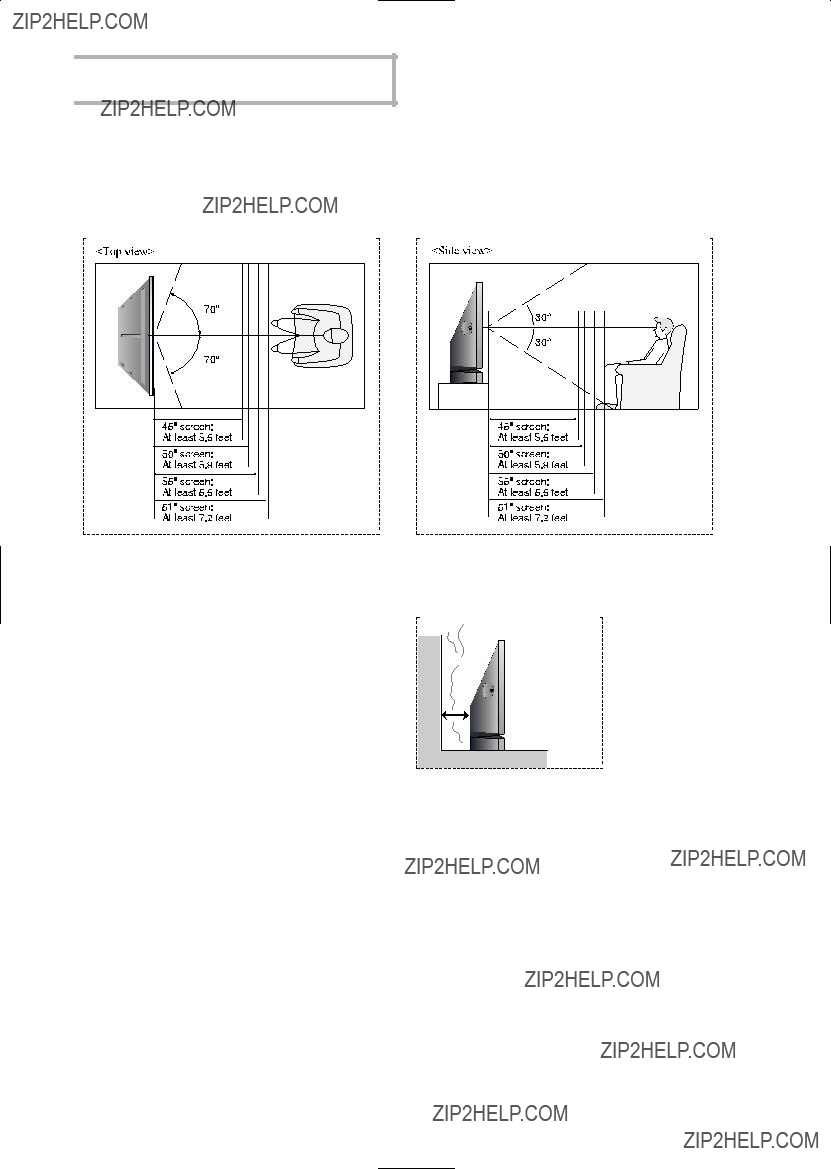
 Your New Wide TV
Your New Wide TV
Viewing Position
To optimize your viewing comfort, please follow the guidelines below for viewing distance. If viewing for an extended period of time, sit as far back from the screen as possible.
When installing the product, make sure to keep it away from the wall (more than 10cm/4 inches) for ventilation purposes.
??? Poor ventilation may cause an increase in the internal temperature of the product, resulting in a shortened component life and degraded performance.
 English - 10
English - 10

List of Features
Your TV was designed and engineered using the latest technology. It is a
???
???
???Automatic timer to turn the TV on and off at any time you choose
???Adjustable picture and sound settings and the ability to memorize your favorite settings
???Automatic channel tuning for up to 181 channels
???A special filter to reduce or eliminate reception problems
???Fine tuning control for the sharpest picture possible
???A
???
???A special sleep timer
???
???Widescreen TV with adjustable image size
???
???My Color Control Mode for corresponding with your color style
???Color weakness Mode
???Digital Input (HDMI/DVI IN) jack
???Digital Audio Output (OPTICAL) jack
???AV network system (Anynet) that enables you to easily control Samsung
???CableCARD slot
???
???TV Guide On Screen???
Accessories
Once you have unpacked your TV, check to make sure that you have all the parts shown here. If any piece is missing or broken, call your dealer.
Remote Control
English - 11 

 Your New Wide TV
Your New Wide TV
Right side buttons
The buttons on the right side panel control your TV???s basic features, including the
Press to switch between viewing TV programs and signals from connected components.
Press to see the
Press to raise or lower the volume and to select items when using the
Press to change channels and move between items on the
Press to activate (or change) a particular item.
Side Panel Jacks
Use the right side panel jacks to connect a component that is used only occasionally (a camcorder or video game, for example).
Connect the video signal from a camcorder or video game.
Connect the audio signal from a camcorder or video game.
Connect an
 English - 12
English - 12
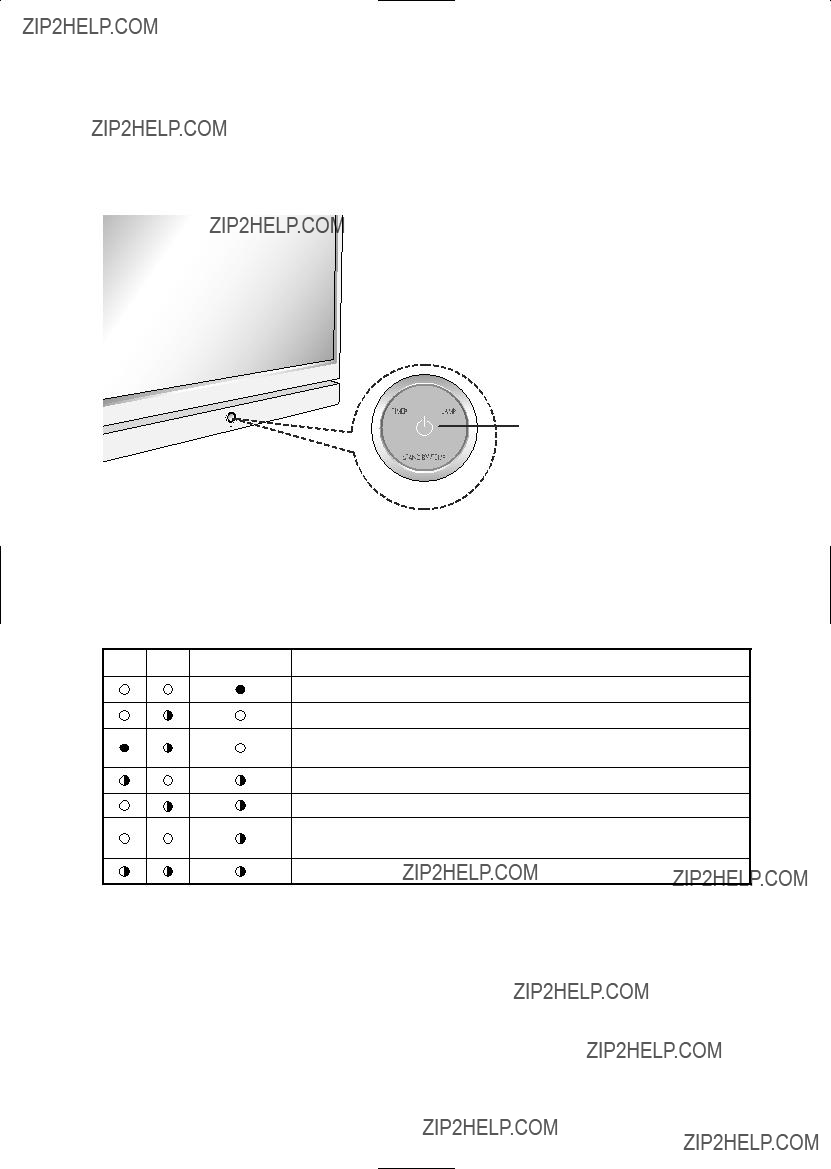
Front Panel LED Indicators
The three lights on the front panel indicate the status of your TV.
POWER
Press to turn the TV on and off.

 Remote Control Sensor
Remote Control Sensor
Aim the remote control towards this spot on the TV.
Indicator Light Key
 : Light is On
: Light is On
 : Light is Blinking
: Light is Blinking  : Light is Off
: Light is Off
Standby state.
The picture will automatically appear in about 15 seconds.
Auto Timer ON/OFF has been set and the set will automatically be turned on in about 25 seconds.
A cooling fan inside the set is not operating normally.
Lamp cover on the rear of the set is not properly shut.
Check if the ventilation hole on the rear of the set is blocked, because if the inner temperature is too high, the power will shut off.
Lamp may be defective. Please contact a certified technician.
???It takes about 30 seconds for the TV to warm up, so normal brightness may not appear immediately.
???The TV has a fan to keep the inside lamp from overheating. You???ll occasionally hear it working.
English - 13 

 Your New Wide TV
Your New Wide TV
Rear Panel Jacks
Use the rear panel jacks to connect components such as a VCR. You can connect different components such as VCRs,
??ANTENNA terminals
Two independent cables or antennas can be connected to
these terminals. Use ???ANT 1 IN (CABLE)??? and ???ANT 2 IN (AIR)??? terminals to receive a signal from VHF/UHF antennas or your cable system. (Refer to pages 18~20)
??SERVICE
This jack is for software upgrades.
??
Connects an
??DVI (Digital Video Interface) AUDIO INPUT jacks
Connect to the digital audio output jacks of a device with DVI output. (Refer to page 25)
??PC AUDIO INPUT jacks
Connect these to the audio output jacks on your PC. (Refer to page 122)
??VIDEO/AUDIO INPUT jacks
Connect video/audio signals from external sources, such as VCR or DVD players. (Refer to page 24)
???VIDEO/AUDIO OUTPUT jacks
Sends video/audio signals from the TV to an external source, such as a VCR. These jacks are available only in RF, Video and
???COMPONENT1, 2 jacks (Y, PB, PR, L, R)
Use these jacks to connect the component video/audio signals from a DVD player or a
???DIGITAL AUDIO OUT (OPTICAL) jack
Connect to a Digital Audio Component. (Refer to page 27)
??
Connect the IR controller cable to the
??Anynet
Please refer to the Anynet Owner???s Instruction. This jack is for connecting to other Samsung
???PC VIDEO INPUT jack
Connect these to the video output jack on your PC.
??HDMI (High Definition Multimedia Interface)/ DVI INPUT jack
Connect to the HDMI jack of a device with HDMI output.
These inputs can also be used as a DVI connection with separate analog audio inputs. An optional HDMI/DVI cable will be necessary to make this connection. When using the optional HDMI/DVI adapter, the DVI analog audio inputs on your TV allow you to receive left and right audio from your DVI device. (Refer to pages 25~26)
??
Connect to external IEEE1394 digital products such as digital VCRs and camcorders.
Two jacks are provided for this purpose, which allow for a high degree of flexibility for connecting your
??CableCARDTM
Insert the CableCARD into the slot. (Refer to page 22)
 English - 14
English - 14
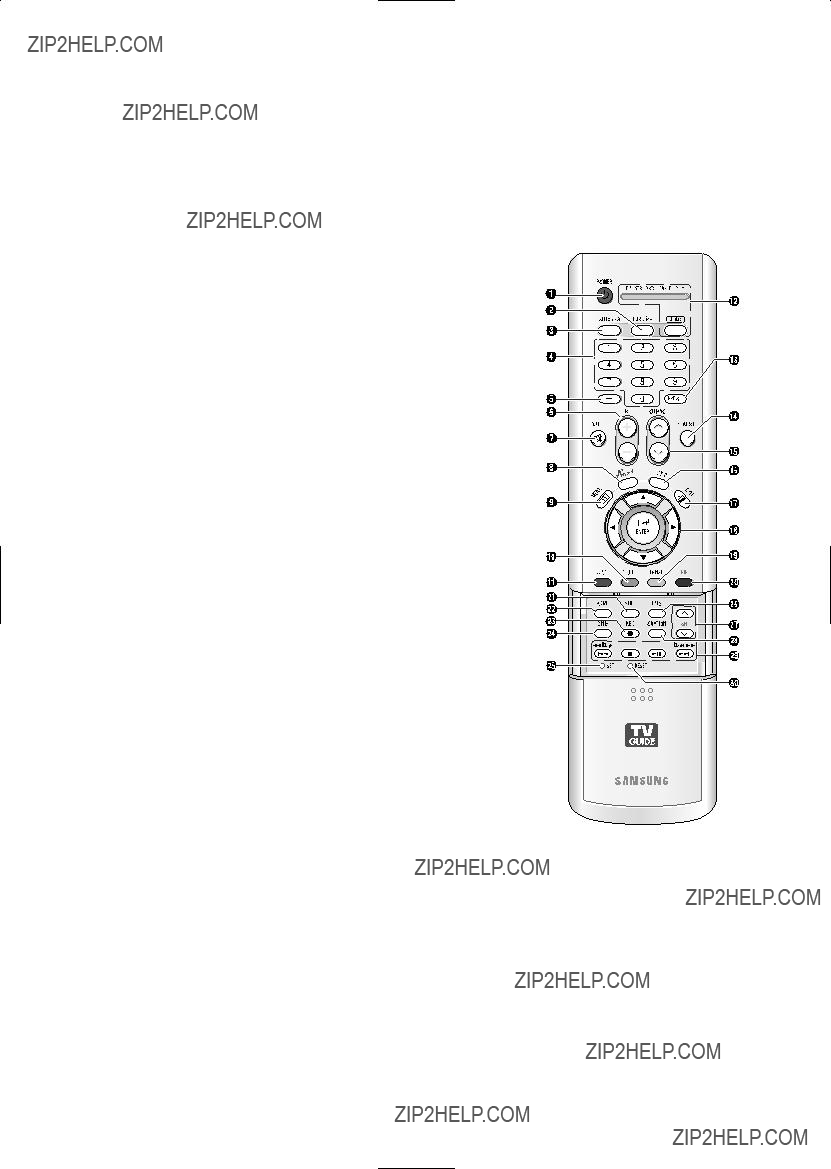
Remote Control
You can use the remote control up to about 23 feet from the TV. When using the remote control, always point it directly at the TV. You can also use your remote control to operate your VCR, Cable box, DVD player or some Samsung
1.POWER
Turns the TV on and off.
2.TV Guide
Press to display the TV Guide On ScreenTM lnteractive Program Guide (IPG).
(Refer to the TV Guide On ScreenTM manual and TV Guide On ScreenTM Quick Setup Sheet for further information on
18.???, ???, ??, ???, ENTER
Press to select highlight up, down, left, or right. While using the
19.
Runs the
3.ANTENNA
Press to select ???AIR??? or ???CABLE???.
4.CHANNEL NUMBER
Press to directly tune to a particular channel.
5.-
Press to select additional channels (digital and analog) being broadcast by the same station. For example, to select channel
6.VOL +, VOL -
Press to increase or decrease the volume.
7.MUTE
Press to mute the TV sound.
8.Anynet
Runs the Anynet view functions and sets up Anynet devices.
9.MENU
Displays the main
10.CH.LIST
Displays the channel list.
11.FAV.CH (Favorite Channel)
Press to switch between your favorite channels.
12.MODE
Selects a target device to be controlled by the Samsung remote control (i.e., TV, STB, VCR, CABLE, or DVD).
13.
Tunes to the previous channel.
14.SOURCE
Press to display all of the available video sources (i.e., TV,
15.CH/PAGE  /
/
Press to change channels. Moves from one set of screen information to the next in the TV Guide On ScreenTM.
16.INFO
Press to display information on the TV screen.
17.EXIT
Press to exit the menu.
20.PIP (Picture In Picture)
Displays the available channels in sequence. (These buttons change channels in the PIP window only.)
When in the TV Guide On ScreenTM, toggles the state between locked and unlocked in the Video Window.
21.STILL
Press to pause the current screen.
22.P.SIZE
Press to change the screen size.
23.REC
Records a program in the TV Guide On ScreenTM.
24.DNIe (Digital Natural Image engine)
Activates DNIe Demo mode.
25.SET
Used during set up of this remote control, so that it will work compatibly with other devices (some Samsung
26.MTS (Multichannel Television Stereo)
Press to choose Stereo, Mono or SAP (Secondary Audio Program).
27.PIP Controls
CH /
/ : Press to display the available channels in sequence. (These buttons change channels in the PIP window only.)
: Press to display the available channels in sequence. (These buttons change channels in the PIP window only.)
28.CAPTION
Controls the caption decoder.
29.VCR/DVD Controls
Controls VCR or DVD functions: Rewind, Stop, Play/Pause, Fast Forward.
30.RESET
If your remote control is not functioning properly, take out the batteries and press the reset button for about 2~3 seconds.
NOTE
???If you are using a cable box, the TV Guide On ScreenTM system needs to be able to change channels on your cable box to download program listings when the TV is not in use.
Please connect the supplied
(Refer to the TV Guide On ScreenTM Quick Setup Sheet for further information on
English - 15 

 Your New Wide TV
Your New Wide TV
Installing Batteries in the Remote Control
With normal use, the batteries in the remote control should last about a year. If you notice a performance degradation while using the remote, the batteries may need to be replaced. Make sure you replace both batteries and do not mix old and new batteries in the remote control. If you won???t be using the remote control for a long time, remove the batteries and store them in a cool dry place.
Slide the back cover all the way out to open 1 the battery compartment of the remote control.
Install two AAA size batteries. Make sure to 2 match the ???+??? and
with the diagram inside the compartment.
3 Slide the cover back into place.
NOTE
??? Do not mix battery types, i.e, alkaline and manganese.
 English - 16
English - 16

Connections

 Connections
Connections
Connecting VHF and UHF Antennas
If you do not have a cable system, you will need to connect an antenna to your TV.
Antennas with
If your antenna looks like this: 


 it has
it has
Plug the antenna lead into 1 the ANT 2 IN (AIR) on the
rear panel of your TV.
 English - 18
English - 18
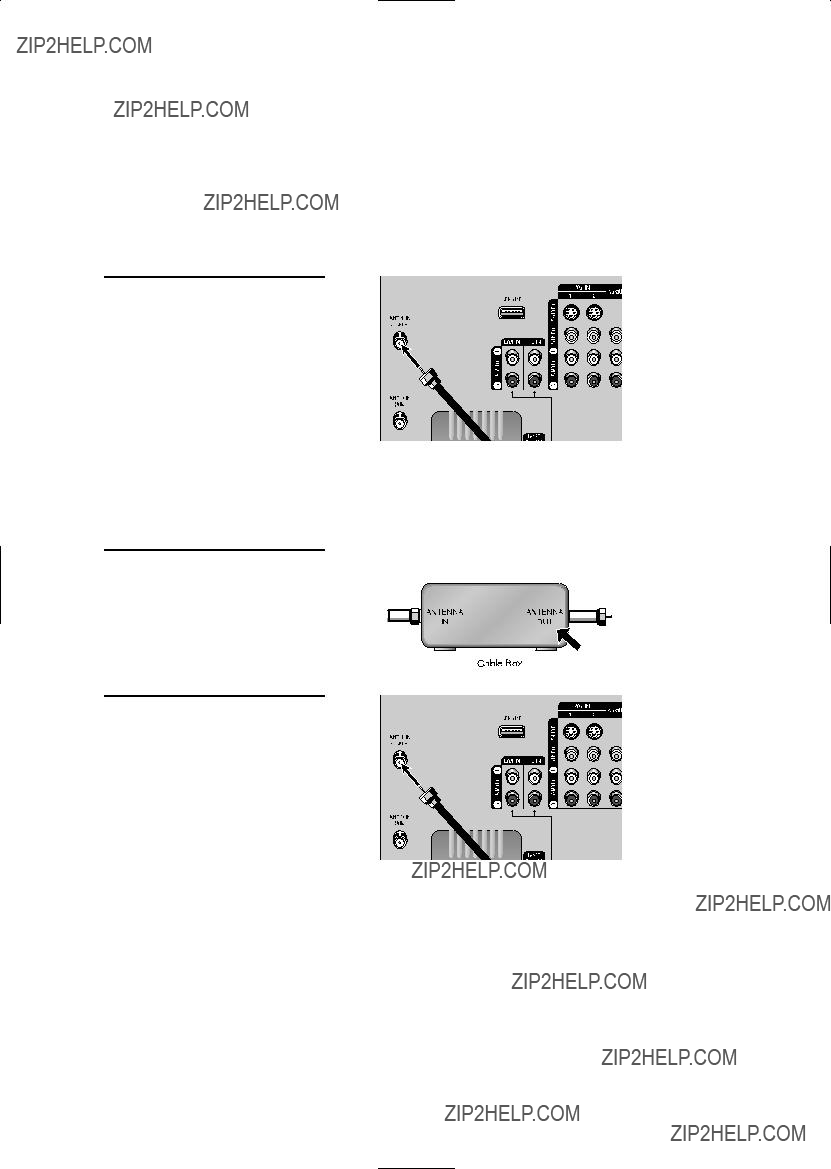
Connecting Cable TV
You can connect different cable systems to your TV, including cable without a Cable box, and cable with a Cable box that descrambles some or all channels.
Cable without a Cable Box
Plug the incoming cable into 1 the ANT 1 IN (CABLE) on the
rear panel of your TV.
Cable with a Cable Box that Descrambles All Channels
Find the cable connected to 1 the ANTENNA OUT
terminal on your Cable box. This terminal might be labeled ???ANT OUT???, ???VHF OUT??? or simply ???OUT???.
Connect the other end 2 of the cable to the
???ANT 1 IN (CABLE)??? terminal on the rear panel of your TV.
English - 19 
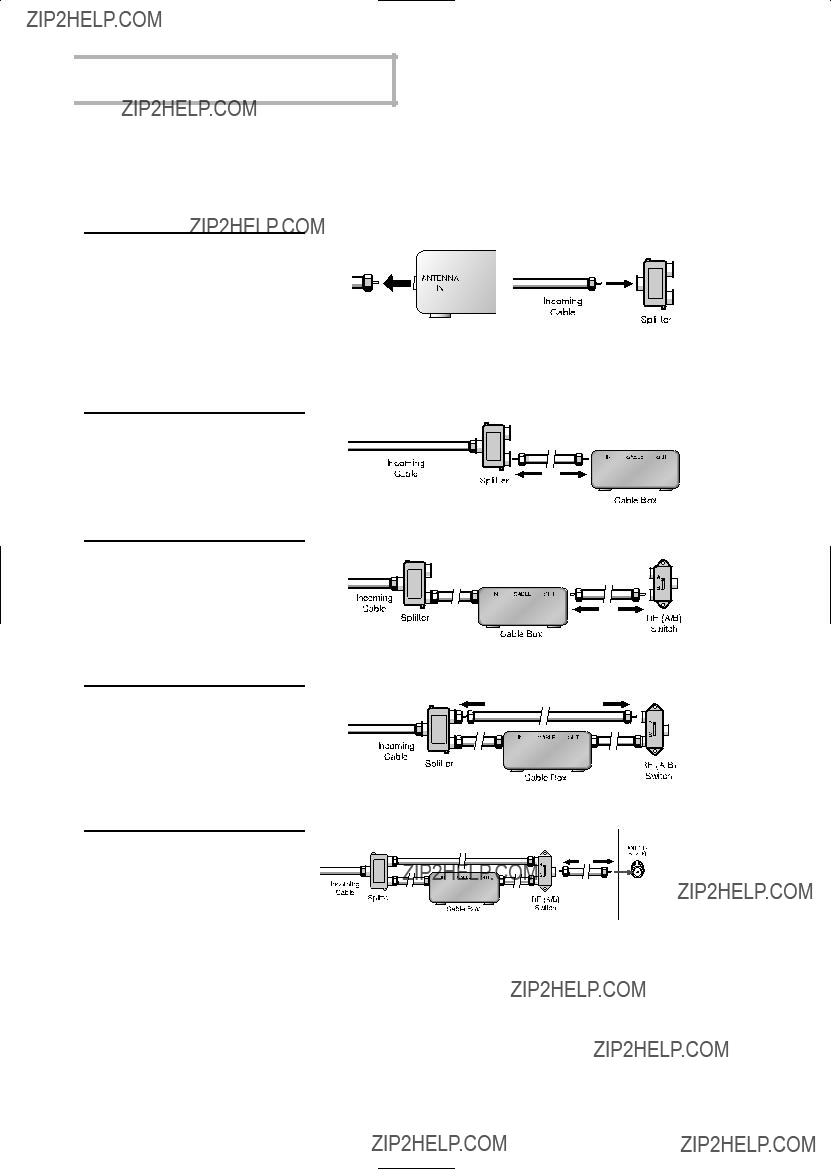
 Connections
Connections
Cable with a Cable Box that Descrambles Some (But Not All) Channels
To complete this connection you will need a
Find and disconnect the 1 cable that is connected to
the ANTENNA IN terminal of your Splitter.
This terminal might be labeled ???ANT IN???, ???VHF IN??? or simply, ???IN???. Connect this cable to a
Connect a coaxial cable 2 between an OUT terminal
of the splitter and the IN terminal of the Cable box.
Connect a coaxial cable
3 between the ANTENNA OUT terminal of the Cable box and the
Connect a coaxial cable 4 between the other OUT
terminal of the Cable box and the
Connect the last coaxial 5 cable between the OUT terminal of the RF (A/B)
switch and the ANT 1 IN (CABLE) on the TV.
After you???ve made this connection, set the A/B switch to the ???A??? position for normal viewing.
Set the A/B switch to the ???B??? position to view scrambled channels. (When you set the A/B switch to ???B???, you will need to tune your
 English - 20
English - 20
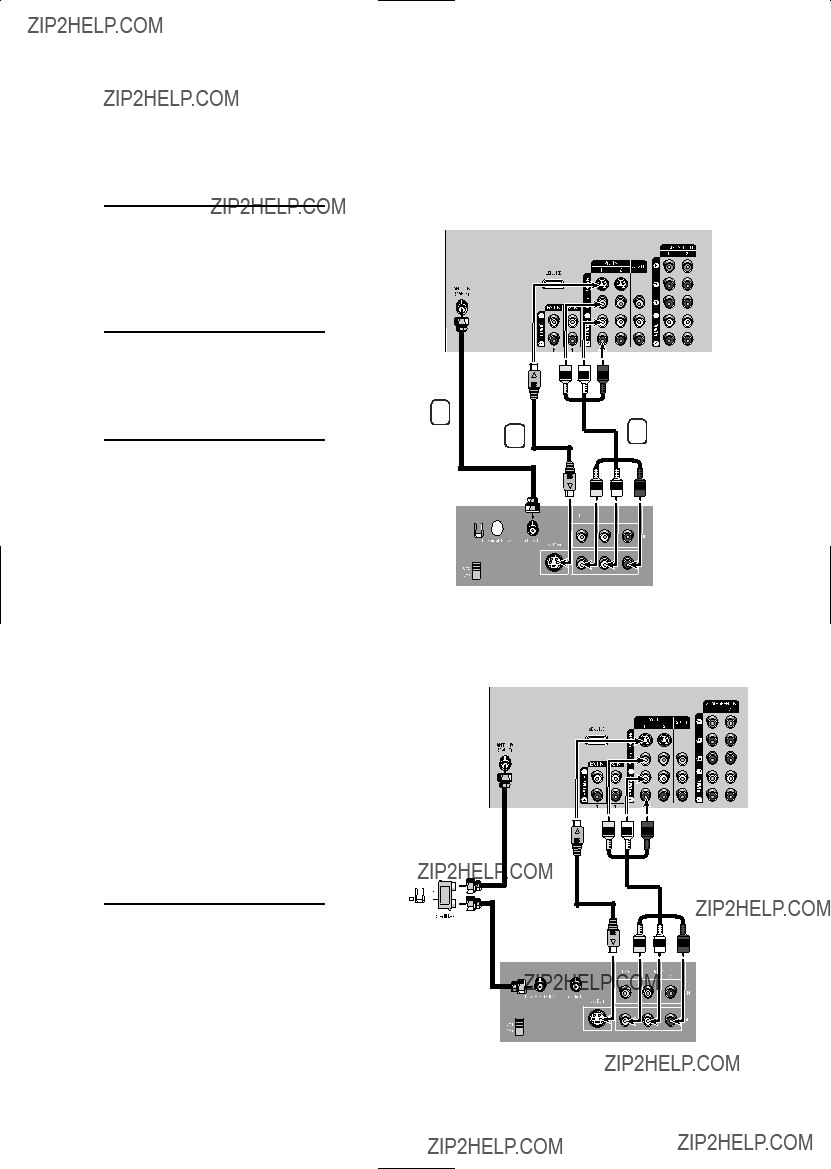
Connecting a VCR
Connecting a VCR to the Video or
Connect the Video/Audio 1 cables between the VIDEO
or
Connect a coaxial cable 2 between the Antenna out
terminal (i.e., ???OUT to TV???) on the VCR and the ANT 1 IN (CABLE) on the TV.
Connect a video cable 3 between the
jack on the TV and the
NOTES
???For better video, use an
???Please be sure to match the color coded input terminals and cable jacks.
???When connecting the VCR and turning it on, there may be some degradation of the visual quality with noise on the TV screen.
Press the TV/VCR button on the VCR remote control first to switch the VCR to the TV mode and you can tune the TV while the VCR is recording.
Alternate method
When changing the antenna connection, you do not need to press the TV/VCR button on the VCR remote control for using the recording function of the TV Guide On ScreenTM.
TV Rear Panel
2 










 3
3

 1
1 
Incoming
Cable or 




Antenna
Stereo VCR
TV Rear Panel
Incoming
Cable or 





Antenna
Stereo VCR
English - 21 
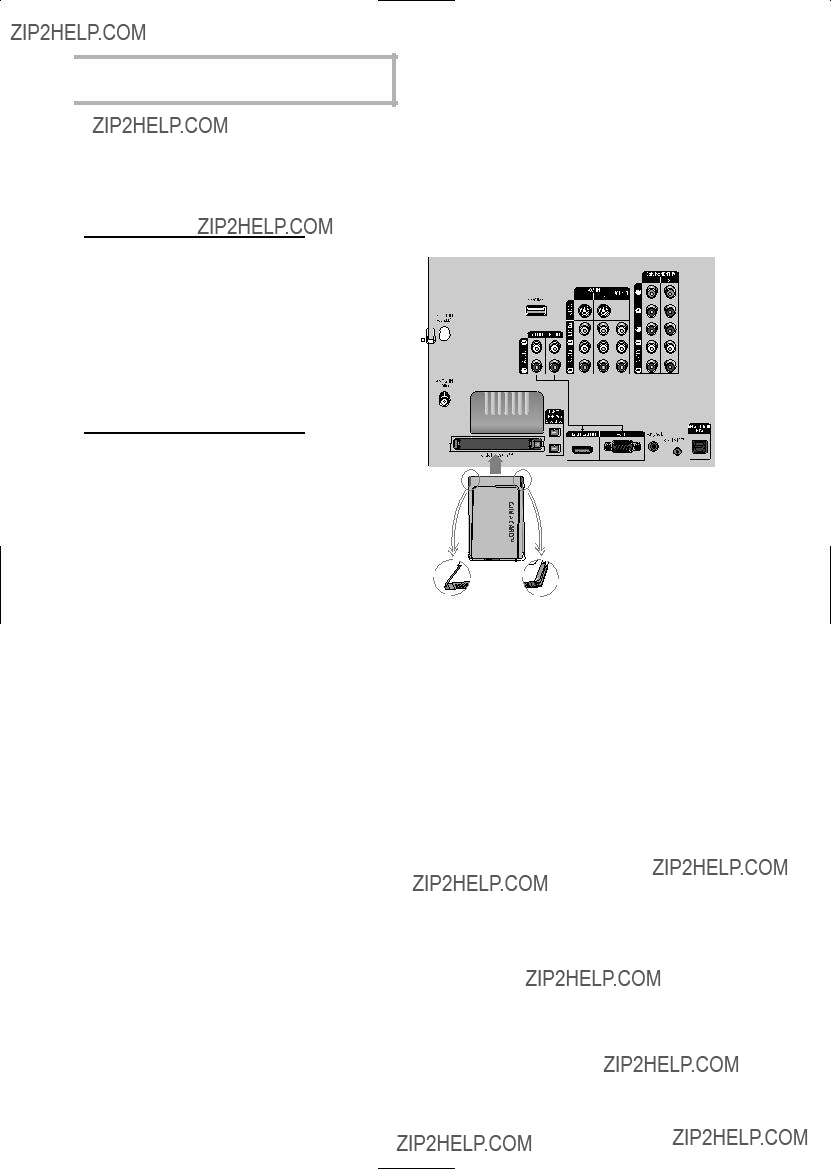
 Connections
Connections
Connecting CableCARD
You must obtain a CableCARD from a local cable service provider.
Insert the CableCARD into 1 the ???CableCARD??? slot and
the message ???CableCARDTM Inserted??? is displayed on the screen. If the channel information does not already exist, the message ???Updating Channel List??? is displayed during channel information configuration.
When channel information 2 configuration is finished,
the message ???Updating Completed??? is displayed. It indicates that the channel list is now updated.
TV Rear Panel
Incoming
Cable or 




Antenna
Please insert the card as shown.
 English - 22
English - 22

Connecting a Camcorder
The side panel jacks on your TV make it easy to connect a Camcorder to your TV. You can use your camcorder to view tapes without using a VCR.
Locate the A/V output jacks 1 on the camcorder. They are usually found on the side or
back of the camcorder.
Connect a set of audio 2 cables between the AUDIO
IN jacks on the TV and the AUDIO OUT jacks on the camcorder. If you have a mono Camcorder, connect L(mono) to the Camcorder audio out using only one audio cable.
Connect a video cable 3 between the VIDEO IN (or
1
Camcorder
Output Jacks
2
English - 23 
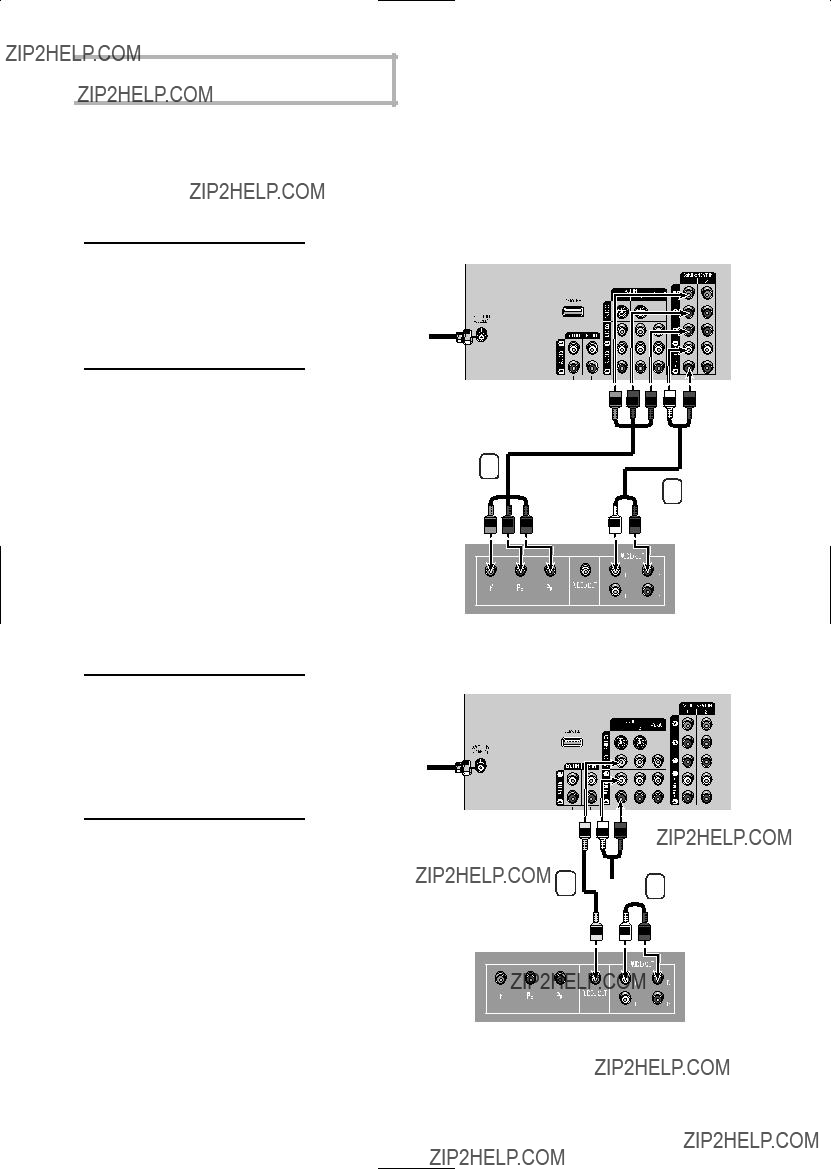
 Connections
Connections
Connecting a DVD Player
The rear panel jacks on your TV make it easy to connect a DVD player to your TV.
Connecting to Y, PB, PR
Connect a set of audio 1 cables between the
COMPONENT (1 or 2) AUDIO (L, R) IN jacks on the TV and the AUDIO OUT jacks on the DVD player.
To enable Component video 2 viewing, connect a set of
video cables between the COMPONENT (1 or 2) VIDEO (Y, PB, PR) IN jacks on the TV and VIDEO (Y/PB/PR or Y/CB/CR) OUT jacks on the DVD player.
TV Rear Panel
Incoming
Cable or
Antenna
2
1
DVD Player
Connecting to Audio and Video Jacks
Connect a set of audio 1 cables between the AUDIO
IN (1 or 2) jacks on the TV and the AUDIO OUT jacks on the DVD player.
Connect a video cable 2 between the VIDEO IN (1
or 2) jack on the TV and the VIDEO OUT jack on the DVD player.
NOTE
???For an explanation of Component video, see your DVD player???s owner???s manual.
TV Rear Panel
Incoming
Cable or
Antenna
2




 1
1





DVD Player
 English - 24
English - 24
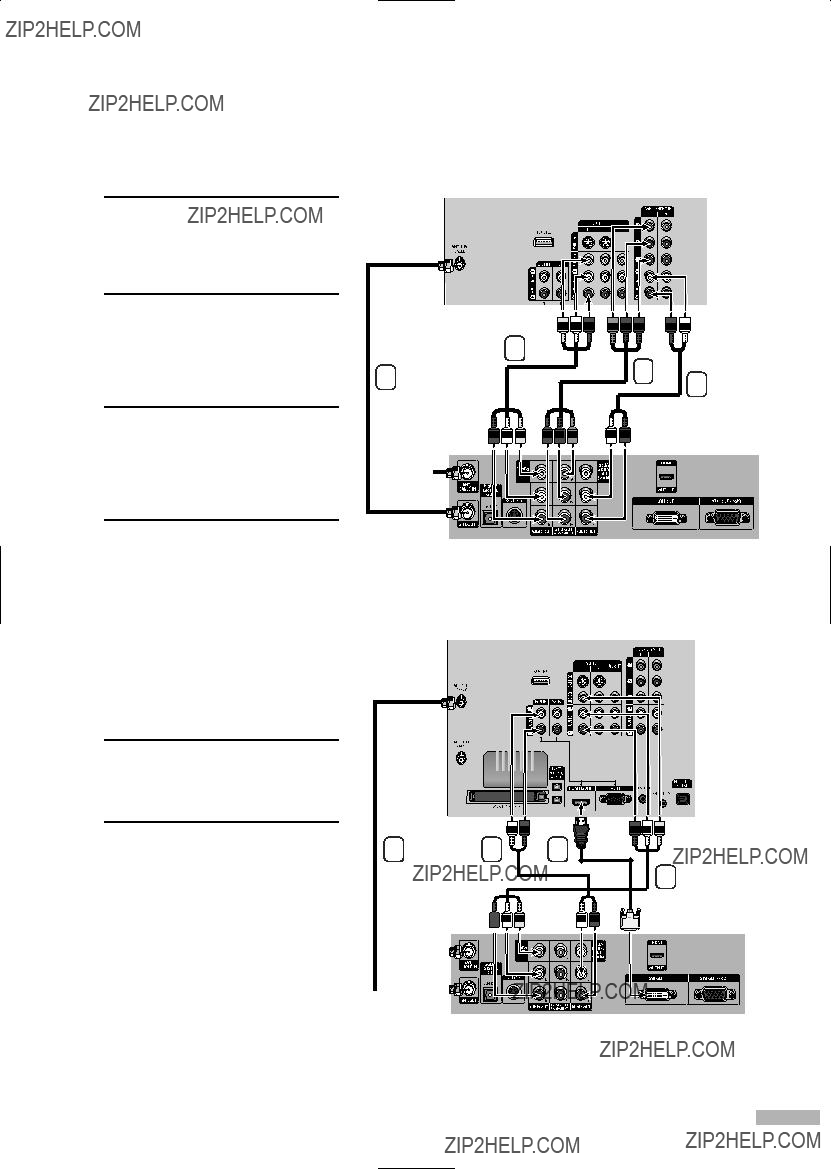
Connecting a DTV
Connect a set of audio cables 1 between the COMPONENT (1 or 2) AUDIO (L, R) IN jacks on
the TV and the AUDIO OUT jacks on the
Connect a coaxial cable 4 between the Antenna out
terminal (i.e., ???ANT.OUT???) on the
Connect a set of audio cables 1 between the DVI AUDIO (L, R)
IN jacks on the TV and the AUDIO OUT jacks on the
Connect an HDMI/DVI video 2 cable between the HDMI/DVI IN jack on the TV and the DVI OUT jack on the
 2
2
DTV
2
1
3
DTV
NOTES
???For an explanation of Component video, see your
???Requires a Cable Converter.
???To use the TV Guide On ScreenTM, you have to connect both the Video/Audio cable
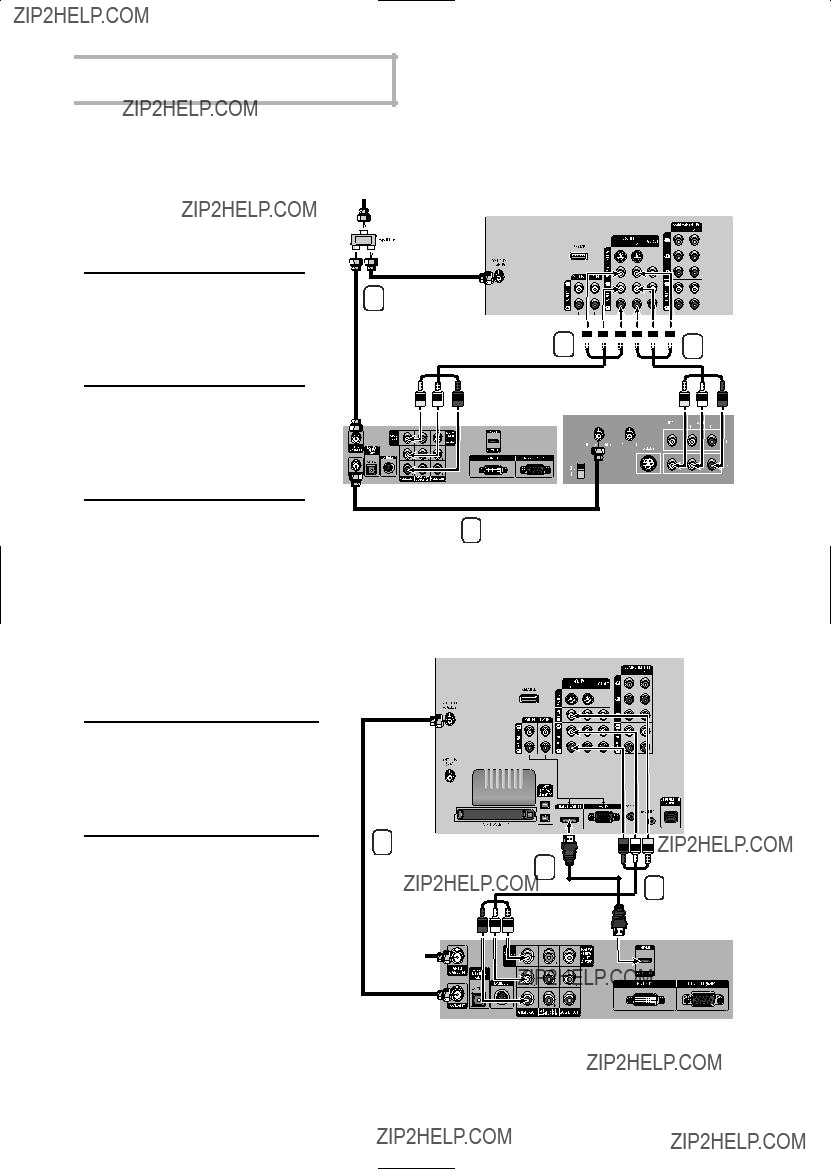
 Connections
Connections
Connecting a VCR and DTV
Connect the Video/Audio 1 cables between the VIDEO
or
Connect the Video/Audio 2 cables between the VIDEO
or
Use the coaxial cable to 3 connect between the splitter
and the ANT 1 IN (CABLE) on the TV and between the splitter and the ANT IN on the
Connect a coaxial cable 4 between the Antenna in
terminal on the VCR and the Antenna out terminal on the
Incoming Cable or Antenna
TV Rear Panel
3









 2
2









 1
1
4
Connecting to HDMI (High Definition Multimedia Interface)
???To use the TV Guide On ScreenTM, you have to connect both the Video/Audio cable and the
 English - 26
English - 26
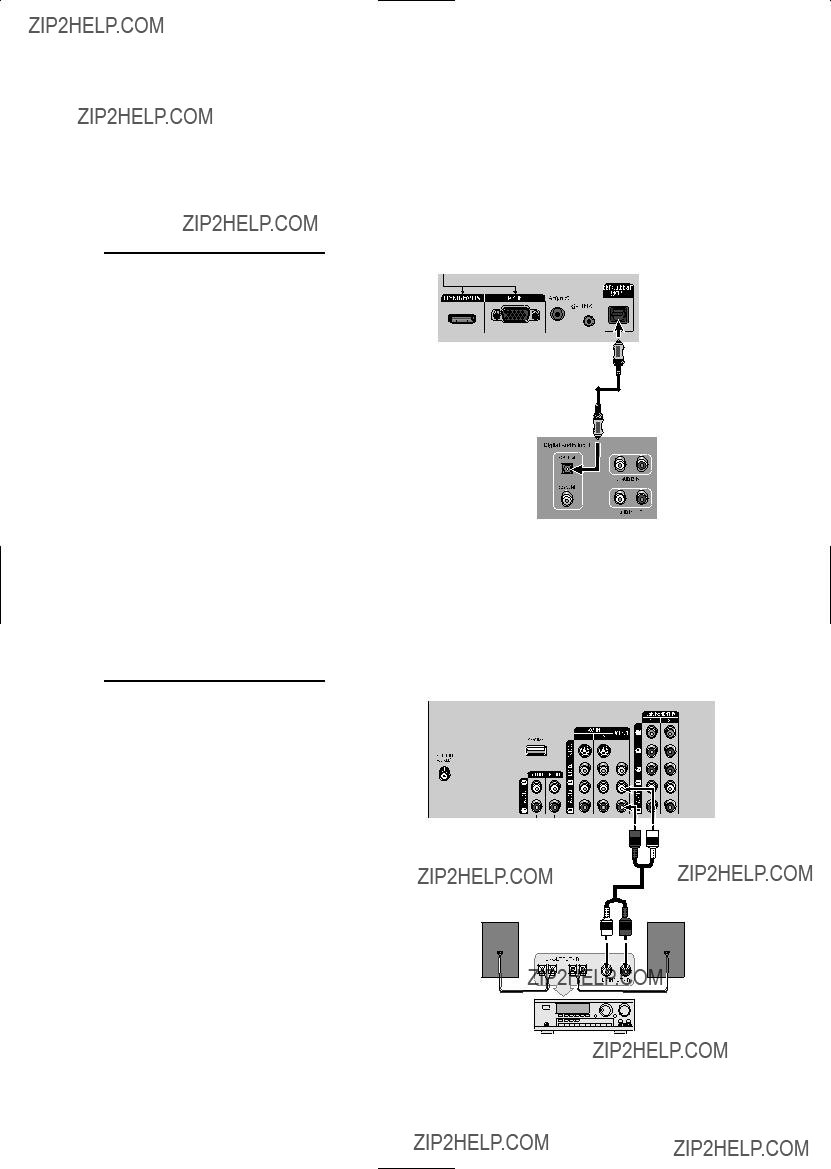
Connecting a Digital Audio System
There are many types of digital audio systems on the market today.
A simplified illustration of an audio system is shown below. For more information, see your audio system owner???s manual.
Connecting to an Analog Amplifier
English - 27 

SAMSUNG

Operation

 Operation
Operation
Turning the TV On and Off
Press the POWER button on the remote control.
You can also use the POWER button on the front panel.
Viewing the Menus and
The
Viewing the Menus
Viewing the Display
Press the INFO button on the remote control.
The TV displays the current channel, the status of certain picture and sound settings and the current time.
The information displayed varies according to the selected source.
Cable 3
No Time Information
 English - 30
English - 30
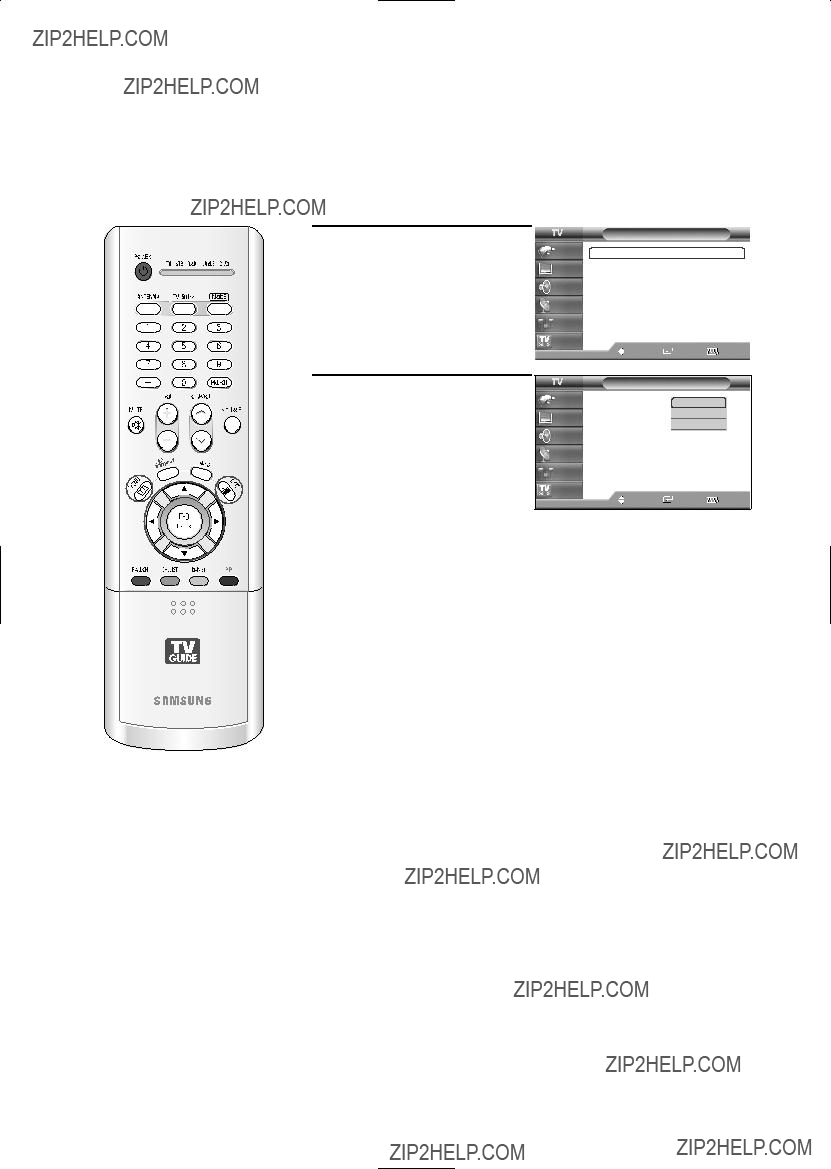
Selecting a Menu Language
1 Press the MENU button. Press the ??? or ??? button to select ???Setup???, then press the ENTER button.
2 Press the ENTER button to select ???Language???.
Press the ??? or ??? button to select ???English???, ???Espa??ol??? or ???Fran??ais???, then press the ENTER button.
Press the EXIT button to exit.
English - 31 

 Operation
Operation
Memorizing the Channels
Your TV can memorize and store all of the available channels for both  and CH/PAGE
and CH/PAGE  buttons to scan through the channels. This eliminates the need to change channels by entering the channel digits. There are three steps for memorizing channels: selecting a broadcast source, memorizing the channels (automatic) and adding and deleting channels (manual).
buttons to scan through the channels. This eliminates the need to change channels by entering the channel digits. There are three steps for memorizing channels: selecting a broadcast source, memorizing the channels (automatic) and adding and deleting channels (manual).
Selecting the Video Signal Source
Before your television can begin memorizing the available channels, you must specify the type of signal source that is connected to the TV (i.e., an antenna or cable system).
1 Press the MENU button. Press the ??? or ??? button to select ???Channel???, then press the ENTER button.
Channel
2 Press the ENTER button to select ???Antenna???.
Press the ??? or ??? button to select ???Air??? or ???Cable???, then press the ENTER button.
3 Press the ??? or ??? button to select ???Auto Program???, then press the ENTER button.
Channel
Channel
NOTE
???All available DTV and analog channels are automatically stored in memory.
 English - 32
English - 32
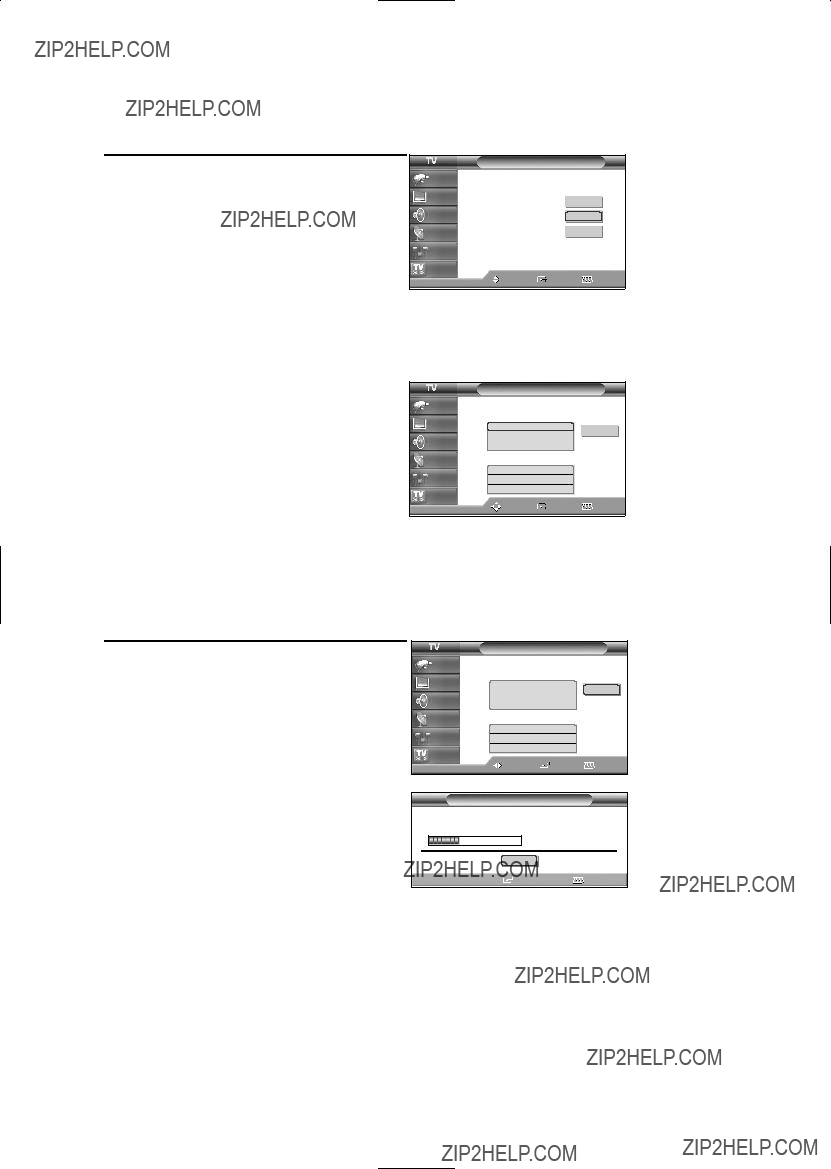
4 Press the ??? or ??? button to select the Antenna connection, then press the ENTER button.
???Air : ???Air??? antenna signal
Cable : ???Cable??? antenna signal
Air+Cable : ???Air??? and ???Cable??? antenna signals
???If the CableCARD is inserted into the ???CableCARD??? slot on the rear panel, ???Cable??? and ???Air+Cable??? are not available.
Input
Picture
Sound
Channel
Setup
Listings
Auto Program
Select the antennas to memorize.
When selecting Cable TV system: Press the ENTER button to start the auto
program. By default, the cable TV system is set to ???STD???.
If you want to select another type of cable system, press the ?? button and use the ??? or ??? button to select Analog or Digital ???STD???, ???HRC??? or ???IRC???. Press the ENTER button.
Auto Program
???STD, HRC and IRC identify various types of cable TV systems. Contact your local cable company to identify the type of cable system that exists in your particular area.
At this point the signal source has been selected.
5 Press the ??? button to select ???Start???, then press the ENTER button to start the auto program. The TV begins memorizing all available stations. Press the ENTER button at any time to interrupt the memorization process.
Press the EXIT button to exit.
Auto Program
???The TV must be connected to an antenna in order to receive digital TV signals. Even if a particular channel is deleted from the memory, you can always tune to that channel directly by using the number buttons on the remote control.
Auto Program
Auto Program in progress
English - 33 
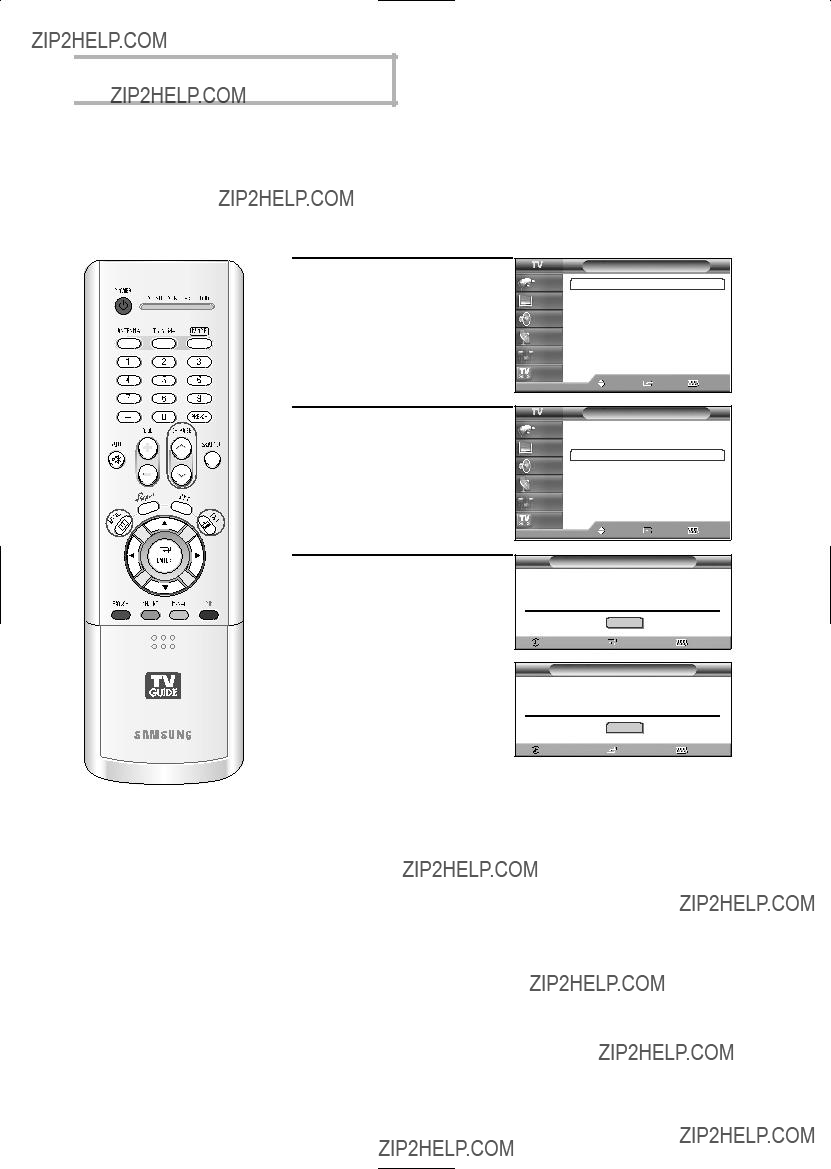
 Operation
Operation
Adding and Erasing Channels
You can add channels that were not memorized (or delete unwanted channels from memory).
1 Press the MENU button. Press the ??? or ??? button to select ???Channel???, then press the ENTER button.
2 Press the ??? or ??? button to select ???Add/Delete???, then press the ENTER button.
Channel
Channel
3 Repeatedly pressing the ENTER button will alternate between add channel and delete channel.
Press the CH/PAGE  or CH/PAGE
or CH/PAGE  button to switch to the appropriate channel, then repeat above.
button to switch to the appropriate channel, then repeat above.
Press the EXIT button to exit.
Add/Delete
Add/Delete
 English - 34
English - 34
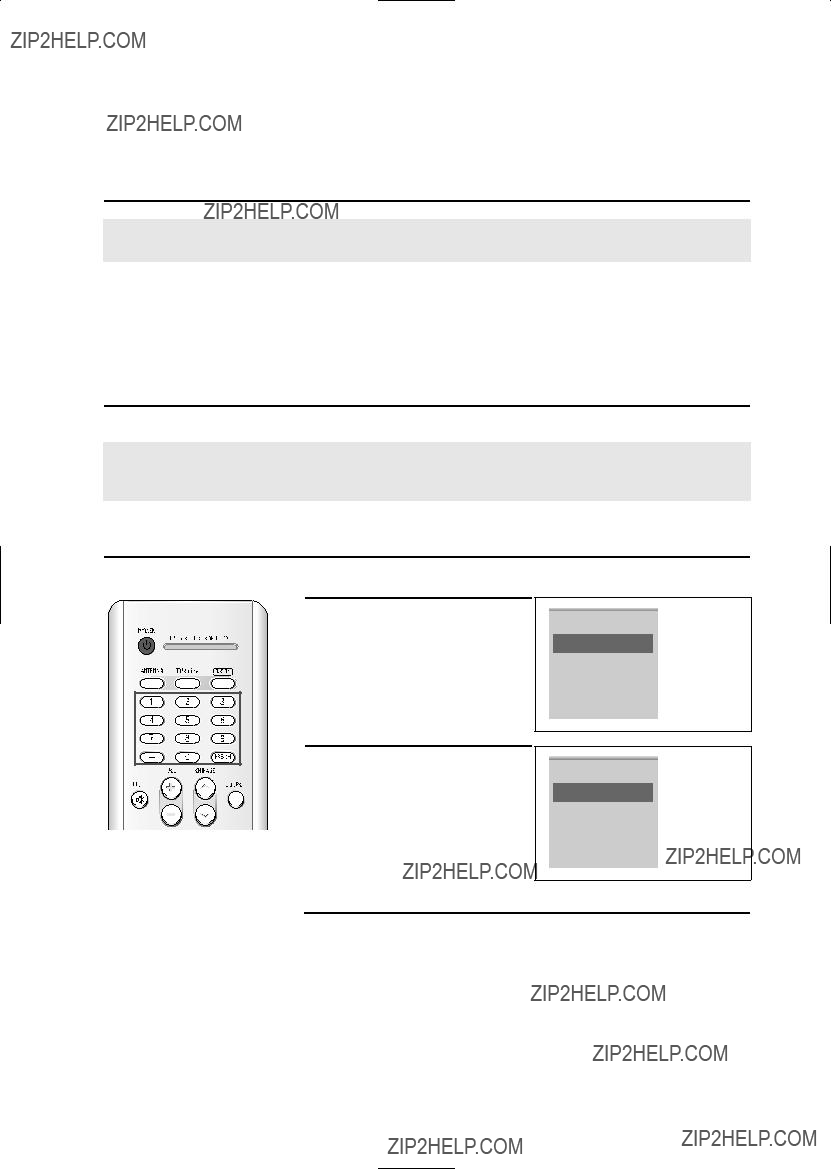
Changing Channels
Using the Channel Buttons
Press the CH/PAGE  or CH/PAGE
or CH/PAGE  button to change channels.
button to change channels.
When you press the CH/PAGE  or CH/PAGE
or CH/PAGE  button, the TV changes channels in sequence. You will see all the channels that the TV has memorized.
button, the TV changes channels in sequence. You will see all the channels that the TV has memorized.
(The TV must have memorized at least three channels.)
You will not see channels that were either erased or not memorized.
Using the Number Buttons
Use the number buttons to quickly switch to any channel.
Press the number buttons to go directly to a channel. For example, to select channel 27, press ???2,??? then ???7.??? The TV will change channels when you press the second number.
Using the
The
English - 35 
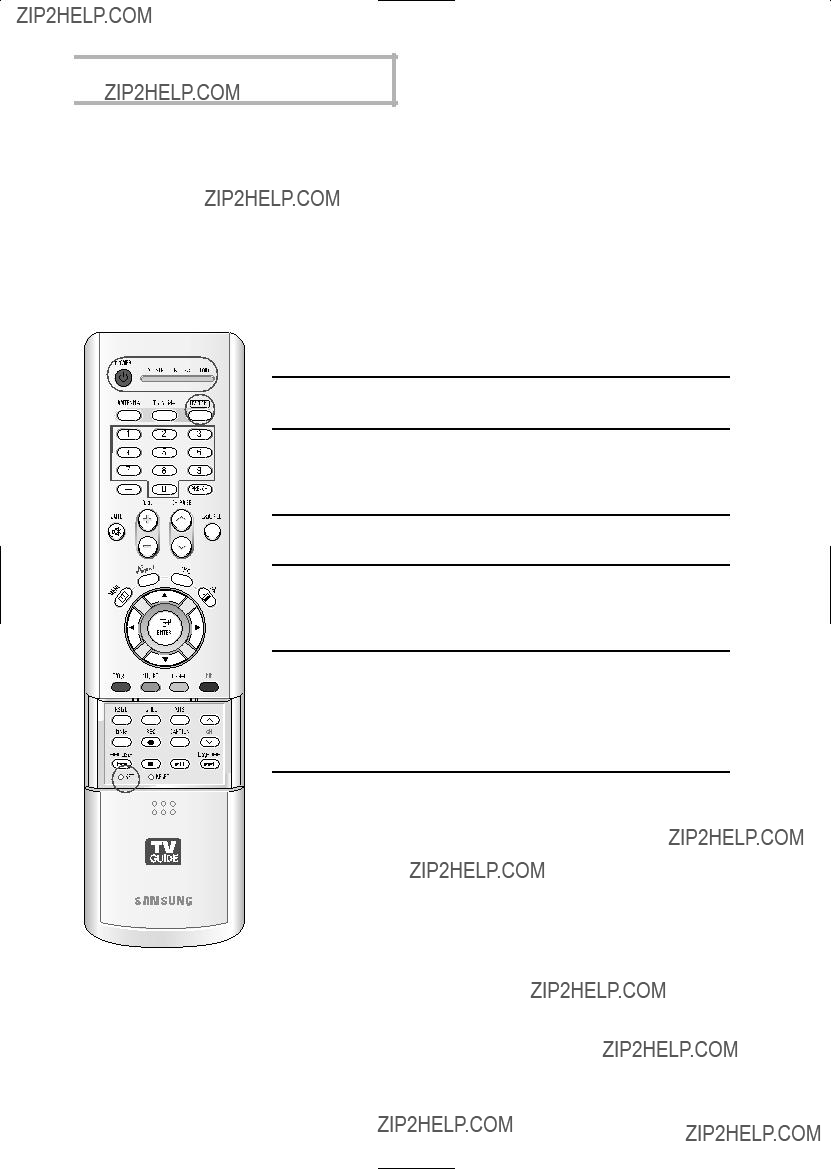
 Operation
Operation
Customizing Your Remote Control
Your TV comes equipped with a universal remote control. In addition to controlling the TV, the universal remote control can also operate a VCR, Cable box, DVD, and some Samsung
6 Once your remote control is set up, press the MODE button any time you want to use the remote to operate your VCR (Cable box or DVD player).
NOTES
???When your remote is in the TV mode, the VCR (or DVD player) control buttons (REW, STOP, PLAY/PAUSE, and FF) will still operate your VCR (or DVD player).
???When your remote control is in the STB, VCR, CABLE, or DVD mode, the volume buttons still control your TV???s volume.
 English - 36
English - 36
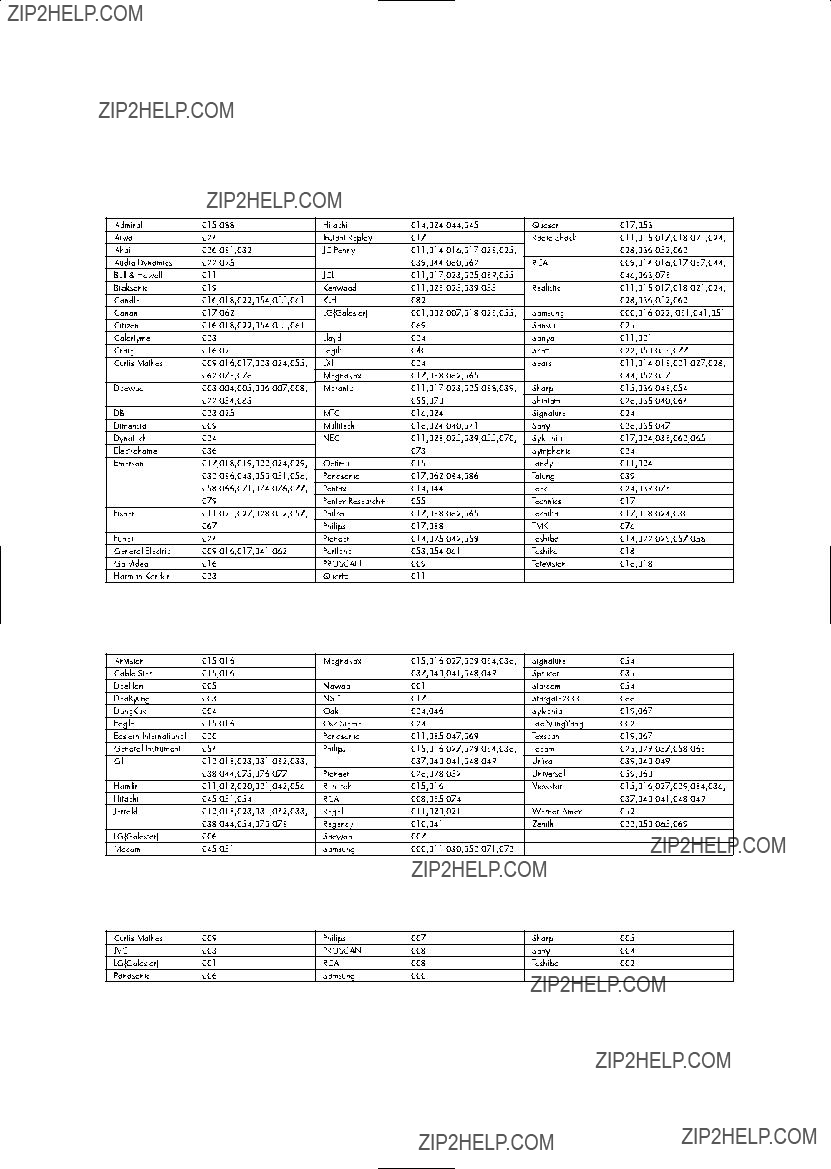
Remote Control Codes
VCR Codes
Cable Box Codes
DVD Codes
English - 37 
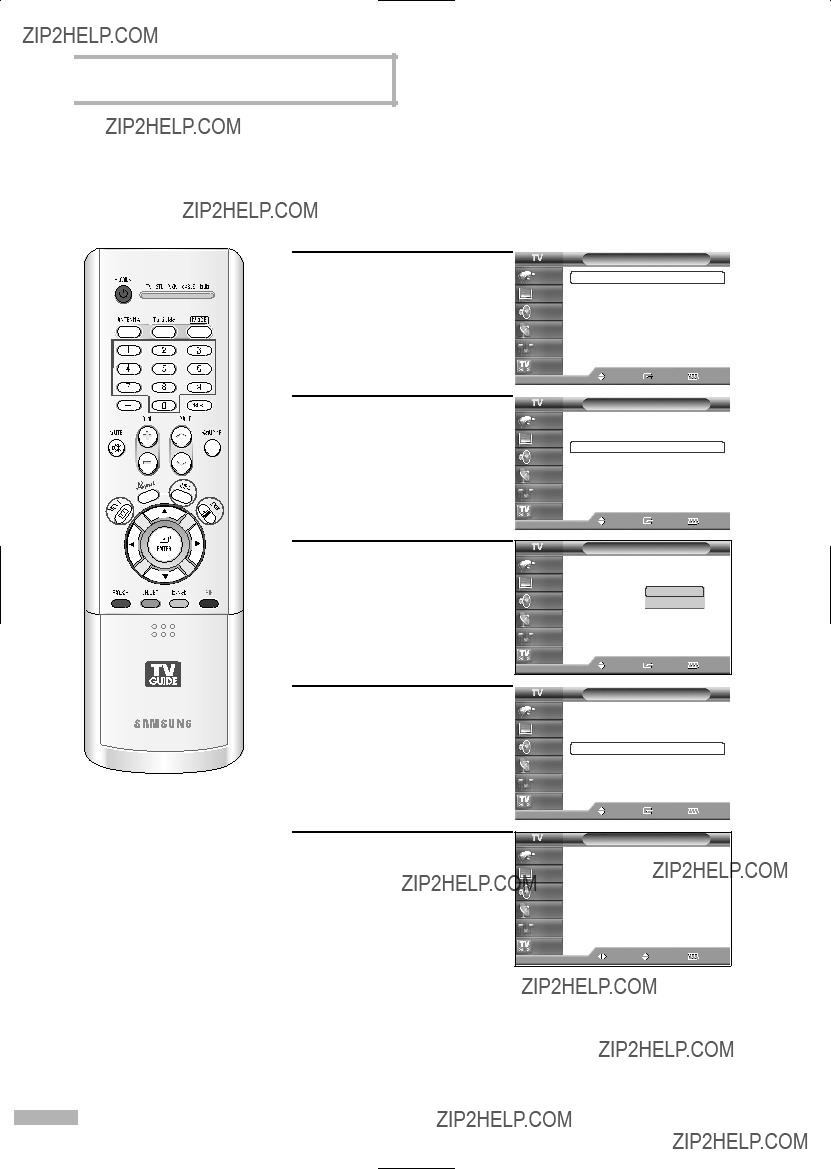
 Operation
Operation
Setting the Clock
Setting the clock is necessary in order to use the various timer features of the TV. Also, you can check the time while watching the TV. (Just press the INFO button.)
Option 1: Setting the Clock Manually
1 Press the MENU button. Press the ??? or ??? button to select ???Setup???, then press the ENTER button.
2 Press the ??? or ??? button to select ???Time???, then press the ENTER button.
Press the ENTER button to select ???Clock???.
3 Press the ENTER button to select ???Clock Mode???. Press the ??? or ??? button to select ???Manual???, then press the ENTER button.
4 Press the ??? or ??? button to select ???Clock Set???, then press the ENTER button.
???You can set the month, day, year, hour and minute
directly by pressing the number buttons on the remote control.
Press the EXIT button to exit.
NOTE
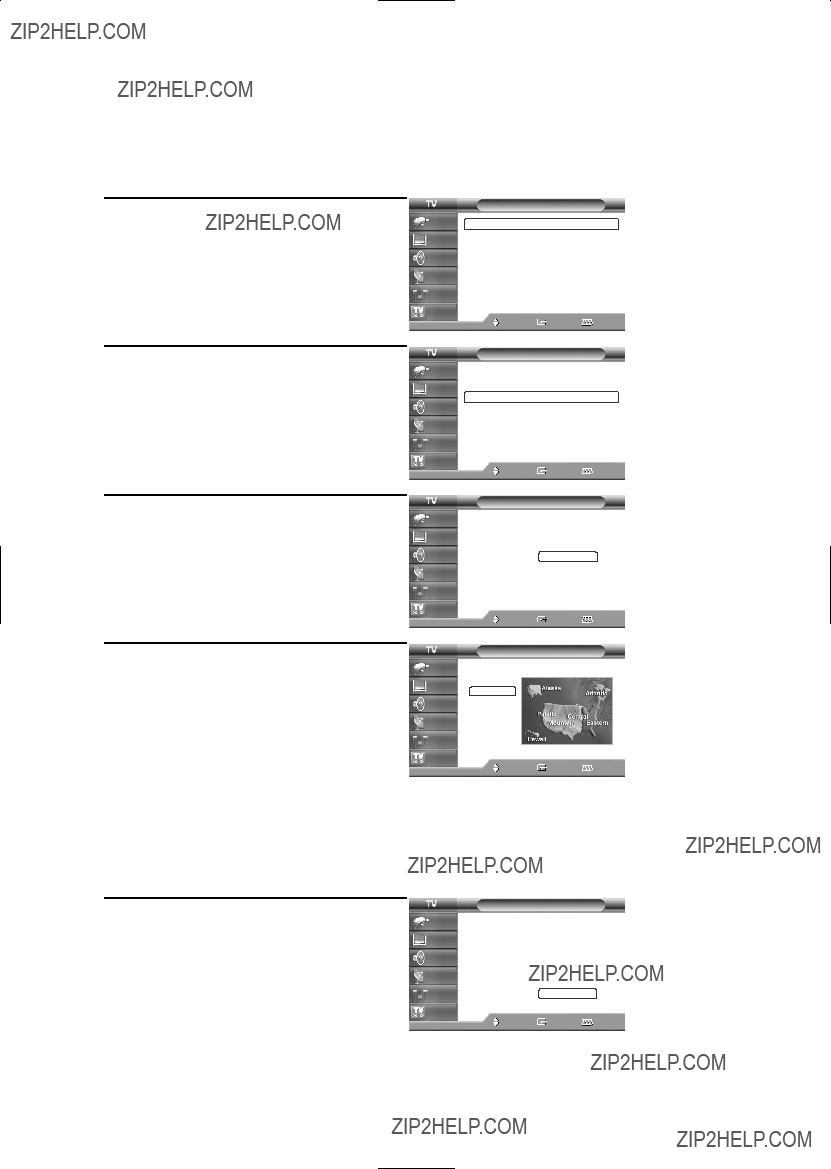
Option 2: Setting the Clock Automatically
The Clock can be set automatically if you are receiving a digital signal.
1 Press the MENU button.
Press the ??? or ??? button to select ???Setup???, then press the ENTER button.
2 Press the ??? or ??? button to select ???Time???, then press the ENTER button.
Press the ENTER button to select ???Clock???.
3 Press the ENTER button to select ???Clock Mode???.
Press the ??? or ??? button to select ???Auto???, then press the ENTER button.
4 Press the ??? or ??? button to select ???Time Zone???, then press the ENTER button.
Press the ??? or ??? button to highlight the time zone for your local area (and to move the highlight to the appropriate time zone on the map of the United States), then press the ENTER button.
???When you set up Auto Time, the set time may not be correct depending on the broadcasting station and signal. If there is a difference between the real time and set time, please set the time manually.
5 Press the ??? or ??? button to select ???DST???(Daylight Saving Time), then press the ENTER button.
Press the ??? or ??? button to select ???Yes??? or ???No???, then press the ENTER button.
Press the EXIT button to exit.
English - 39 

 Operation
Operation
Setting the On/Off Timer
1 Press the MENU button. Press the ??? or ??? button to select ???Setup???, then press the ENTER button.
2 Press the ??? or ??? button to select ???Time???, then press the ENTER button.
Press the ??? or ??? button to select ???On Timer???, then press the ENTER button. Press the ??? or ??? button to adjust ???Hour???, then press the ??? button to move to the next step.
Set other items using the same method as above.
To activate On Timer with the setting entered, set Activation to ???Yes??? by pressing ??? or ??? button.
On Timer
???You can set the hour, minute, channel, and volume directly by pressing the number buttons on the remote control.
When finished, press the MENU button to return.
 English - 40
English - 40
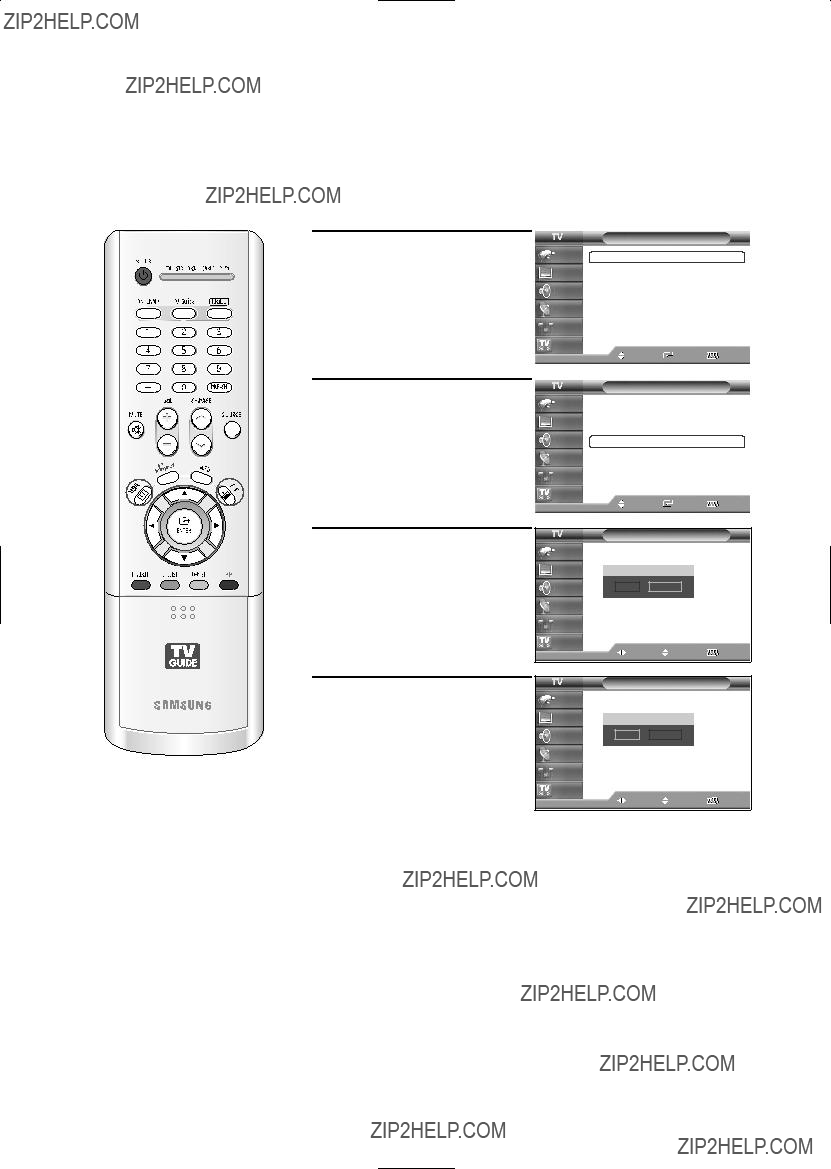
Setting the Sleep Timer
The sleep timer automatically shuts off the TV after a preset time (from 30 to 180 minutes).
1 Press the MENU button. Press the ??? or ??? button to select ???Setup???, then press the ENTER button.
2 Press the ??? or ??? button to select ???Time???, then press the ENTER button.
Press the ??? or ??? button to select ???Sleep Timer???, then press the ENTER button.
3 Press the ??? or ??? button to adjust ???Minute???.
Sleep Timer
4 Setting the Timer sets the Activation to ???Yes??? automatically.
Press the EXIT button to exit.
Sleep Timer
English - 41 

 Operation
Operation
Viewing an External Signal Source
Use the remote control to switch between viewing signals from connected equipment, such as a VCR, DVD,
Setting the Signal Source
1 Press the MENU button. Press the ENTER button to select ???Input???.
Input
???COMPONENT2???, ???PC???, or ???HDMI/DVI??? on the TV???s rear panel and ???AV3??? or
???HDMI input can be selected only when the external device is turned on and connected to the TV.
Alternate method
 English - 42
English - 42
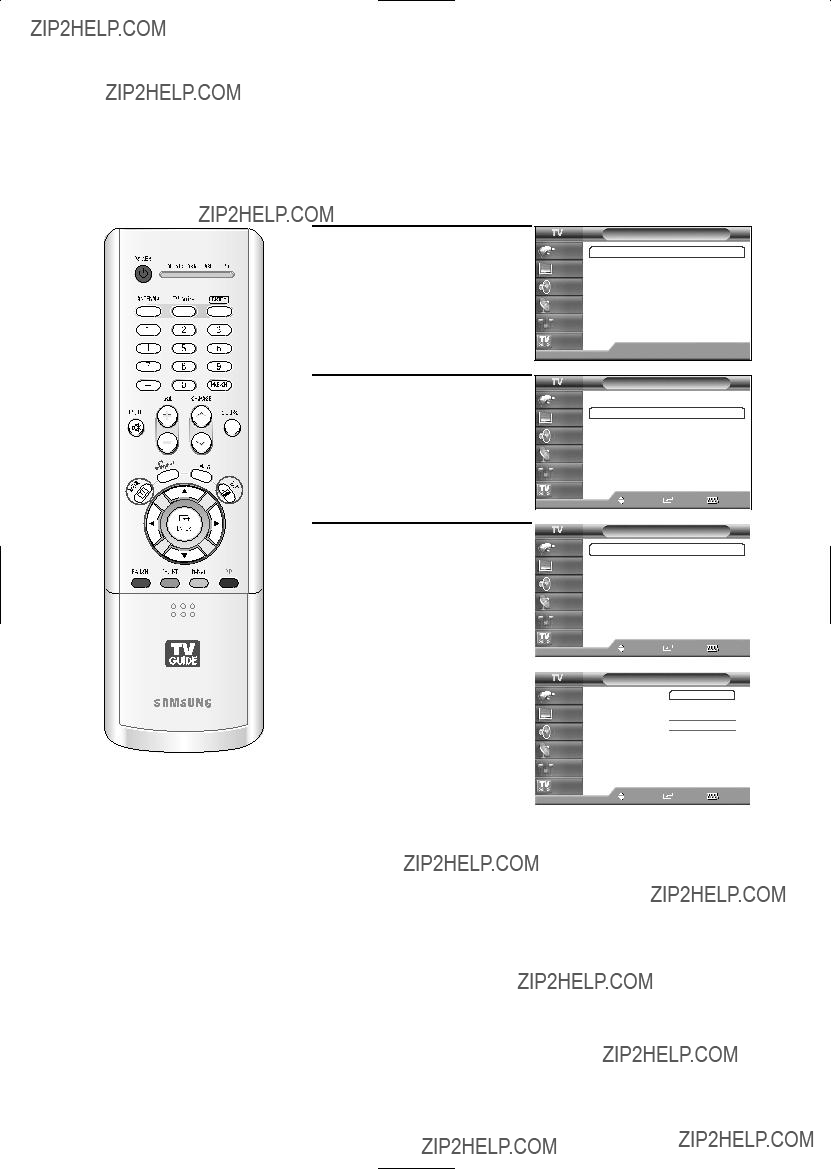
Assigning Names to External Input Mode
This feature enables you to name the input source you have connected.
1 Press the MENU button. Press the ENTER button to select ???Input???.
2 Press the ??? or ??? button to select ???Edit Name???, then press the ENTER button.
3 Press the ??? or ??? button to select a signal source to edit, then press the ENTER button.
Input
 Move
Move  Enter
Enter  Return
Return
Input
English - 43 

SAMSUNG

Channel Control
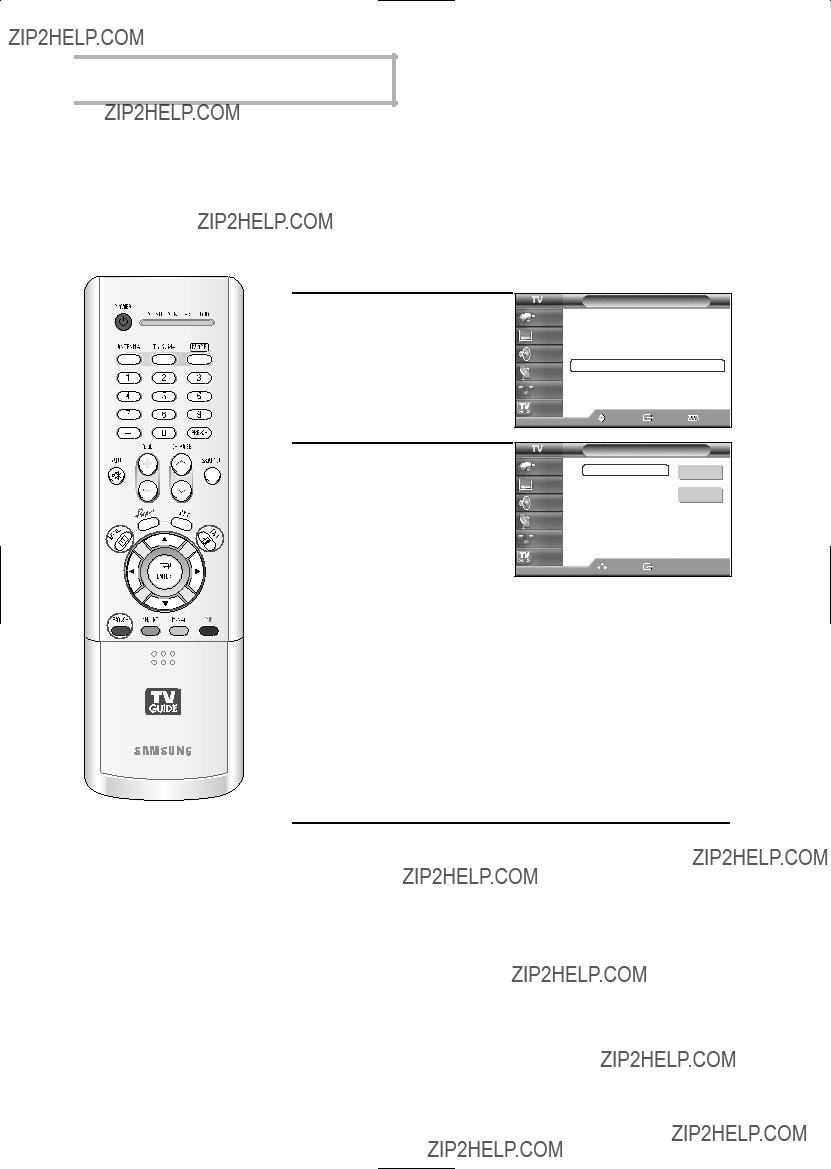
 Channel Control
Channel Control
Selecting Your Favorite Channels
You can store your favorite channels for each available input source (such as TV and CATV).
This allows you to quickly and easily find frequently watched channels by pressing the FAV.CH button on the remote control.
To Store Your Favorite Channels:
1 Press the MENU button. Press the ??? or ??? button to select ???Channel???, then press the ENTER button.
2 Press the ??? or ??? button to select ???Favorite Channels???, then press the ENTER button. Press the ??? or ??? button to select a channel, then press the ENTER button and a check mark will appear. Press the ENTER button again to deselect the selected channel and the check mark will disappear.
Press the EXIT button to exit.
Channel
Favorite Channels
???
Listings
 Move Enter
Move Enter  Return
Return
NOTES
???Only memorized channels can be set as Favorite channels.
???Select All : Press to select all channels.
???Clear All : Press to clear all channels.
To View Your Favorite Channels:
Press the FAV.CH button repeatedly to jump from one favorite channel to another.
 English - 46
English - 46

Viewing the Channel Lists
You can display a list of all channels or your favorite channels.
1 Press the MENU button. Press the ??? or ??? button to select ???Channel???, then press the ENTER button.
2 Press the ??? or ??? button to select ???Channel List???, then press the ENTER button.
3 Press the ??? or ??? button to select ???All??? or ???Favorite???, then press the ENTER button.
To toggle between your favorite channels or all channels, use the Yellow button.
Press the CH/PAGE  or CH/PAGE
or CH/PAGE  button to display the previous or next channel list page.
button to display the previous or next channel list page.
Channel
Channel
Channel List
??? Yellow button : Press to toggle between your favorite channels or all channels.
Blue or EXIT button : Press to exit.
Alternate method
Press the CH.LIST button on the remote control to display a list of channels.
Channel List
English - 47 

 Channel Control
Channel Control
Adding and Erasing Channels
1 Press the MENU button. Press the ??? or ??? button to select ???Channel???, then press the ENTER button.
2 Press the ??? or ??? button to select ???Channel List???, then press the ENTER button.
3 Press the ??? or ??? button to select ???Edit???, then press the ENTER button.
4 Press the ??? or ??? button to change channels you want to add or delete.
Repeatedly pressing ENTER button will alternate between ???Add??? and ???Delete???.
Channel List
Press the CH/PAGE  or CH/PAGE
or CH/PAGE  button to display the previous or next channel list page.
button to display the previous or next channel list page.
???Red button : Press to add all channels of the channel list.
Green button : Press to delete all channels of the channel list.
Yellow button : Press to add favorite channels.
Blue or EXIT button : Press to exit.
 English - 48
English - 48
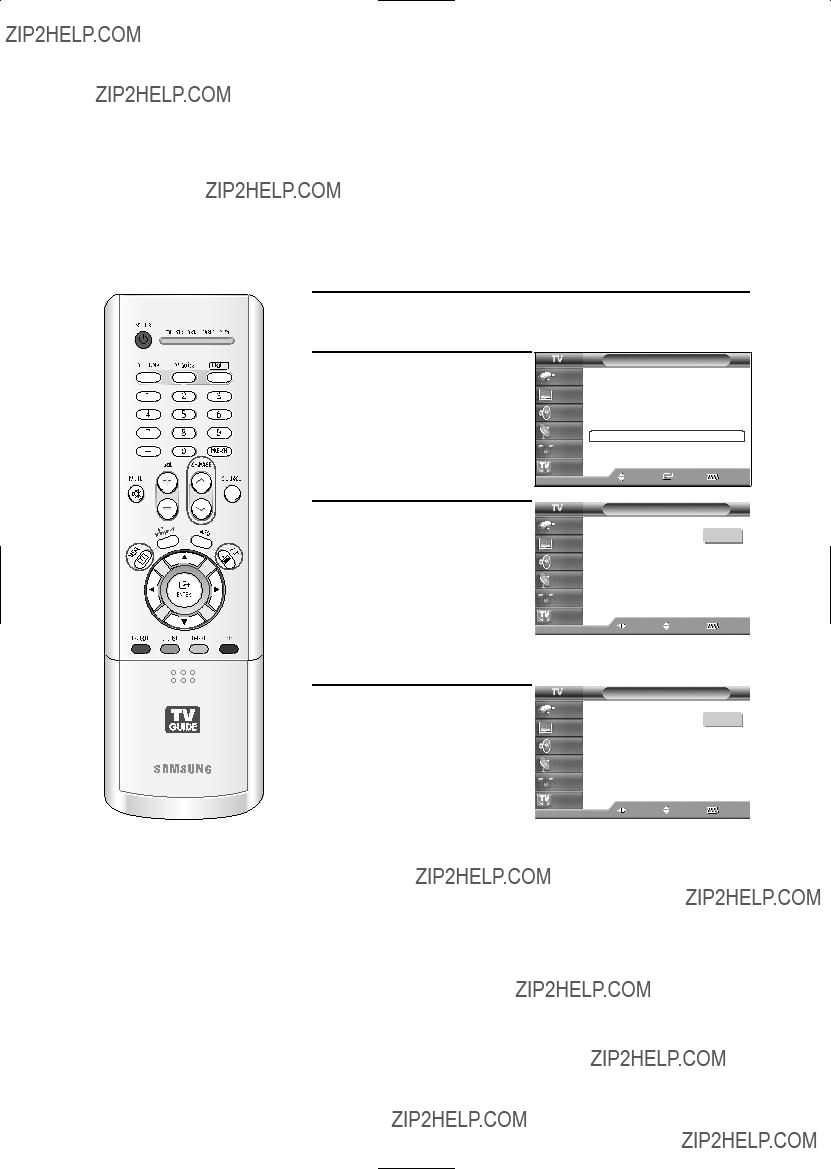
Labeling the Channels
Use this feature to assign an
1 Press the CH/PAGE  or CH/PAGE
or CH/PAGE  button to tune to the channel that will be labeled.
button to tune to the channel that will be labeled.
2 Press the MENU button. Press the ??? or ??? button to select ???Channel???, then press the ENTER button.
Press the ??? or ??? button to select ???Name???, then press the ENTER button.
3 Press the ??? or ??? button to move to the channel to be assigned to a new name, then press the ENTER button. Press the ??? or ??? button to select a letter, a number or a blank. (Results in this sequence: A...Z, 0...9, +,
Channel
NOTE
???If you add or delete a TV channel, the labeled channels will also be added or deleted.
4 Press the ??? button to switch to the next field, which will be selected.
Select a second letter or digit pressing ??? or ??? button, as above.
Repeat the process to select the last three digits.
When you have finished, press the ENTER button. To erase the assigned new name, select ???Clear??? by pressing the ?? or ??? button, then press the ENTER button.
Press the EXIT button to exit.
English - 49 

 Channel Control
Channel Control
LNA (Low Noise Amplifier)
If the TV is operating in a
1 Press the MENU button. Press the ??? or ??? button to select ???Channel???, then press the ENTER button.
2 Press the ??? or ??? button to select ???LNA???, then press the ENTER button.
3 Press the ??? or ??? button to select ???On??? or ???Off???, then press the ENTER button.
4 Press the EXIT button to exit.
Channel
Channel
NOTES
???LNA functions only when antenna is set to Air.
The settings will be stored separately in each channel.
???If the picture is noisy with the LNA set to On, select Off.
???The LNA setting must be made separately for each channel.
 English - 50
English - 50

Fine Tuning Analog Channels Analog
Use fine tuning to manually adjust a particular channel for optimal reception.
1 Press the MENU button. Press the ??? or ??? button to select ???Channel???, then press the ENTER button.
2 Press the ??? or ??? button to select ???Fine Tune???, then press the ENTER button.
Channel
Channel
3 Press the ?? or ??? button to adjust the fine tuning.
Fine Tune
NOTE
???Only analog TV channels can be fine tuned.
4 To store the fine tuning setting in the TV???s memory, press the ENTER button. To reset the fine tuning
setting, press the ??? button to select ???Reset???, then press the ENTER button.
5 Press the EXIT button to exit.
Fine Tune
Fine Tune
English - 51 

 Channel Control
Channel Control
Checking the
Unlike analog channels, which can vary in reception quality from ???snowy??? to clear, digital (HDTV) channels have either perfect reception quality or you will not receive them at all. So, unlike analog channels, you cannot fine tune a digital channel.
You can, however, adjust your antenna to improve the reception of available digital channels.
1 Press the MENU button. Press the ??? or ??? button to select ???Channel???, then press the ENTER button.
2 Press the ??? or ??? button to select ???Signal Strength???, then press the ENTER button.
Channel
Channel
If the signal strength meter indicates that the signal is weak, physically adjust your antenna to increase the signal strength. Continue to adjust the antenna until you find the best position with the strongest signal.
Press the EXIT button to exit.
Signal Strength
Input
Picture
Sound
Channel
SetupOK
Listings
Enter  Return
Return
 English - 52
English - 52
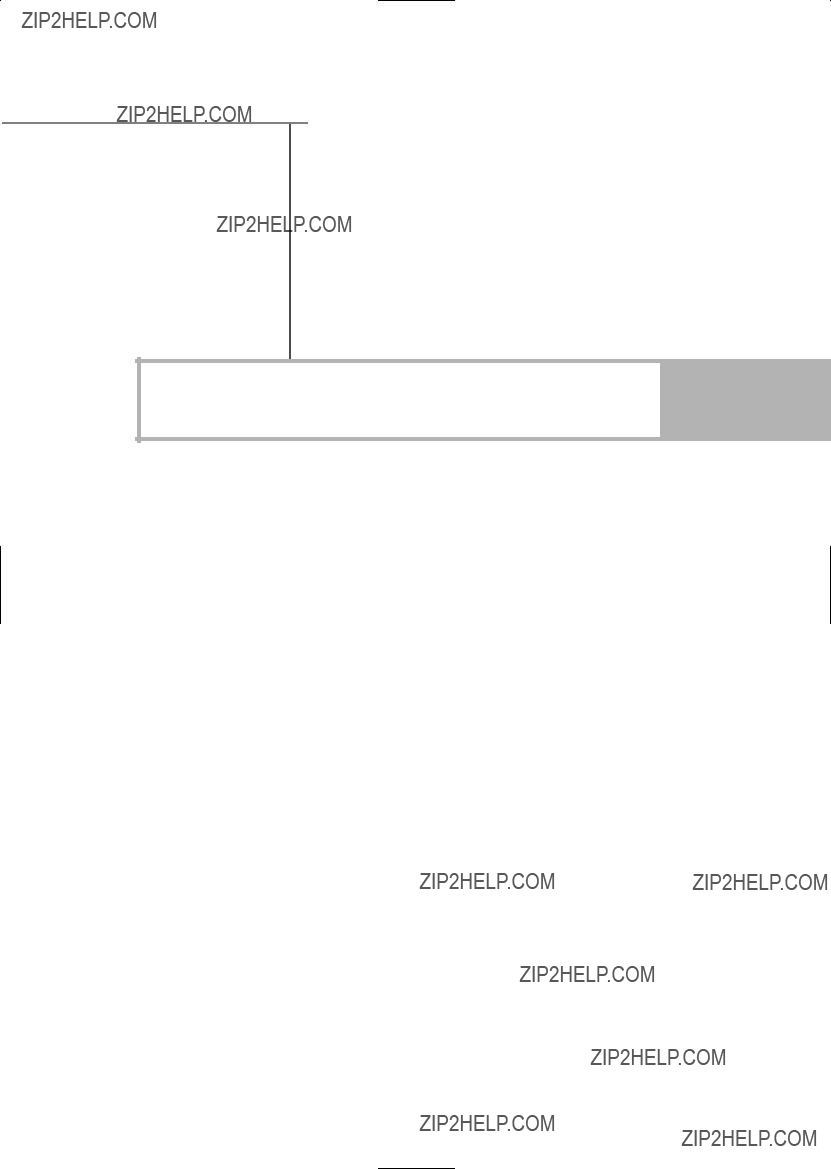
Picture Control
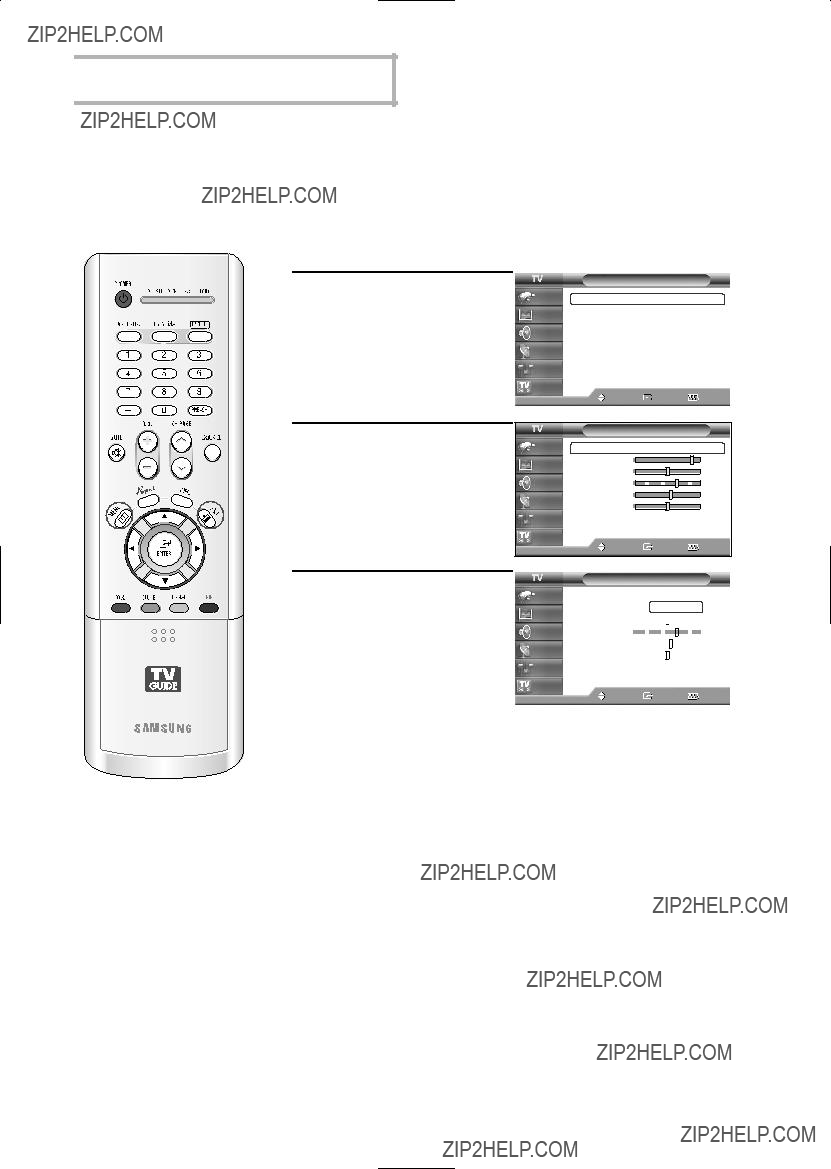
 Picture Control
Picture Control
Picture Control
You can select the type of picture which best corresponds to your viewing requirements.
Changing the Picture Standard
1 Press the MENU button. Press the ??? or ??? button to select ???Picture???, then press the ENTER button.
2 Press the ENTER button again to select ???Mode???.
3 Press the ENTER button. Press the ??? or ??? button to select the desired picture mode (Dynamic, Standard, Cinema), then press the ENTER button.
Press the EXIT button to exit.
???Choose ???Dynamic??? for viewing the TV during the day or when there is a bright light in the room.
???Choose ???Standard??? for the standard factory settings.
???Choose ???Cinema??? when viewing a movie.
 English - 54
English - 54
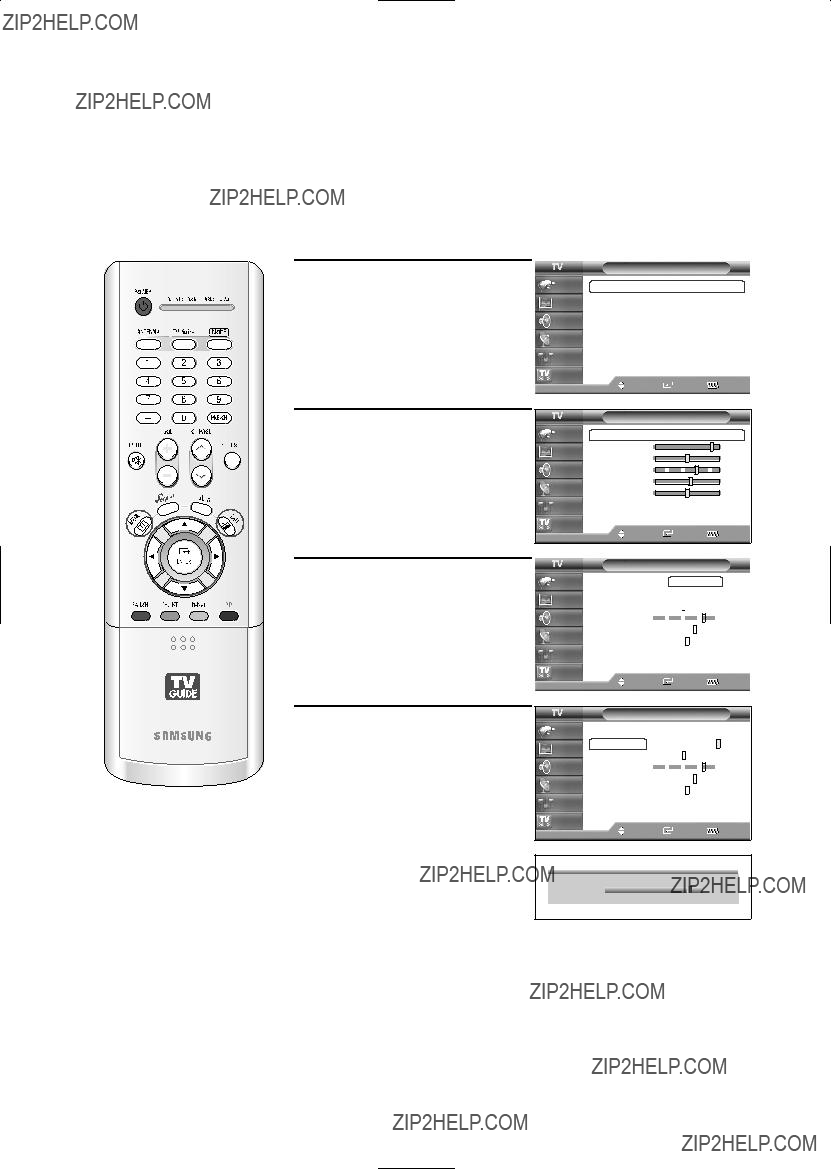
Customizing the Picture Settings
You can use the
1 Press the MENU button. Press the ??? or ??? button to select ???Picture???, then press the ENTER button.
2 Press the ENTER button to select ???Mode???.
3 Press the ENTER button. Press the ??? or ??? button to
select the desired picture mode (Dynamic, Standard, Cinema), then press the ENTER button.
4 Press the ??? or ??? button to select a particular option (Contrast, Brightness, Sharpness, Color, or Tint), then press the ENTER button.
Press the ?? or ??? button to decrease or increase the value of a particular item.
???You can also select these options (Contrast, Brightness, Sharpness, Color, or Tint) by pressing the ??? or ??? button.
NOTES
??????Tint??? doesn???t operate in HDMI or 480p Component or higher modes.
???The Tint cannot be adjusted while watching Digital TV.
Continued...
English - 55 
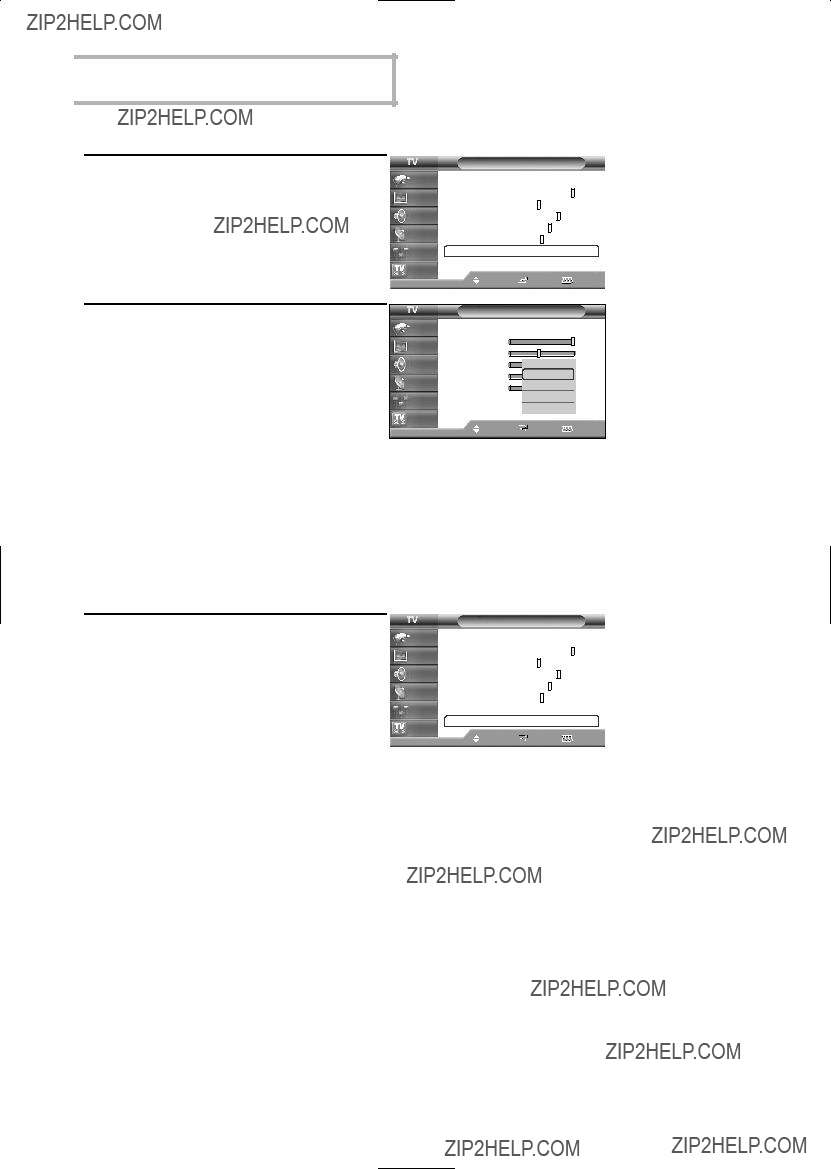
 Picture Control
Picture Control
5 Press the ENTER button to return to ???Mode???.
Press the ??? or ??? button to select ???Color Tone???, then press the ENTER button.
6 Press the ??? or ??? button to select a particular option (Cool2, Cool1, Normal, Warm1, or Warm2), then press the ENTER button.
Press the EXIT button to exit.
NOTE
??? Color tone is not available in the ???Cinema??? picture mode.
Resetting the Picture Settings to the Factory Defaults
7 To return the factory defaults, select ???Reset??? by pressing the ??? or ??? button. Press the ENTER button.
???The previously adjusted settings will be reset to the factory defaults.
 English - 56
English - 56
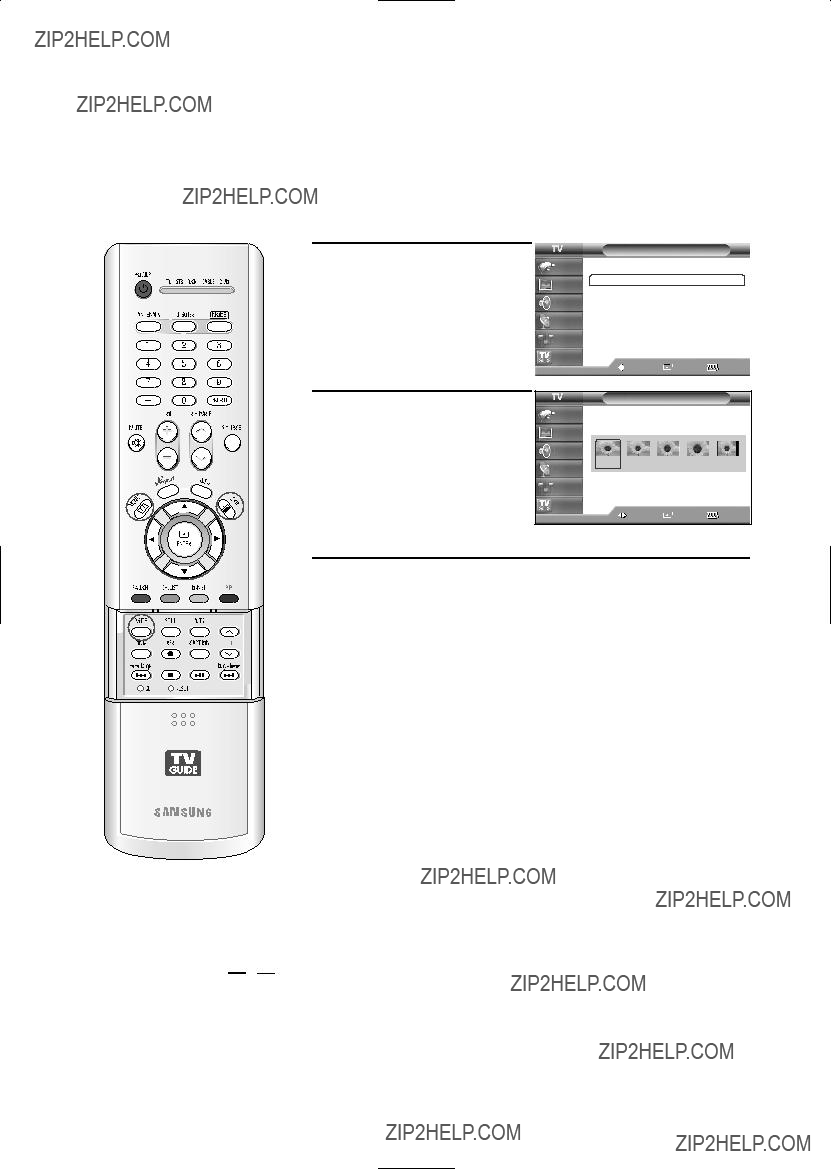
Changing the Picture Size
You can select the picture size which best corresponds to your viewing requirements.
1 Press the MENU button. Press the ??? or ??? button to select ???Picture???, then press the ENTER button.
Press the ??? or ??? button to select ???Size???, then press the ENTER button.
2 Press the ?? or ??? button to select the screen format you want, then press the ENTER button.
Press the EXIT button to exit.
Alternate method
Press the P.SIZE button on the remote control repeatedly to select one of the picture size settings.
??? ???16:9???: Sets the picture to 16:9 wide mode.
??? ???Panorama???: Use this mode for the wide aspect ratio of a panoramic picture.
??? ???Zoom1???: Magnifies the size of the picture on screen.
??? ???Zoom2???: Magnifies the size of the picture more than ???Zoom1???.
??? ???4:3???: Sets the picture to 4:3 normal mode. This is a standard TV screen size.
NOTES
???You can select only the 16:9 and 4:3 screen sizes in the DTV or Component (720p, 1080i) mode.
???When Double ( 

 ,
, 

 ) mode has been set in PIP, the Picture Size cannot be set.
) mode has been set in PIP, the Picture Size cannot be set.
English - 57 
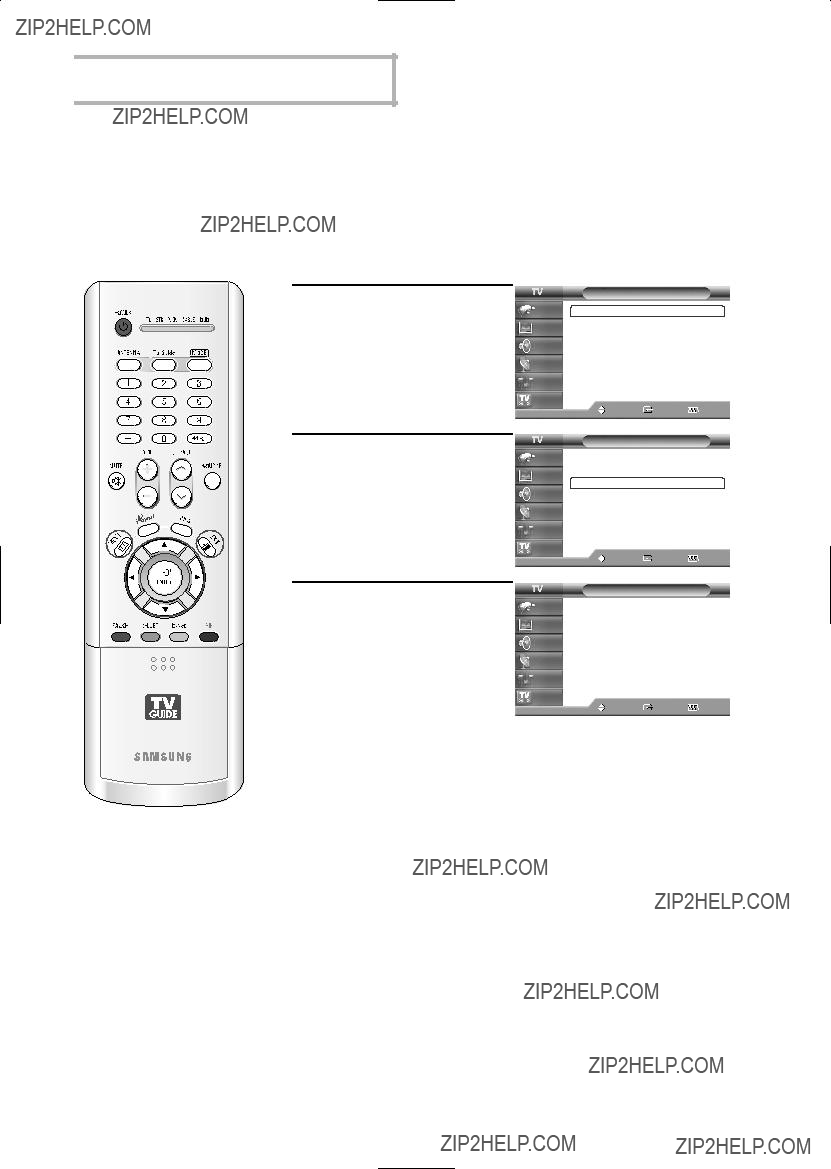
 Picture Control
Picture Control
Digital Noise Reduction
If the broadcast signal received by your TV is weak, you can activate the Digital Noise Reduction feature to help reduce any static and ghosting that may appear on the screen.
1 Press the MENU button. Press the ??? or ??? button to select ???Picture???, then press the ENTER button.
2 Press the ??? or ??? button to select ???Digital NR???, then press the ENTER button.
3 Press the ??? or ??? button to select ???Off??? or ???On???, then press the ENTER button.
Press the EXIT button to exit.
 English - 58
English - 58
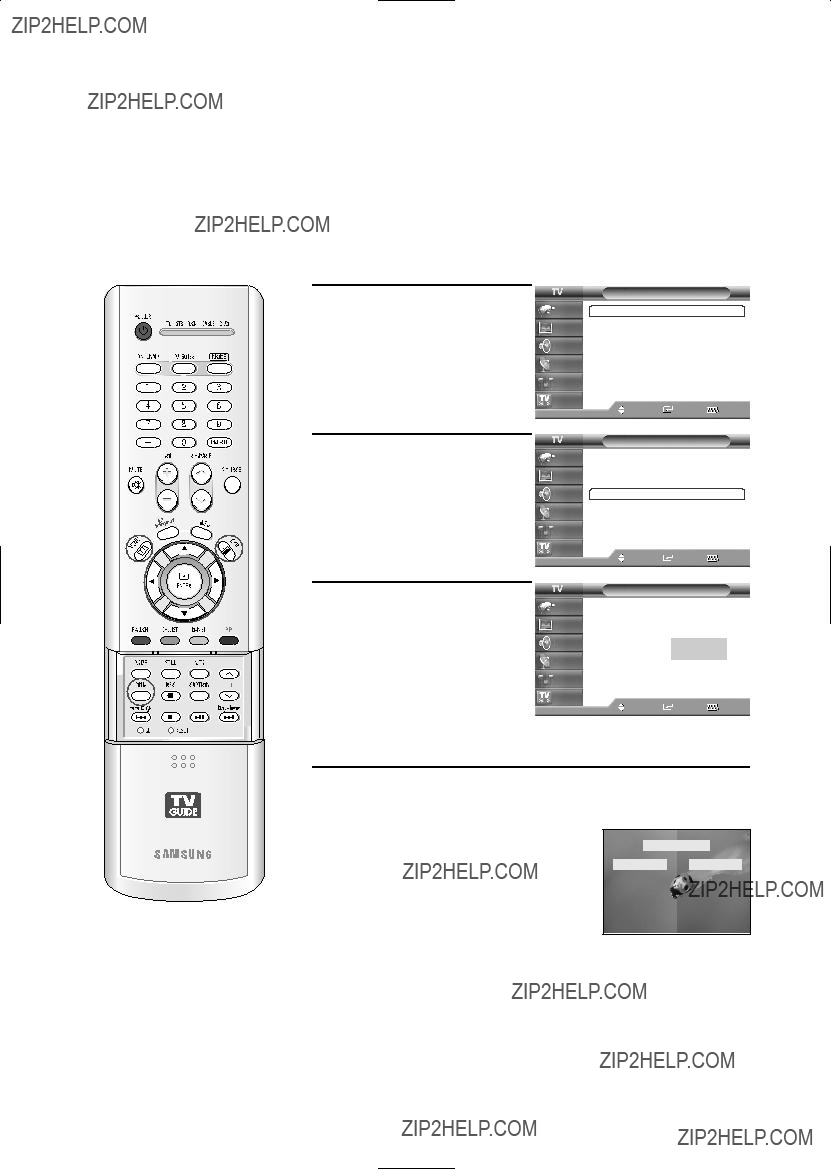
Viewing the DNIe Demonstration
This TV includes the DNIe function so as to provide a high visual quality.
If you set DNIe Demo to On, you can view an applied DNIe and a normal picture on the screen, for demonstration purposes. Using this function, you can view the difference in the visual quality.
1 Press the MENU button. Press the ??? or ??? button to select ???Picture???, then press the ENTER button.
2 Press the ??? or ??? button to select ???DNIe Demo???, then press the ENTER button.
3 Press the ??? or ??? button to select ???Off??? or ???On???, then press the ENTER button.
Press the EXIT button to exit.
Alternate method
Press the DNIe button on the remote control repeatedly to select one of the settings.
???On: Switches on the DNIe Demo mode.
???Off: Switches off the DNIe Demo mode.
DNIe Demo
NOTE
???DNIeTM (Digital Natural Image engine) 
This feature brings you more detailed image with 3D noise reduction, detail enhancement, contrast enhancement and white enhancement.
English - 59 
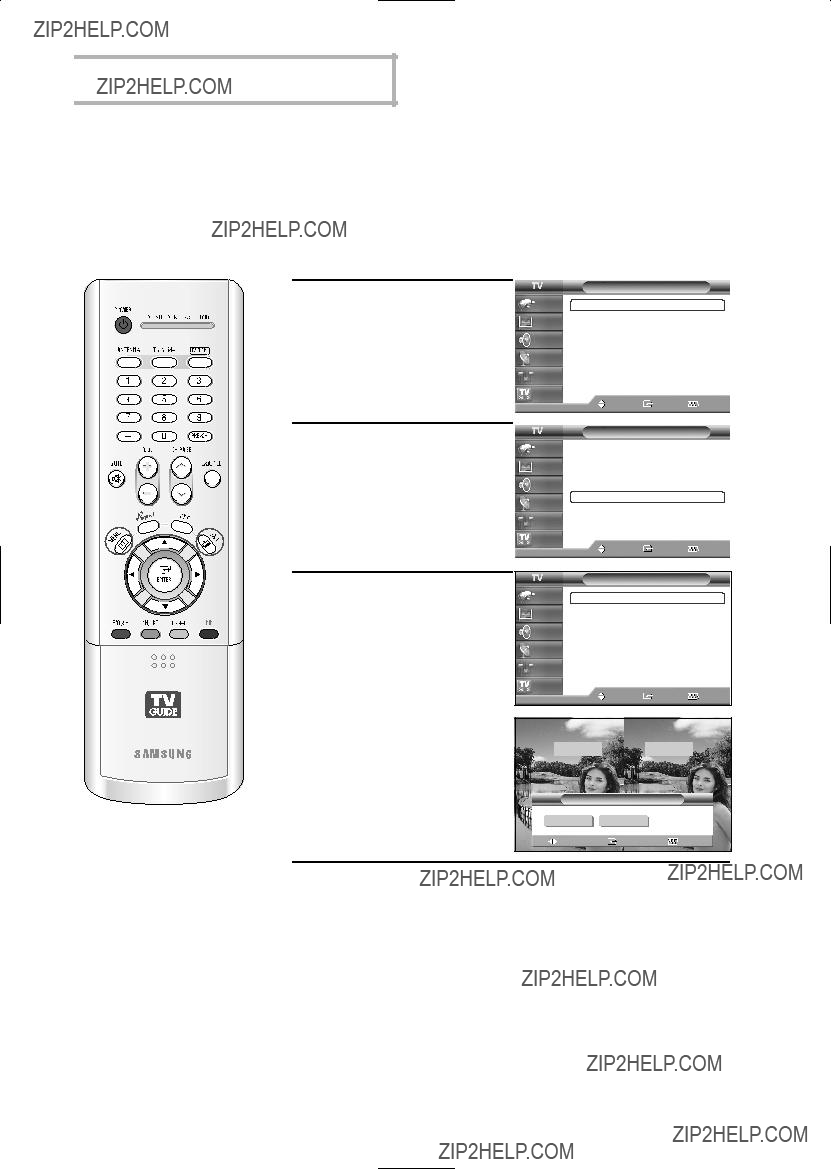
 Picture Control
Picture Control
Setting the My Color Control Mode
My Color Control allows you to adjust colors according to your preference, by adjusting skin, sky, and grass tones using the predefined settings (???Blue???, ???Green???, ???Pink???, ???Standard???, and ???Custom???) without affecting other colors on the screen.
Using the Easy Control Menu
select ???Picture???, then press the ENTER button.
2 Press the ??? or ??? button to select ???My Color Control???, then press the ENTER button.
NOTE
3 Press the ENTER button to select ???Easy Control???. Press the ?? or ??? button to select one of the picture settings you want.
The original picture (before adjustment) is shown
on the left side, while the selected mode is shown on the right side.
Press the ENTER button to accept the selected mode.
Press the EXIT button to exit.
My Color Control
??????Blue???: Emphasizes Clear Blues.
??????Green???: Emphasizes Mild Greens.
??????Pink???: Emphasizes Warm Skin Colors.
??????Standard???: Standard Picture.
 English - 60
English - 60

Custom Settings
select ???Picture???, then press the ENTER button.
Press the ??? or ??? button to select ???My Color Control???, then press the ENTER button.
2 Press the ??? or ??? button to select ???Detail Control???, then press the ENTER button.
My Color Control
3 Press the ??? or ??? button to select the desired My Color Control, then press the ENTER button.
There are three colors: ???Pink???, ???Green??? and ???Blue???.
Press the ?? or ??? button to adjust the value of a color selected.
Changing the adjustment value will refresh the adjusted screen.
Resetting the My Color Control Colors to the Factory Defaults
You can return to the factory default settings for My Color Control colors.
4 Press the MENU button to display the ???Detail Control??? menu.
Press the ??? or ??? button to select ???Reset???, then press the ENTER button.
The previously adjusted My Color Control colors will be reset to the factory defaults.
English - 61 
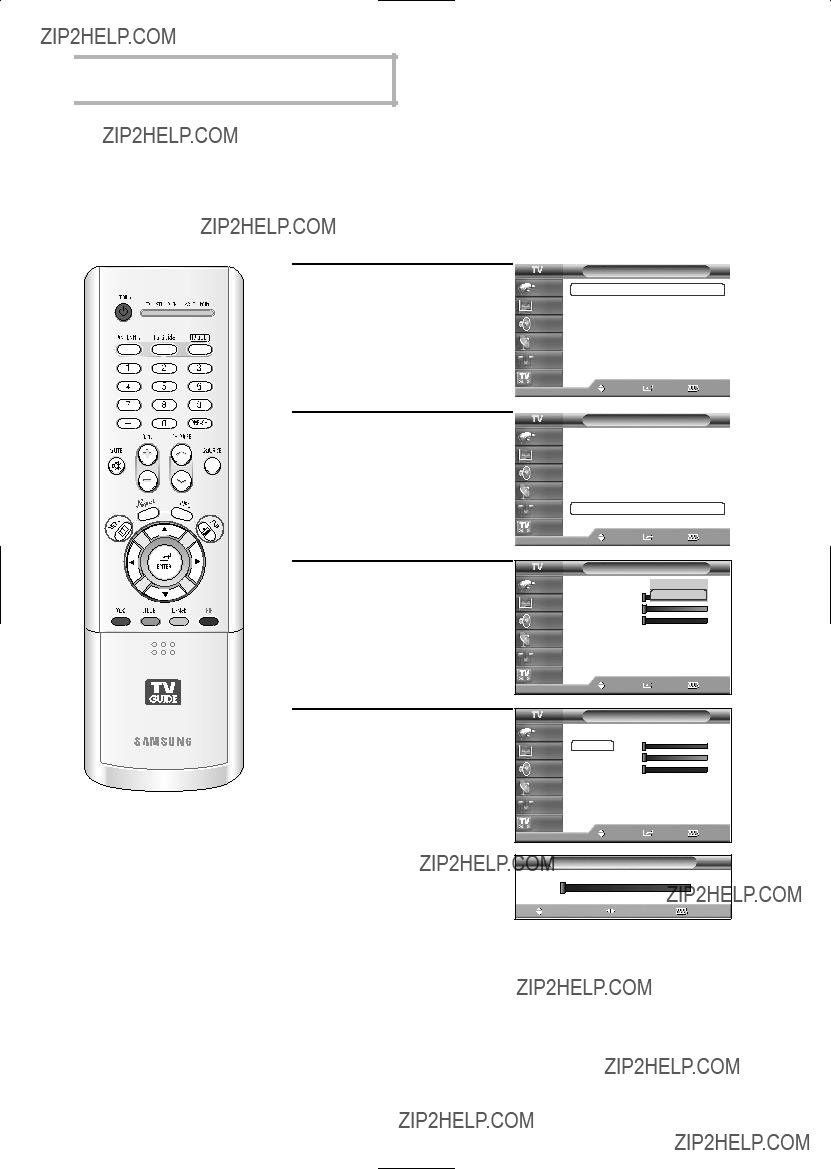
 Picture Control
Picture Control
Using the Color Weakness Enhancement Feature
This feature adjusts the Red, Green or Blue color to enhance the picture according to the user???s particular color weakness.
1 Press the MENU button. Press the ??? or ??? button to select ???Setup???, then press the ENTER button.
2 Press the ??? or ??? button to select ???Color Weakness???, then press the ENTER button.
3 Press the ENTER button to select ???Color Weakness???. Press the ??? or ??? button to select ???On???, then press the ENTER button.
4 Press the ??? or ??? button to select a color to be adjusted, then press the ENTER button.
Press the ?? or ??? button to adjust the value of a color selected.
???You can also select these options (Red, Green or Blue) by pressing the ??? or ??? button.
Color Weakness
Color Weakness
Color Weakness
???
Press the EXIT button to exit.
 English - 62
English - 62

Setting the Film Mode
You can automatically sense and process film signals from all sources and adjust the picture for optimum quality.
1 Press the MENU button. Press the ??? or ??? button to select ???Picture???, then press the ENTER button.
2 Press the ??? or ??? button to select ???Film Mode???, then press the ENTER button.
3 Press the ??? or ??? button to select ???Off??? or ???On???, then press the ENTER button.
Press the EXIT button to exit.
NOTE
??? Film mode is supported in 480i only.
English - 63 

 Picture Control
Picture Control
Viewing
One of the best features of your TV is the
Activating the PIP
1 Press the MENU button. Press the ??? or ??? button to select ???Picture???, then press the ENTER button.
2 Press the ??? or ??? button to select ???PIP???, then press the ENTER button.
3 Press the ENTER button to select ???PIP???.
Press the ??? or ??? button to select ???On???, then press the ENTER button.
The sub picture appears in the corner of the screen.
Press the EXIT button to exit.
Alternate method
Press the PIP button on the remote control repeatedly to activate or deactivate the PIP.
NOTES
???This feature doesn???t function when the
???If you turn the TV off while watching and turn it on again, then the mode will return to normal video.
???Digital channels cannot be viewed in the PIP window.
???PIP is supported when the video source for the main picture is digital and the source for the sub picture is analog.
 English - 64
English - 64
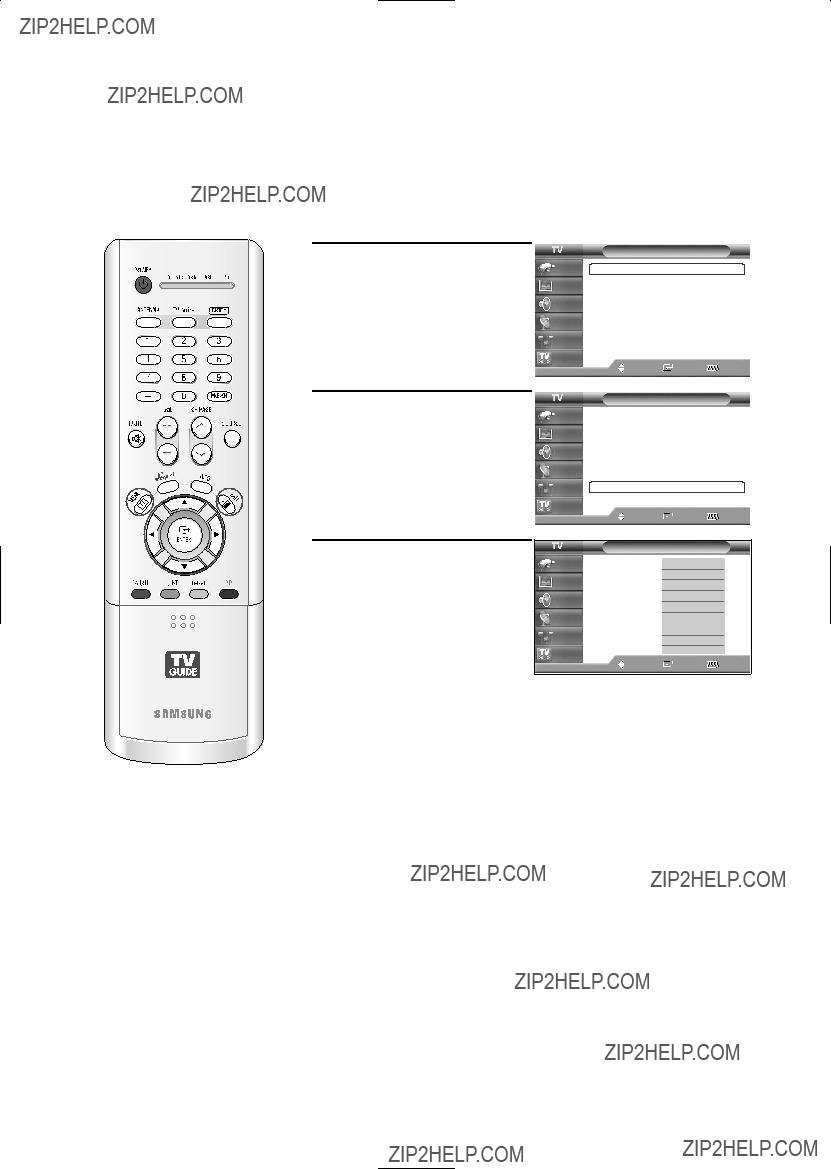
Selecting an External Source
You can use PIP to view a signal from an external source, such as a VCR.
1 Press the MENU button. Press the ??? or ??? button to select ???Picture???, then press the ENTER button.
2 Press the ??? or ??? button to select ???PIP???, then press the ENTER button.
3 Press the ??? or ??? button to select ???Source???, then press the ENTER button.
If you have not connected any equipment to the TV???s input jacks, the signal from these inputs will not appear.
Press the ??? or ??? button to select an external signal, then press the ENTER button.
Press the EXIT button to exit.
NOTE
???For more information about external signals, see ???Viewing an External Signal Source??? (See page 42) and the ???PIP Settings??? (See page 132).
English - 65 
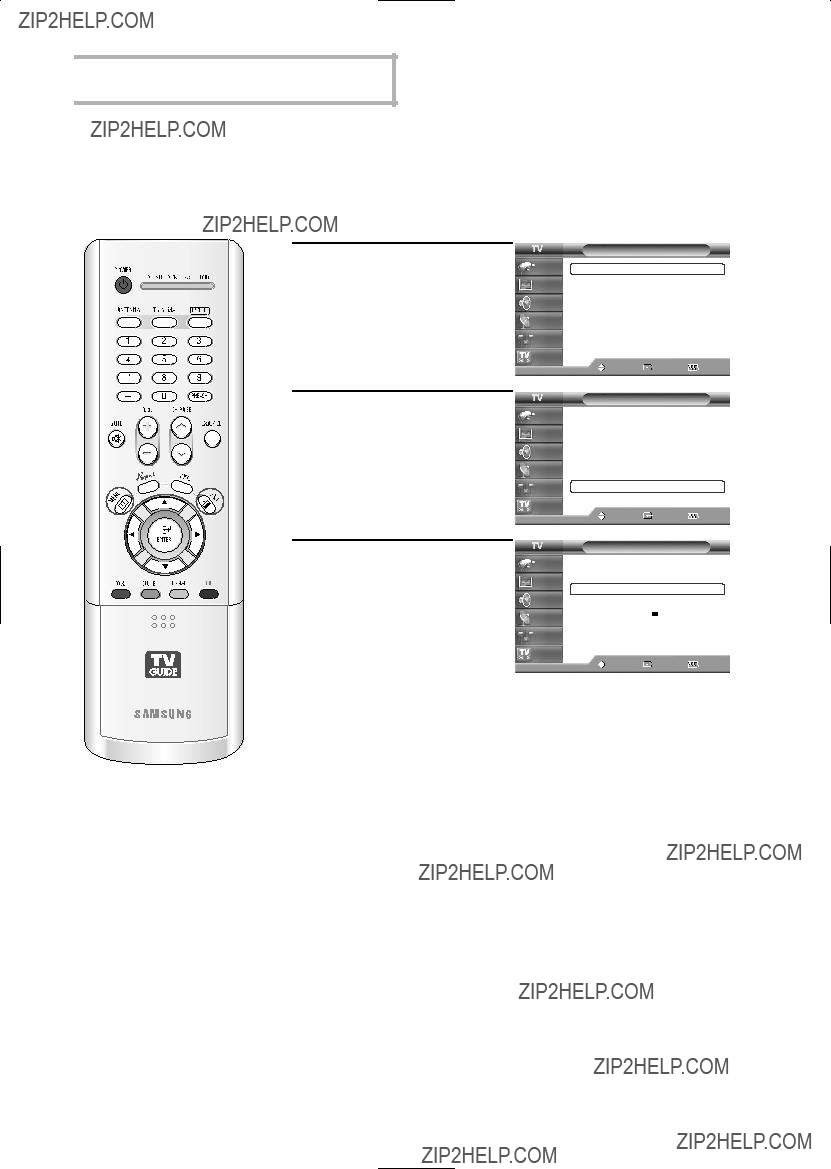
 Picture Control
Picture Control
Swapping the Sub (PIP) Picture and Main Picture
1 Press the MENU button. Press the ??? or ??? button to select ???Picture???, then press the ENTER button.
2 Press the ??? or ??? button to select ???PIP???, then press the ENTER button.
3 Press the ??? or ??? button to select ???Swap???, then press the ENTER button.
The sub picture appears in the main picture, and vice versa.
Press the EXIT button to exit.
NOTE
???SWAP is not available when the Main picture is a Digital broadcast.
 English - 66
English - 66

Changing the Size of the Sub (PIP) Picture
1 Press the MENU button. Press the ??? or ??? button to select ???Picture???, then press the ENTER button.
2 Press the ??? or ??? button to select ???PIP???, then press the ENTER button.
3 Press the ??? or ??? button to select ???Size???, then press the ENTER button.
Press the ??? or ??? button to select a size you want, then press the ENTER button.
Press the EXIT button to exit.
English - 67 

 Picture Control
Picture Control
Changing the Location of the Sub (PIP) Picture
1 Press the MENU button. Press the ??? or ??? button to select ???Picture???, then press the ENTER button.
2 Press the ??? or ??? button to select ???PIP???, then press the ENTER button.
3 Press the ??? or ??? button to select ???Position???, then press the ENTER button.
Press the ??? or ??? button to select a position you want, then press the ENTER button.
Press the EXIT button to exit.
NOTE
??? The Double (  ,
,  ) mode cannot be selected in Position.
) mode cannot be selected in Position.
 English - 68
English - 68
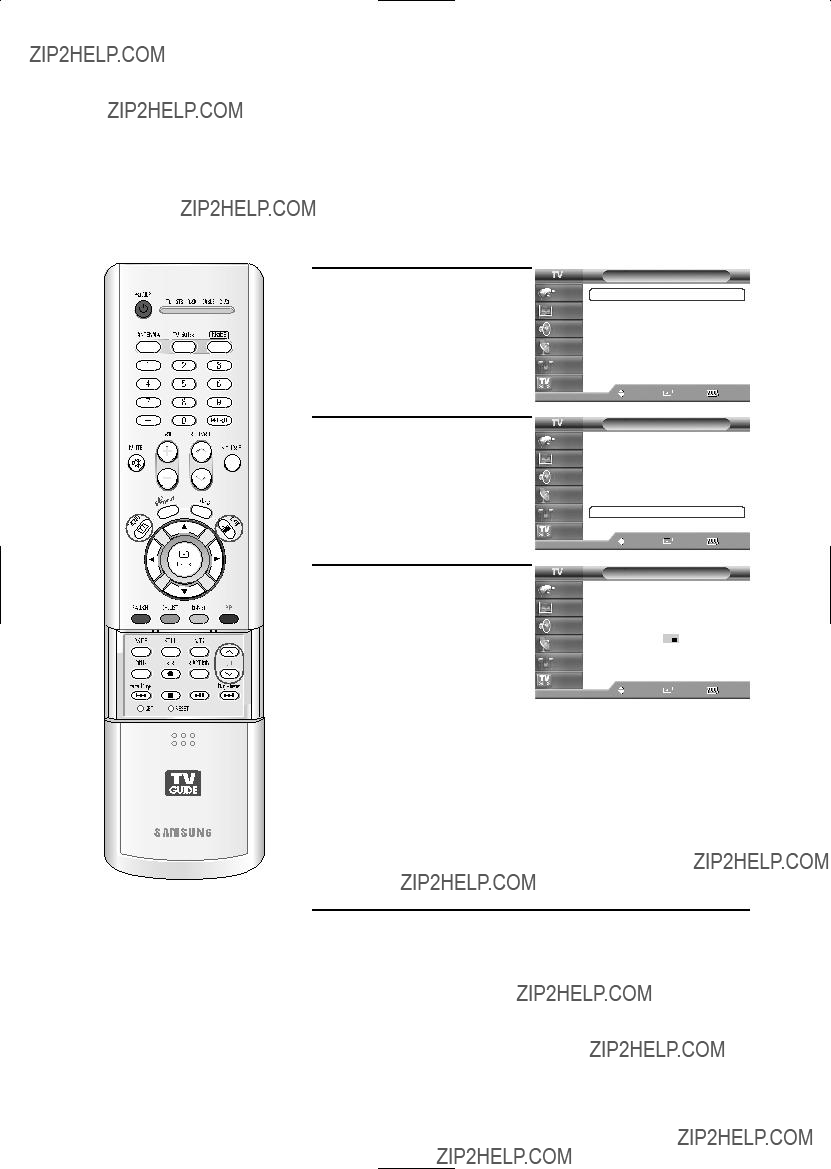
Changing the Channel of the Sub (PIP) Picture
After you set the signal source (antenna or cable) of the sub picture, it is easy to change channels.
1 Press the MENU button. Press the ??? or ??? button to select ???Picture???, then press the ENTER button.
2 Press the ??? or ??? button to select ???PIP???, then press the ENTER button.
3 Press the ??? or ??? button to select ???Channel???, then press the ENTER button.
Press the ??? or ??? button to select a channel you want, then press the ENTER button.
Press the EXIT button to exit.
???You can select ???Air??? or ???Cable??? in the Air/CATV menu.
???Air : ???Air??? antenna signal
Cable : ???Cable??? antenna signal
Alternate method
Press the CH  or CH
or CH  button under the cover of the remote control to change the sub picture channels while PIP is on.
button under the cover of the remote control to change the sub picture channels while PIP is on.
English - 69 
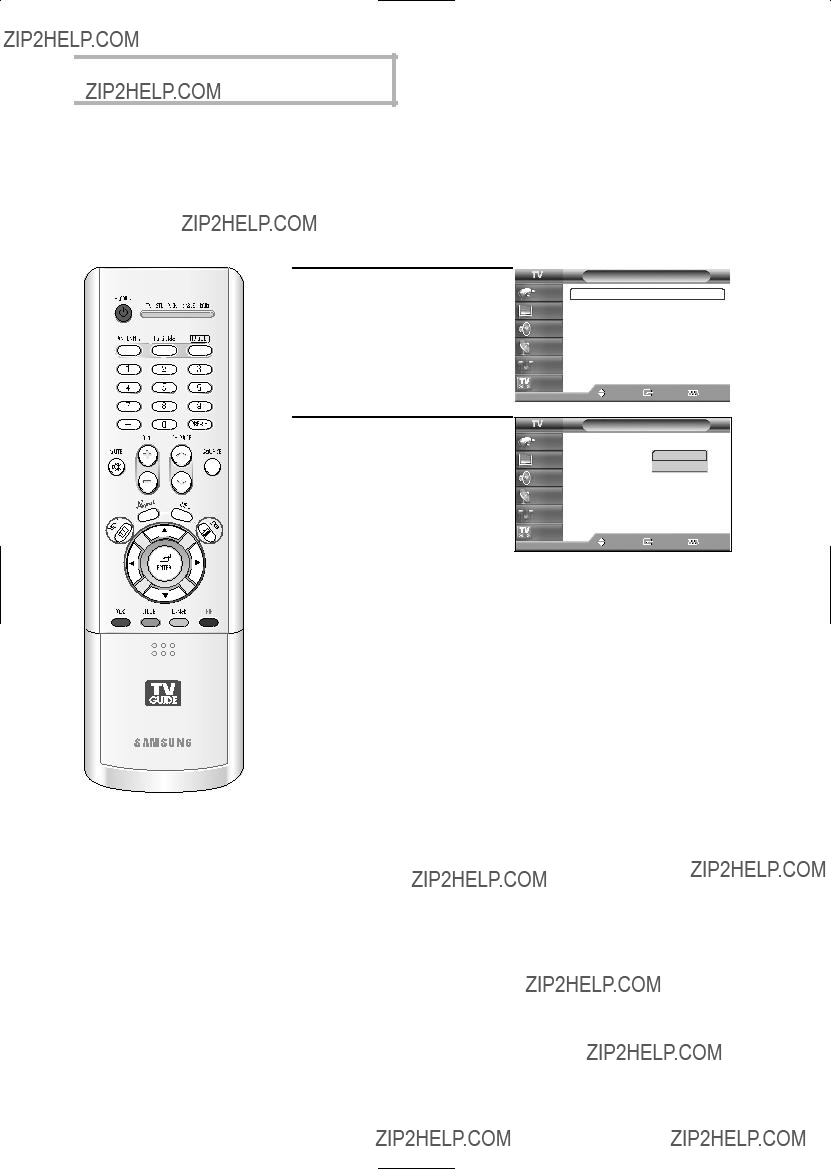
 Picture Control
Picture Control
Selecting the Sound Source
You can use this feature to hear sound from the main or sub (PIP) picture.
1 Press the MENU button. Press the ??? or ??? button to select ???Sound???, then press the ENTER button.
2 Press the ??? or ??? button to select ???Sound Select???, then press the ENTER button.
Press the ??? or ??? button to select ???Main??? or ???Sub???, then press the ENTER button.
Press the EXIT button to exit.
 English - 70
English - 70

Freezing the Picture
Press the STILL button to freeze a moving picture. (Normal sound will still be heard.)
Press again to cancel.
NOTE
??? In the PIP mode, the main and sub pictures are stilled at the same time.
English - 71 

 Picture Control
Picture Control
Setting the Blue Screen Mode
If no signal is being received or the signal is very weak, a blue screen automatically replaces the noisy picture background. If you wish to continue viewing the poor picture, you must set the ???Blue Screen??? mode to ???Off???.
1 Press the MENU button. Press the ??? or ??? button to select ???Setup???, then press the ENTER button.
2 Press the ??? or ??? button to select ???Blue Screen???, then press the ENTER button.
3 Press the ??? or ??? button to select ???On??? or ???Off???, then press the ENTER button.
Press the EXIT button to exit.
 English - 72
English - 72

Sound Control
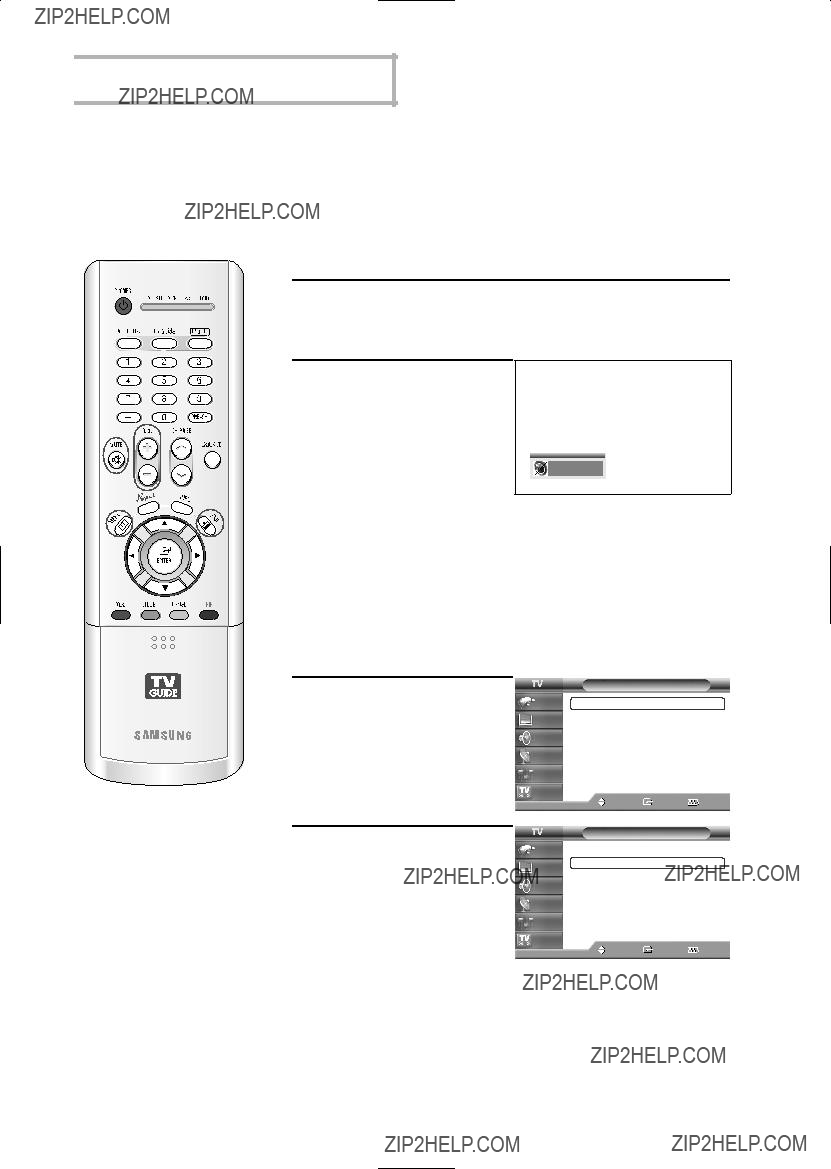
 Sound Control
Sound Control
Sound Control
You can control and customize the sound levels and settings of the TV with the remote control.
Adjusting the Volume
Press the VOL+ or VOL??? button to increase or decrease the volume.
Using the MUTE Button
At any time, you can temporarily cut off the sound.
Press the MUTE button on the remote control.
The message ???Mute??? is displayed and the sound cuts off.
To turn mute off, press the MUTE button again or press either the VOL+ or VOL??? button.
Mute
Customizing the Sound
The sound settings can be adjusted to suit your personal preference. (Alternatively, you can use one of the automatic settings. See next page.)
1 Press the MENU button. Press the ??? or ??? button to select ???Sound???, then press the ENTER button.
2 Press the ??? or ??? button to select ???Equalizer???, then press the ENTER button.
Continued...
 English - 74
English - 74
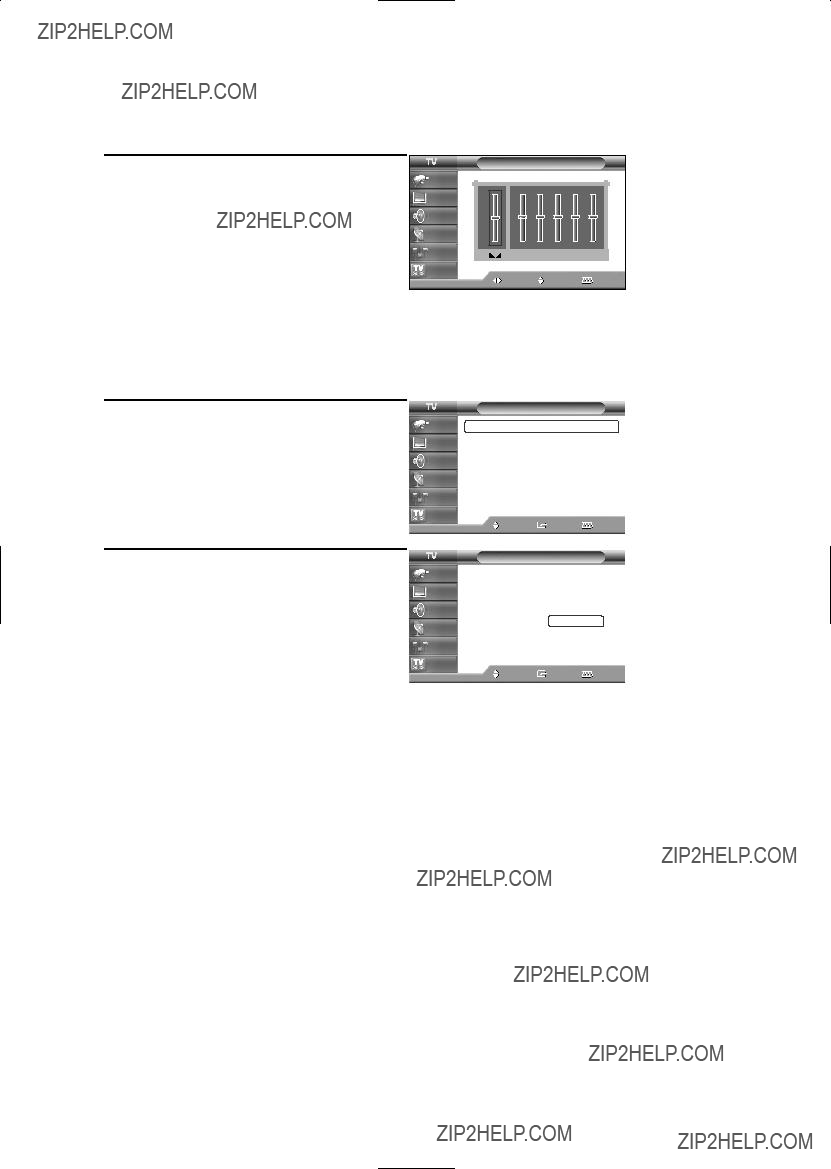
3 Press the ?? or ??? button to select a particular item to be changed.
Press the ??? or ??? button to increase or decrease the selected frequency.
Press the EXIT button to exit.
Equalizer
Using Automatic Sound Settings
Your TV has automatic sound settings (???Standard???, ???Music???, ???Movie???, and ???Speech???) that are preset at the factory. You can select ???Custom???, which automatically recalls your personalized sound settings.
1 Press the MENU button.
Press the ??? or ??? button to select ???Sound???, then press the ENTER button.
2 Press the ENTER button to select ???Mode???. Press the ??? or ??? button to select a particular item, then press the ENTER button.
Press the EXIT button to exit.
???Choose ???Standard??? for the standard factory settings.
???Choose ???Music??? when watching music videos or concerts.
???Choose ???Movie??? when watching movies.
???Choose ???Speech??? when watching a show that is mostly dialog (i.e., news).
???Choose ???Custom??? to recall your personalized settings.
English - 75 

 Sound Control
Sound Control
Setting the SRS TSXT
TruSurround XT is a patented SRS technology that solves the problem of playing 5.1 multichannel content over two speakers. Trusurround delivers a compelling, virtual surround sound experience through any
1 Press the MENU button. Press the ??? or ??? button to select ???Sound???, then press the ENTER button.
2 Press the ??? or ??? button to select ???SRS TSXT???, then press the ENTER button.
3 Press the ??? or ??? button to select ???Off???, ???3D Mono??? or ???Stereo???, then press the ENTER button.
Press the EXIT button to exit.
NOTE
???Press the INFO button on the remote control to see the current status of sound settings.
 English - 76
English - 76
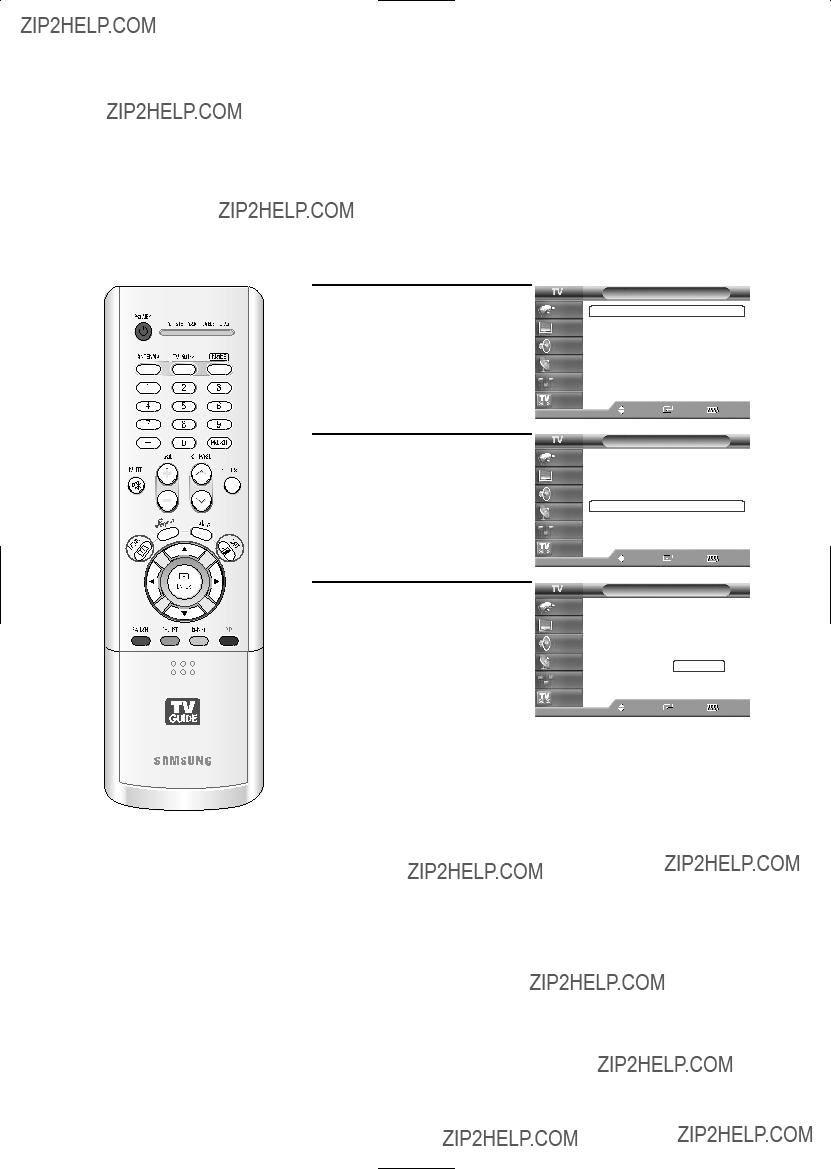
Auto Volume
Each broadcasting station has its own signal conditions, and it is inconvenient to adjust the volume every time the channel is changed. ???Auto Volume??? automatically adjusts the volume of the desired channel by lowering the sound output when the modulation signal is high or by raising the sound output when the modulation signal is low.
1 Press the MENU button. Press the ??? or ??? button to select ???Sound???, then press the ENTER button.
2 Press the ??? or ??? button to select ???Auto Volume???, then press the ENTER button.
3 Press the ??? or ??? button to select ???Off??? or ???On???, then press the ENTER button.
Press the EXIT button to exit.
English - 77 
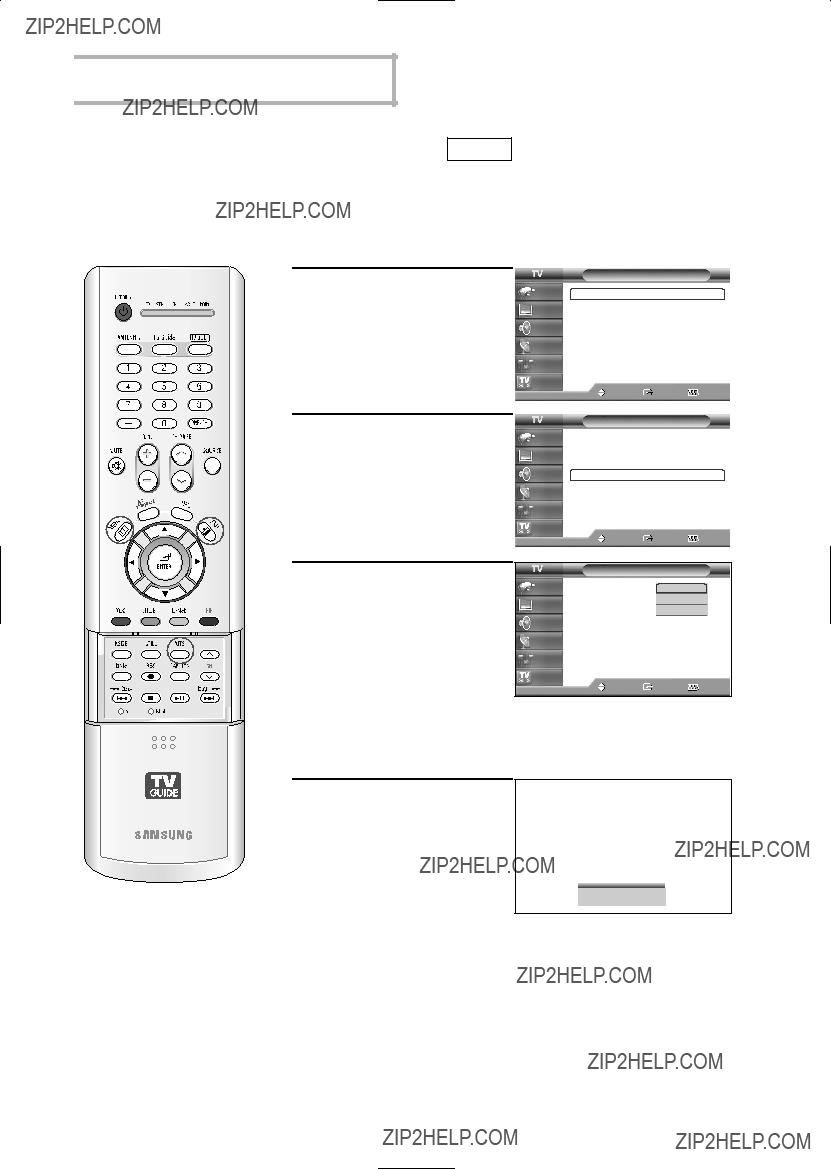
 Sound Control
Sound Control
Choosing a
The
The availability of these additional ???multitracks??? depends upon the program.
1 Press the MENU button. Press the ??? or ??? button to select ???Sound???, then press the ENTER button.
2 Press the ??? or ??? button to select
3 Press the ENTER button to select ???Preferred Language???. Press the ??? or ??? button to choose the language (English, Spanish or French) you want, then press the ENTER button.
Press the EXIT button to exit.
Alternate method
Press the MTS button on the remote control.
You can listen in a language other than the favorite language by pressing the MTS button.
English
 English - 78
English - 78

Choosing a
Depending on the particular program being broadcast, you can listen to Mono, Stereo or SAP.
1 Press the MENU button. Press the ??? or ??? button to select ???Sound???, then press the ENTER button.
2 Press the ??? or ??? button to select
3 Press the ??? or ??? button to select
Press the EXIT button to exit.
Alternate method
Press the MTS button on the remote control repeatedly to select an external signal source.
Stereo
NOTES
???Choose ???Mono??? for channels that are broadcasting in mono, or if you are having difficulty receiving a stereo signal.
???Choose ???Stereo??? for channels that are broadcasting in stereo.
???Choose ???SAP??? to listen to the Separate Audio Program, which is usually a
English - 79 

 Sound Control
Sound Control
Choosing a Digital Sound Format Digital
Digital sound can be output from the
select ???Sound???, then press the ENTER button.
2 Press the ??? or ??? button to select ???Digital Output???, then press the ENTER button. Press the ??? or ??? button to select ???Dolby Digital??? or ???PCM???, then press the ENTER button.
Press the EXIT button to exit.
Manufactured under license from Dolby Laboratories. ???Dolby??? and the
 English - 80
English - 80
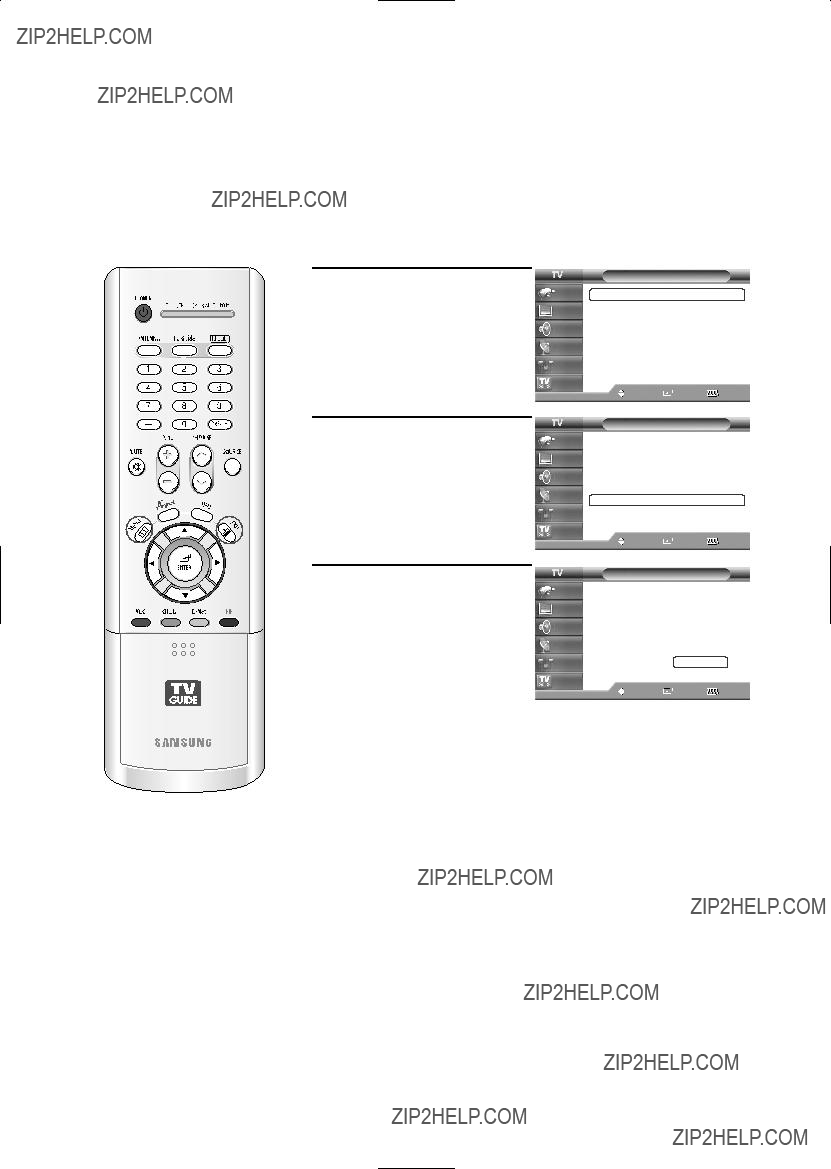
Selecting the Internal Mute
When using a device such as a Home Theater or Amplifier with external speakers, you can set Internal Mute to On to cut off sound from the TV???s internal speakers.
1 Press the MENU button. Press the ??? or ??? button to select ???Sound???, then press the ENTER button.
2 Press the ??? or ??? button to select ???Internal Mute???, then press the ENTER button.
3 Press the ??? or ??? button to select ???On???, then press the ENTER button.
Pressing the ??? or ??? button will alternate between ???On??? and ???Off???.
Press the EXIT button to exit.
NOTES
???The VOL +, VOL - and Mute buttons do not operate when the Internal Mute is set to On.
???When Internal Mute is on, only the
English - 81 
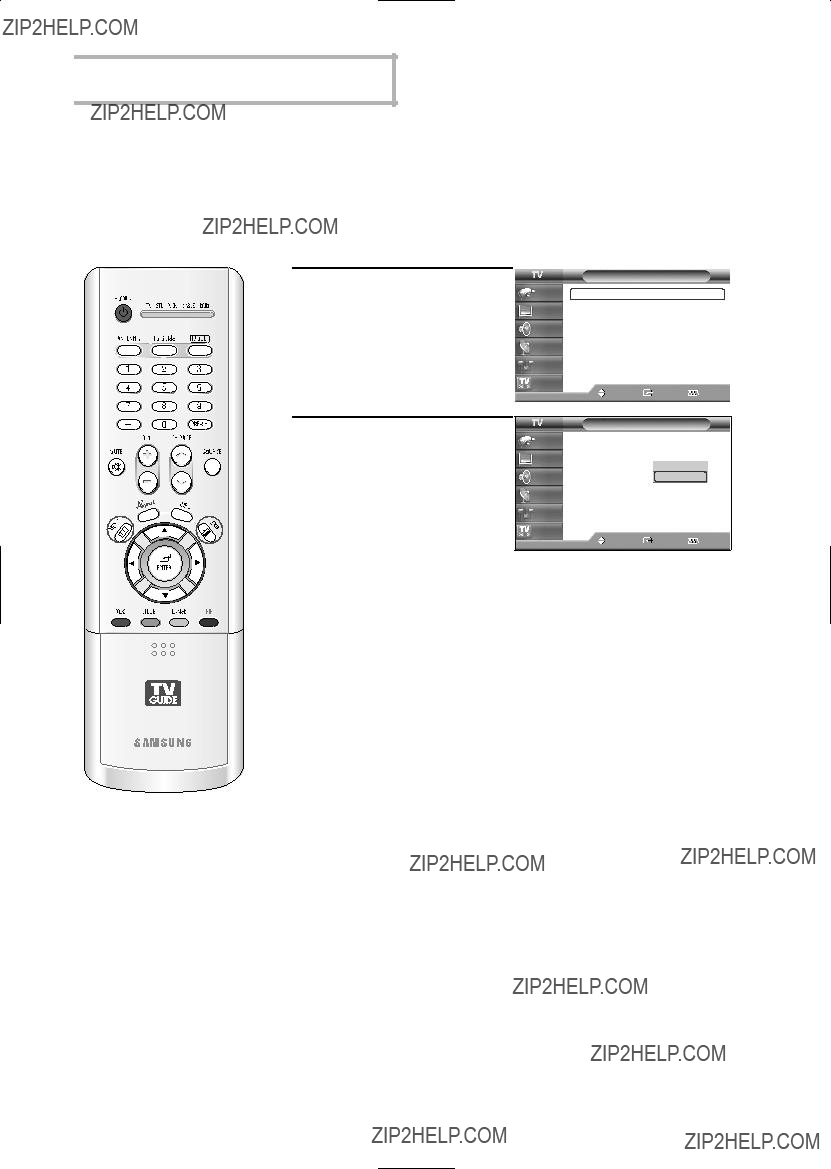
 Sound Control
Sound Control
Setting the On/Off Melody
A melody sound can be set to come on when the TV is powered On or Off.
select ???Sound???, then press the ENTER button.
2 Press the ??? or ??? button to select ???Melody???, then press the ENTER button.
Press the ??? or ??? button to select ???On??? or ???Off???, then press the ENTER button.
Press the EXIT button to exit.
 English - 82
English - 82
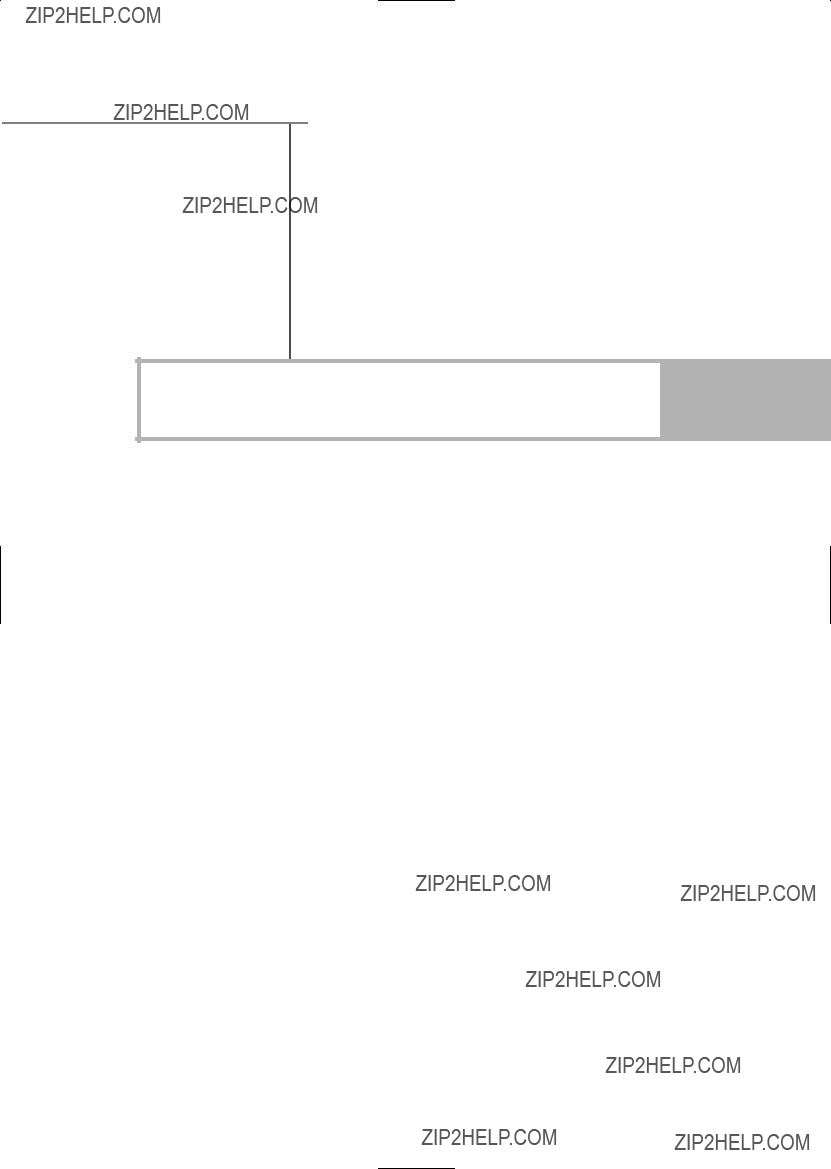
Special Features

 Special Features
Special Features
Setting the Function Help
Displays Help on the menu functions.
1 Press the MENU button. Press the ??? or ??? button to select ???Setup???, then press the ENTER button.
2 Press the ??? or ??? button to select ???Function Help???, then press the ENTER button.
3 Press the ??? or ??? button to select ???On???, then press the ENTER button.
Press the EXIT button to exit.
Setup
Listings
 Move
Move  Enter
Enter  Return
Return
Switches the Function Help on.
 English - 84
English - 84
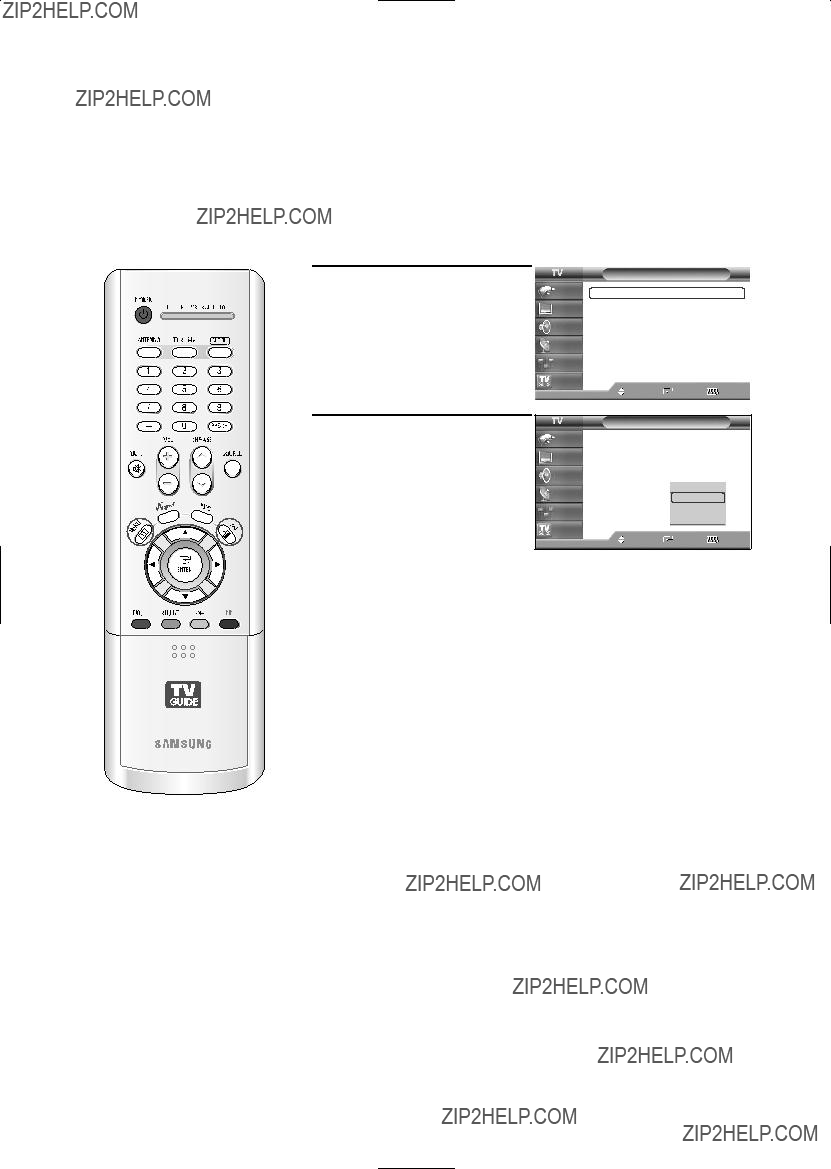
Menu Transparency Level
Adjusts the transparency of the menu screen.
1 Press the MENU button. Press the ??? or ??? button to select ???Setup???, then press the ENTER button.
2 Press the ??? or ??? button to select ???Menu Transparency???, then press the ENTER button. Press the ??? or ??? button to select level, then press the ENTER button.
Press the EXIT button to exit.
English - 85 
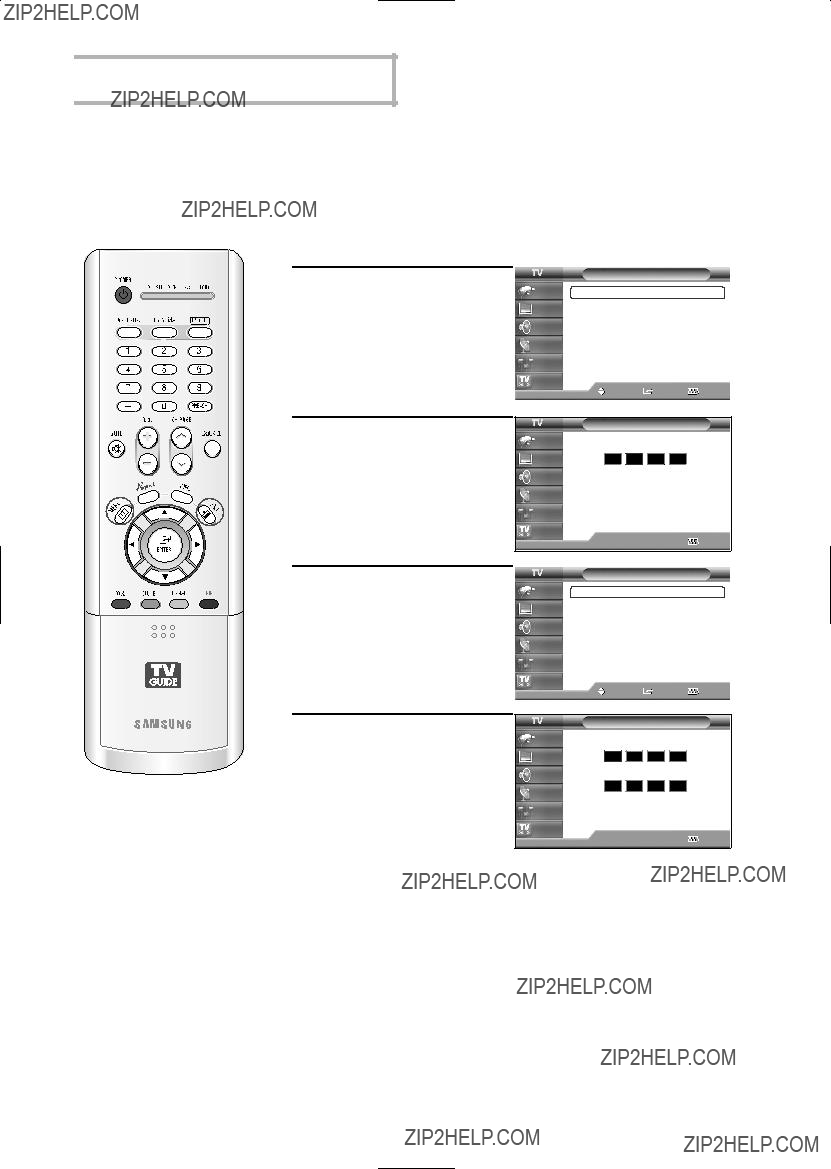
 Special Features
Special Features
Using the
Access to channels and programs is controlled by a password (i.e., a
How to Change Your Password
1 Press the MENU button. Press the ??? or ??? button to select ???Setup???, then press the ENTER button.
Press the ??? or ??? button to select
2 Press the number buttons to enter your current
(The default pin number for a new TV set is ???0000???.) The
3 Press the ??? or ??? button to select ???Change PIN???, then press the ENTER button.
4 Press the number buttons to enter your new
Press the EXIT button to exit.
NOTES
???The PIP doesn???t function when the
???If you forget the pin number, press the remote control buttons in the following sequence, which resets the pin to
???The
 English - 86
English - 86
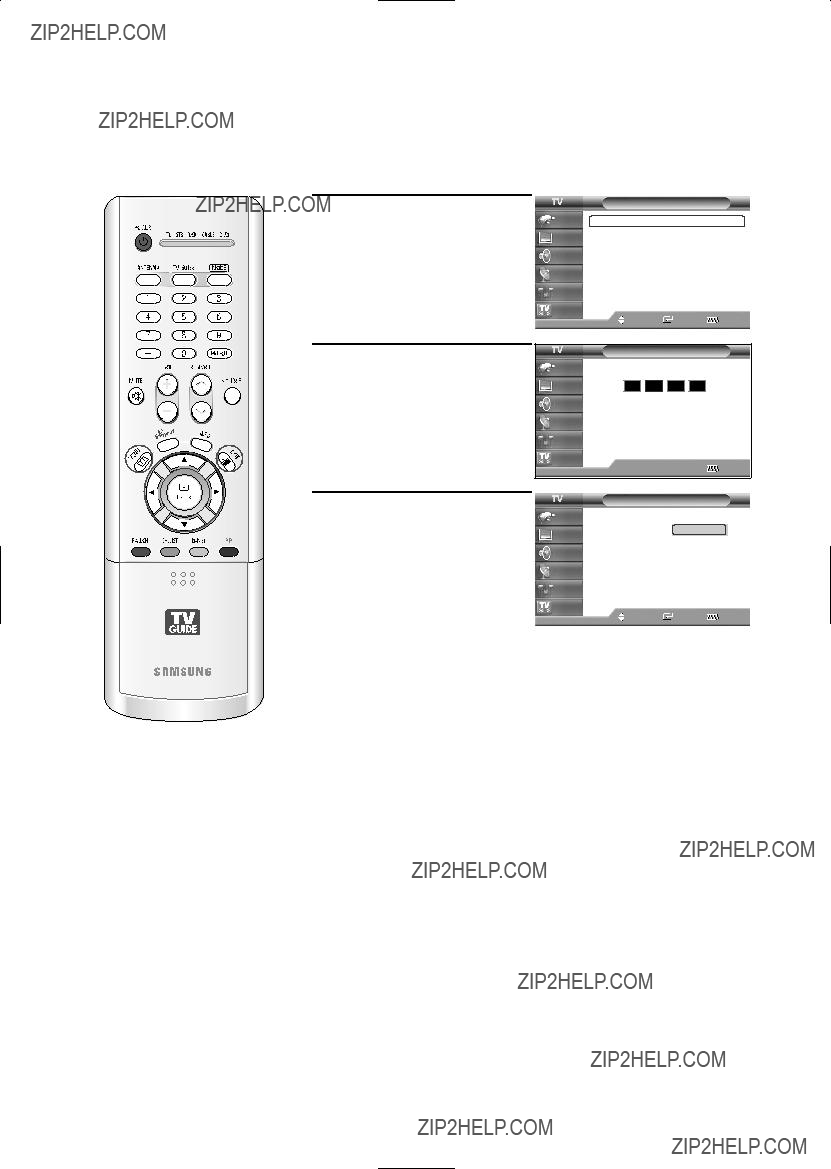
How to Enable/Disable the Rating Controls
1 Press the MENU button. Press the ??? or ??? button to select ???Setup???, then press the ENTER button.
Press the ??? or ??? button to select
2 Press the number buttons to enter your current
(The default pin number for a new TV set is ???0000???.) The
3 The
Press the ENTER button.
Press the EXIT button to exit.
English - 87 

 Special Features
Special Features
How to Set up Restrictions Using the ???TV Parental Guidelines???
The parental restrictions can be set up using either of two methods: The ???TV Parental Guidelines??? or ???MPAA Rating???.
1 Press the MENU button. Press the ??? or ??? button to select ???Setup???, then press the ENTER button.
Press the ??? or ??? button to select
2 Press the number buttons to enter your current
(The default pin number for a new TV set is ???0000???.) The
3 Press the ??? or ??? button to select ???TV Parental Guidelines???, then press the ENTER button.
 English - 88
English - 88

4 You can independently lock the TV ratings. The locked TV (FCC) ratings are indicated by the symbol ??? ???.
???.
Press the ???/???/??/??? buttons and the ENTER button to activate the appropriate restrictions for TV (FCC) rating system.
Press the EXIT button to exit.
NOTES
TV Parental Guidelines
NOTE
??? Allow All : Press to unlock all TV ratings.
Block All : Press to lock all TV ratings.
???These categories consist of two separate groups:
???The restrictions for these two groups work independently: If a household includes very young children as well as young adults, the TV parental guidelines must be set up separately for each age group. (See page 91.)
English - 89 

 Special Features
Special Features
How to Set up Restrictions Using the ???MPAA Rating???
The Movie rating system uses the ???MPAA??? (Motion Picture Association of America) system, and its main application is for movies.
When the rating control is on, the TV will automatically block any programs that are coded with objectionable ratings (either ???MPAA Rating??? or ???TV Parental Guidelines???).
1 Press the MENU button. Press the ??? or ??? button to select ???Setup???, then press the ENTER button.
Press the ??? or ??? button to select
2 Press the number buttons to enter your current
(The default pin number for a new TV set is ???0000???.) The
3 Press the ??? or ??? button to select ???MPAA Rating???, then press the ENTER button.
4 You can independently lock the movie ratings. The locked movie ratings are indicated by the symbol ???  ???.
???.
Press the ???/???/ENTER buttons to activate the appropriate restrictions for movie rating system.
Press the EXIT button.
NOTE
???Allow All : Press to unlock all movie ratings.
Block All : Press to lock all movie ratings.
 English - 90
English - 90

Important Notes About Parental Locks
Explanation of the MPAA and TV (FCC) Rating Systems:
TV (FCC)
Mature audiences only. This program may contain mature themes, profane language, graphic violence and explicit sexual content.
Parents strongly cautioned. This program may contain sophisticated themes, sexual content, strong language and more intense violence.
Parental guidance suggested. The program may contain infrequent coarse language, limited violence, some suggestive sexual dialog and situations.
General audience. It contains little or no violence, no strong language, and little or no sexual dialog or situations.
Directed to older children. Themes and elements in this program may include mild physical or comedic violence, or may frighten children under the age of seven.
All children. The themes and elements in this program are specifically designed for a very young audience, including children from ages two ??? six.
TV (FCC) Content Category
MPAA Rating System (Movies)
???TV (FCC) ratings : The particular rating that you have selected will be locked (and indicated as a red ???L??? on a blue background). Also, all of the
???MPAA ratings : The particular rating that you have selected will be locked. In addition, more restrictive ratings will be locked as well.
???Neither TV (FCC) ratings nor MPAA ratings apply to news programs.
English - 91 

 Special Features
Special Features
How to Set up Restrictions Using Canadian English
1 Press the MENU button. Press the ??? or ??? button to select ???Setup???, then press the ENTER button.
Press the ??? or ??? button to select
2 Press the number buttons to enter your current
(The default pin number for a new TV set is ???0000???.) The
3 Press the ??? or ??? button to select ???Canadian English???, then press the ENTER button.
 English - 92
English - 92

4 Press the ??? or ??? button to select a appropriate restriction.
Press the ENTER button to activate the restriction selected.
The ???  ??? symbol is indicated.
??? symbol is indicated.
Press the EXIT button.
Canadian English
NOTE
??? Allow All : Press to unlock all TV ratings.
Block All : Press to lock all TV ratings.
EExempt programming includes...news, sports, documentaries and other information programming, talk shows, music videos, and variety programming.
English - 93 
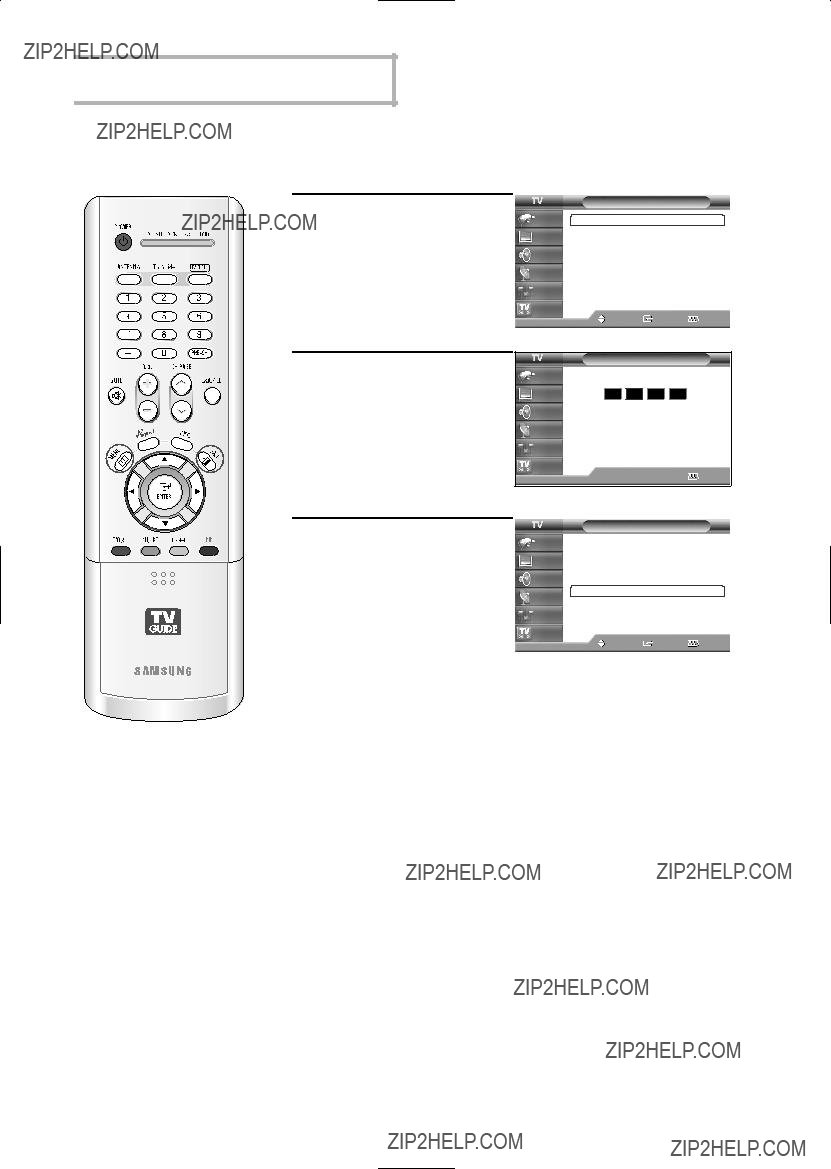
 Special Features
Special Features
How to Set up Restrictions Using Canadian French
1 Press the MENU button. Press the ??? or ??? button to select ???Setup???, then press the ENTER button.
Press the ??? or ??? button to select
2 Press the number buttons to enter your current
(The default pin number for a new TV set is ???0000???.) The
3 Press the ??? or ??? button to select ???Canadian French???, then press the ENTER button.
 English - 94
English - 94

4 Press the ??? or ??? button to select a
Canadian French
appropriate restriction.
Press the ENTER button to activate the restriction selected.
The ???  ??? symbol is indicated.
??? symbol is indicated.
Press the EXIT button.
Listings

 Move
Move  Enter
Enter
Allow All
Block All
 Return
Return
NOTE
??? Allow All : Press to unlock all TV ratings.
Block All : Press to lock all TV ratings.
EExempt programming includes...news, sports, documentaries and other information programming, talk shows, music videos, and variety programming.
English - 95 
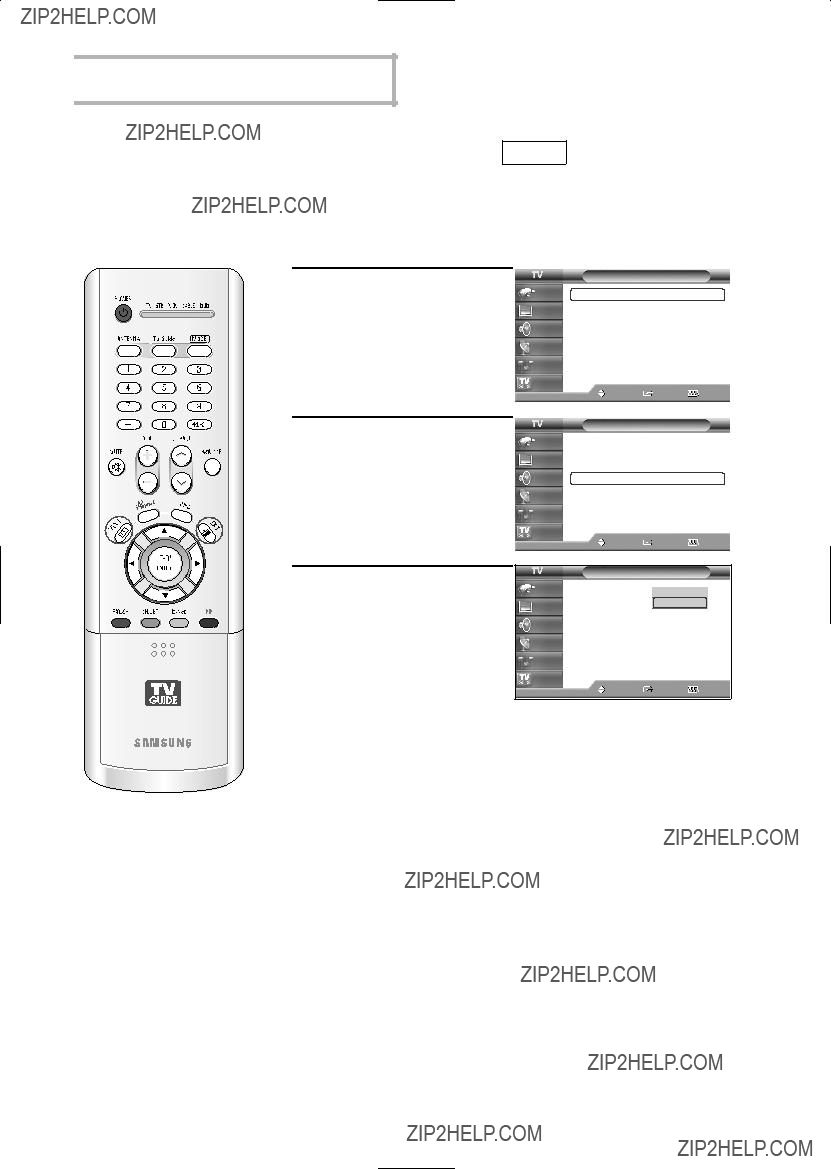
 Special Features
Special Features
Viewing Closed Captions
The Analog Caption function operates in either analog RF channel mode or external signal mode. (Depending on the broadcasting signal, the Analog Caption function may operate on digital channels.)
1 Press the MENU button. Press the ??? or ??? button to select ???Setup???, then press the ENTER button.
2 Press the ??? or ??? button to select ???Caption???, then press the ENTER button.
3 Press the ENTER button to select ???Caption???.
Press the ??? or ??? button to select ???On???, then press the ENTER button.
 English - 96
English - 96

4 Press the ??? or ??? button to select ???Mode???, then press the ENTER button.
Press the ??? or ??? button to select submenu (CC1~CC4 or Text1~Text4) you want, then press the ENTER button.
Press the EXIT button to exit.
NOTES
???The default is ???CC1???.
CC1 : The Primary Synchronous Caption Service. These are captions in the primary language that must be in sync with the sound, preferably matched to a specific frame.
CC2 : The Special NonSynchronous Use Captions. This channel carries data that is intended to augment information carried in the program.
CC3 : Secondary Synchronous Caption Service. Alternate
CC4 : Special
Text1 : First Text Service. This may be various
Text2 : Second Text Service. Additional data, usually not program related.
Text3/Text4 : Third and Fourth Text Services. These data channels should be used only if Text1 and Text2 are not sufficient.
???The Caption feature only works in RF, AV and
???The availability of captions depends on the program being broadcast.
English - 97 

 Special Features
Special Features
Viewing Closed Captions
The Digital Captions function operates on digital channels.
NOTE
??????Caption Options??? are available only when ???Service1~ Service6??? can be selected in ???Mode???.
1 Press the MENU button. Press the ??? or ??? button to select ???Setup???, then press the ENTER button.
2 Press the ??? or ??? button to select ???Caption???, then press the ENTER button.
3 Press the ENTER button to select ???Caption???.
Press the ??? or ??? button to select ???On???, then press the ENTER button.
4 Press the ??? or ??? button to select ???Mode???, then press the ENTER button.
Press the ??? or ??? button to select submenu (Service 1 ~Service 6, CC1~CC4 or Text1~Text4) you want, then press the ENTER button.
5 Press the ??? or ??? button to select ???Caption Options???, then press the ENTER button.
Caption
 English - 98
English - 98

6 Press the ??? or ??? button to select ???Size???, then press the ENTER button.
Press the ??? or ??? button to select one you want, then press the ENTER button.
Set other listed options below using the same method as above.
Press the EXIT button to exit.
Caption Options
NOTE
??? The availability of captions depends on the program being broadcast.
Size
This option consists of ???Default???, ???Small???, ???Standard???, and ???Large???. The default is ???Standard???.
Font Style
This option consists of ???Default???, ???Style0 ~ Style 7???.
You can change the font you want. The default is ???Style 0???.
Foreground Color
This option consists of ???Default???, ???White???, ???Black???, ???Red???, ???Green???, ???Blue???, ???Yellow???, ???Magenta???, and ???Cyan???.
You can change the color of the letter. The default is ???White???.
Background Color
This option consists of ???Default???, ???White???, ???Black???, ???Red???, ???Green???, ???Blue???, ???Yellow???, ???Magenta???, and ???Cyan???. You can change the background color of the caption. The default is ???Black???.
Foreground Opacity
This option consists of ???Default???, ???Transparent???, ???Translucent???, ???Solid???, and ???Flashing???. You can change the opacity of the letter.
Background Opacity
This option consists of ???Default???, ???Transparent???, ???Translucent???, ???Solid???, and ???Flashing???. You can change the background opacity of the caption.
Return to Default
This option sets each of ???Size???, ???Font Style???, ???Foreground Color???, ???Background Color???, ???Foreground Opacity???, and ???Background Opacity??? Color to its default.
Alternate method
Press the CAPTION button on the remote control repeatedly to select ???On??? or ???Off???.
Caption : On
English - 99 
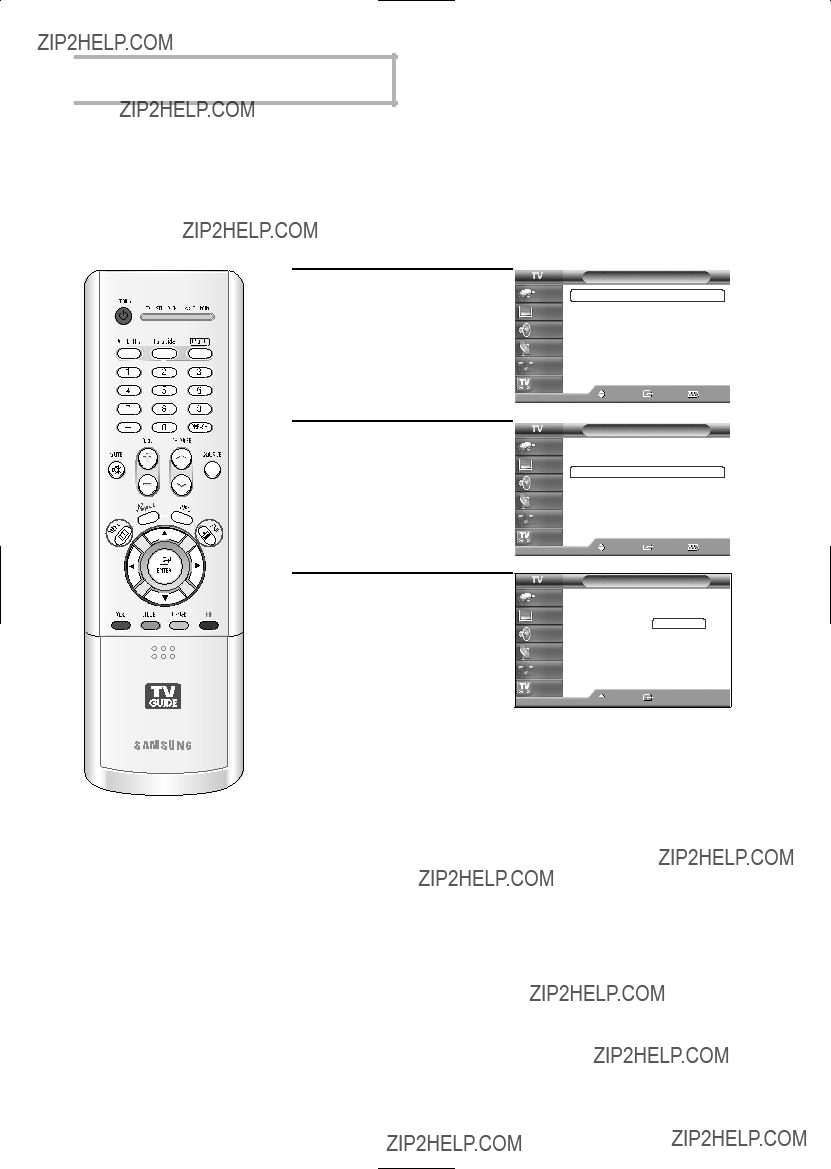
 Special Features
Special Features
Setting the Remote Control Mode
Sets your remote control???s mode to Anynet or
The Anynet functions and the
select ???Setup???, then press the ENTER button.
2 Press the ??? or ??? button to select ???Port Selection???, then press the ENTER button.
3 Press the ??? or ??? button to select ???Anynet??? or
Press the EXIT button to exit.
Setup
Listings
 Move Enter
Move Enter  Return
Return
NOTES
???The default setting for the remote control mode is
???Select the
(Refer to the TV Guide On ScreenTM manual and TV Guide On ScreenTM Quick Setup Sheet for further information on
???To download program listings, the TV Guide On ScreenTM system needs to be able to change channels on your cable box when the TV is not in use. Please connect the supplied
 English - 100
English - 100

Using the CableCARD
This menu works with a CableCARD provided by a local cable service provider.
Prior to accessing this menu, a CableCARD should be connected to the rear panel of the TV.
For detailed connection instructions refer to the ???Connecting CableCARD??? section on page 22 of this manual.
Displaying CableCARD related information
To access information on Status, Pairing, Network Setup of the CableCARD provided by the service provider in CableCARD menu.
1 Press the MENU button. Press the ??? or ??? button to select ???Setup???, then press the ENTER button.
2 Press the ??? or ??? button to select ???CableCARDTM???, then press the ENTER button.
3 Press the EXIT button to exit.
English - 101 
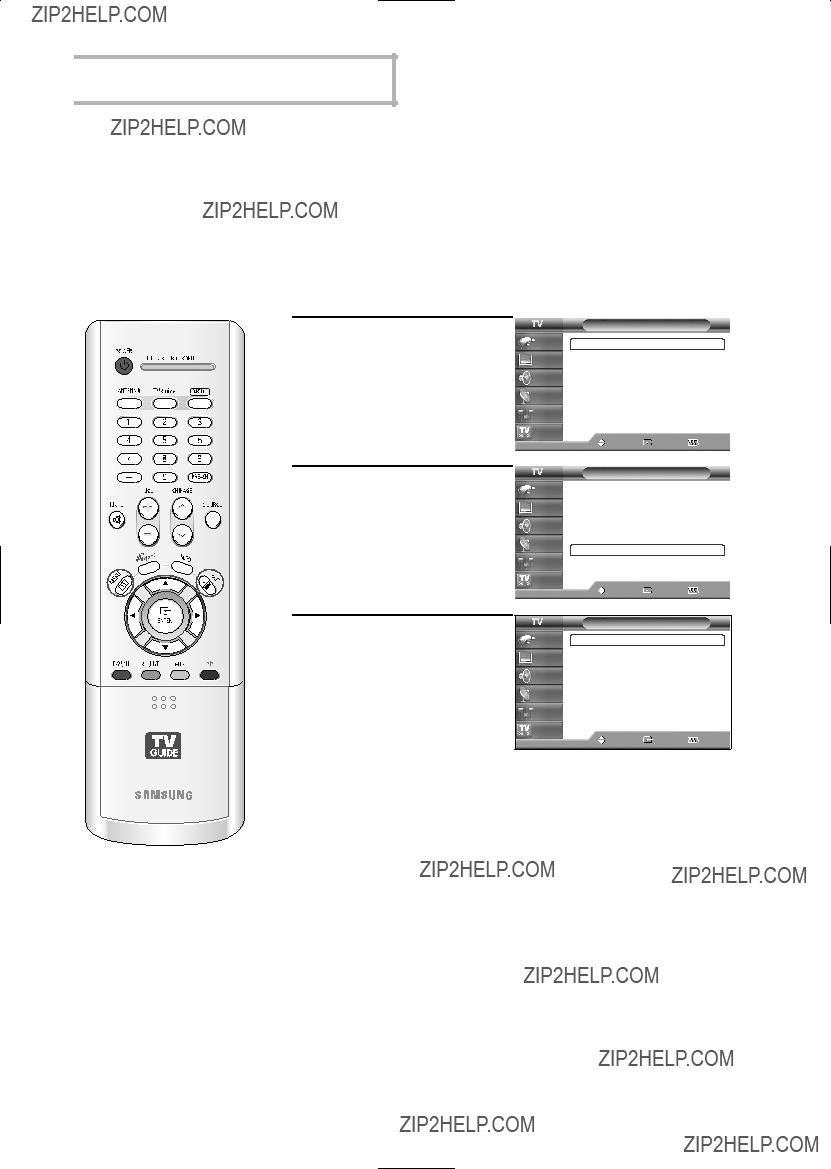
 Special Features
Special Features
Using the CableCARD Setup Function
Sets up relevant CableCARD options.
CableCARD Reset
Resets CableCARD when the channels provided by CableCARD are not available.
1 Press the MENU button. Press the ??? or ??? button to select ???Setup???, then press the ENTER button.
2 Press the ??? or ??? button to select ???CableCARDTM Setup???, then press the ENTER button.
3 Press the ENTER button to select ???CableCARDTM Reset???.
 English - 102
English - 102
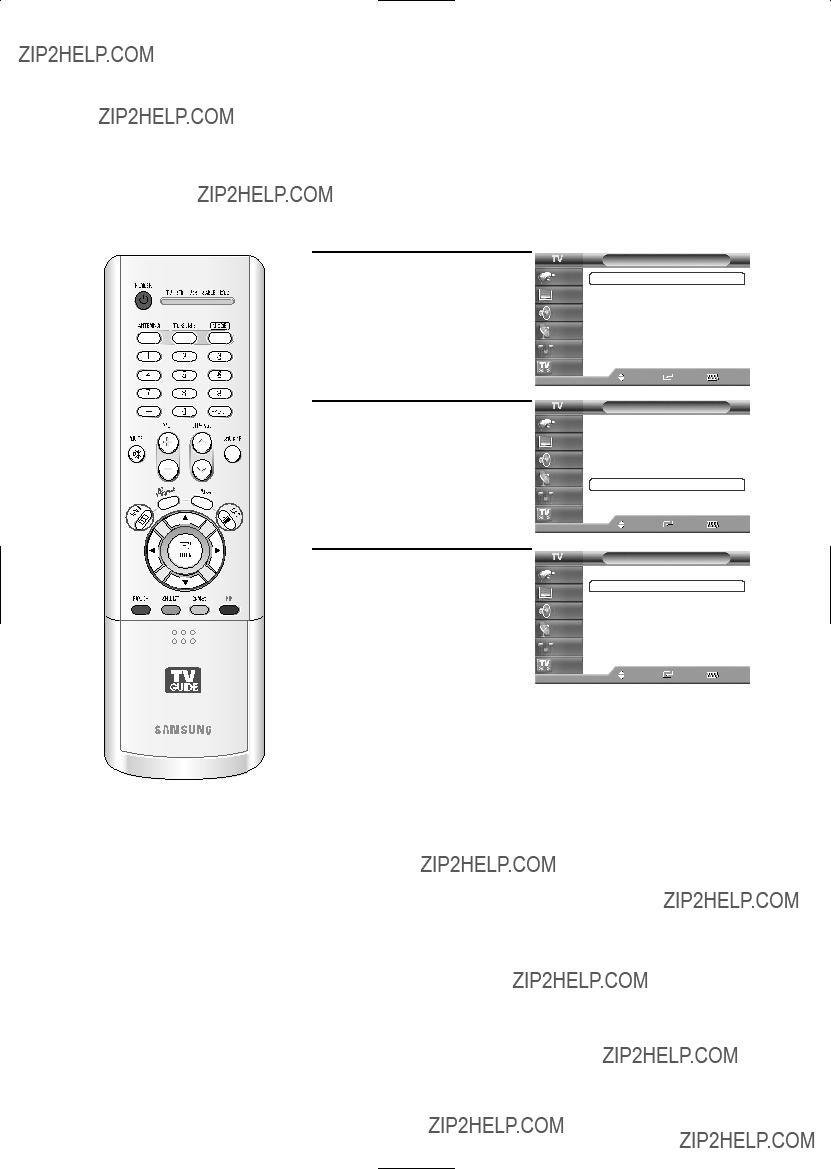
Channel List Reorganization
Deletes and reorganizes the channel list provided by CableCARD.
This feature should be used if you change or upgrade your CableCARD service.
1 Press the MENU button. Press the ??? or ??? button to select ???Setup???, then press the ENTER button.
2 Press the ??? or ??? button to select ???CableCARDTM Setup???, then press the ENTER button.
3 Press the ENTER button to select ???Channel List Reorganization???.
English - 103 
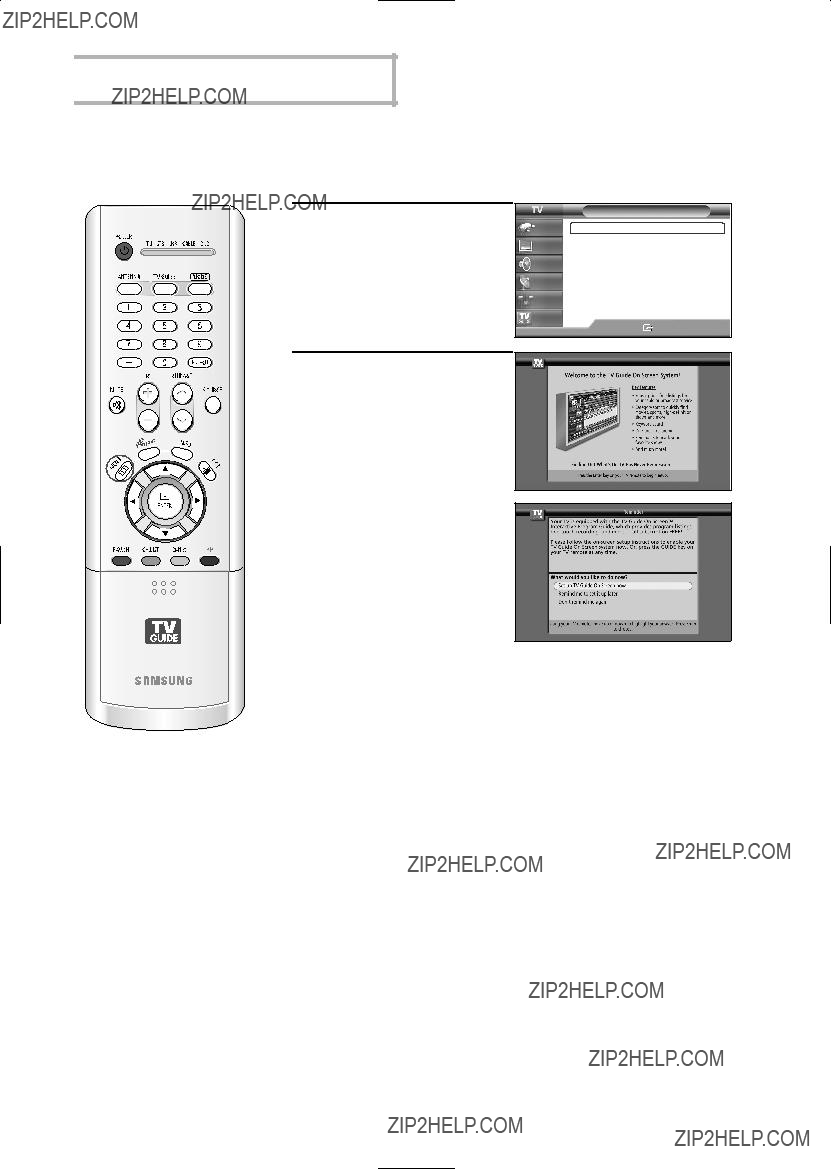
 Special Features
Special Features
Using TV Guide On ScreenTM
1 Press the MENU button. Press the ??? or ??? button to select ???Listings???, then press the ENTER button.
2 Press the ENTER button to select ???TV Guide On ScreenTM???.
??? If you decide not to setup the Guide now, this reminder screen will appear each time you power On the TV (except if you selected ???Don???t remind me again???).
NOTES
Listings
Input TV Guide On ScreenTM
Picture
Sound
Channel
Setup
Listings
Enter  Return
Return
???In order for the Guide to receive channel lineup & listings successfully, ???Auto Program??? must be performed at least once, prior to powering off your TV. The Guide displays the very channels that are programmed during ???Auto Program???.
???Refer to TV Guide On ScreenTM manual for details.
 English - 104
English - 104

Using the

 Using the
Using the
What???s
This refers to a home network consisting of devices supporting
The
The main feature of the
How to connect compatible IEEE1394 Devices
Connecting compatible IEEE1394 devices is simple using this TV equipped with IEEE1394.
A secure digital interface is provided to other digital home entertainment units, such as a DTV, a
Select the
Digital VCR
NOTES
???To access
???The IEEE1394 interface is equipped with a copy protection standard called Digital Transmission Content Protection (DTCP).
???The name of 1394 Jack may be different according to their manufacturer (i.e., DTV LINK or i.LINK).
???The supported video format is
For audio, Dolby Digital and MPEG Digital Audio are supported, other digital audio formats (e.g. MP3, DTS) are not supported.
???Because IEEE1394 is an evolving technology, it is possible that some or all of the connectivity features of a device you connect to the TV through the IEEE1394 port may not operate.
 English - 106
English - 106
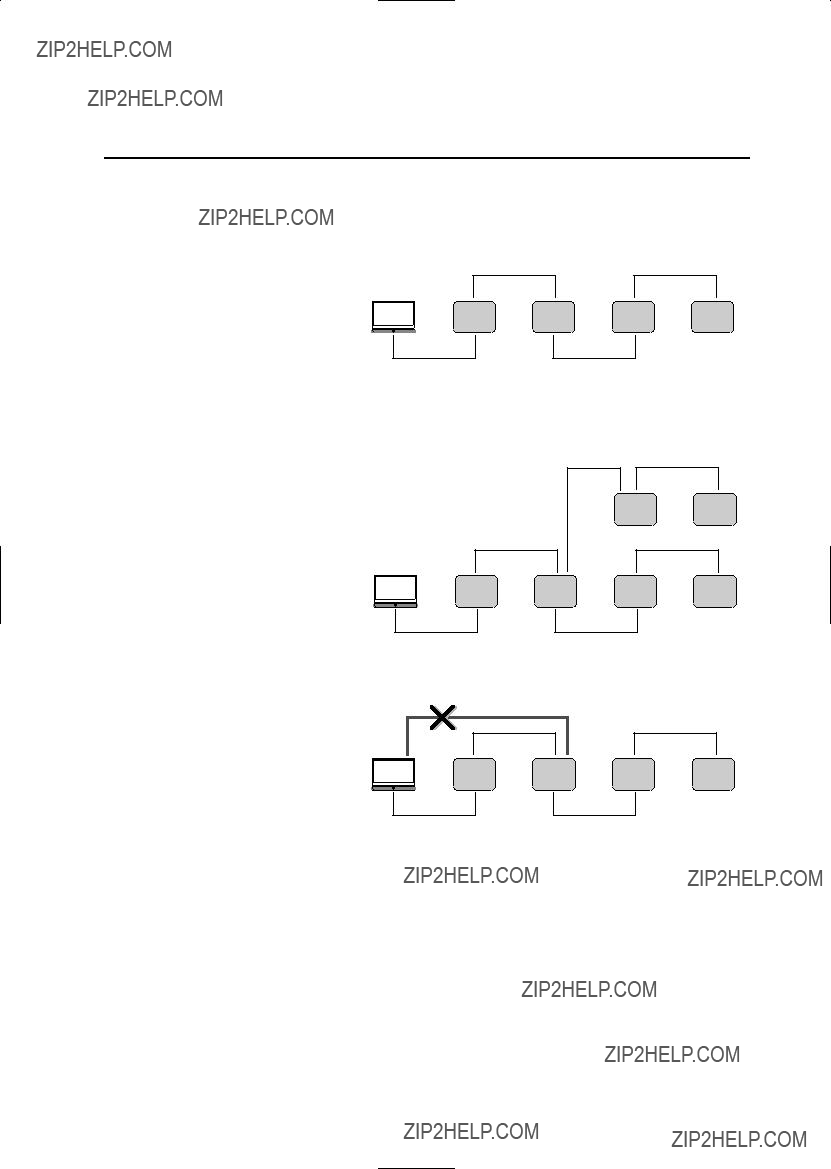
When Connecting
The last device in the chain may not be looped back to the TV as the TV may not be able to 1 work with the other devices.
To connect two or more
Maximum 10
Do not connect
IEEE1394 cable
NOTE
??? IEEE1394 cables longer than 14.76 feet (177.16 inches) should not be used between devices.
English - 107 

 Using the
Using the
Connection Options
There are two different connection options for connecting D
The Direct
More IEEE1394 devices can be added to the chain as needed. Each video device can be viewed on the TV???s
DTV STB
Digital VCR
The Hub Connection Option
Other 1394 Device
 English - 108
English - 108

Two different types of connectors are used for IEEE1394 terminals and cables, a
The
The
It is not possible to directly connect a
Connecting a
English - 109 

 Using the
Using the
Selecting a
Prior to viewing an IEEE1394 device, it first needs to be selected in the
2 Press the
???The TV and all other devices connected on the
???The ???UNCONTROLLABLE??? listed in the device list are devices not supported by the TV, and cannot be controlled with the TV remote control or the
???The device list is in the order of DTV, STB, AVHDD, DVHS, Camcorder and UNCONTROLLABLE. If there are multiple devices of the same type, the devices will be listed in ascending order of the manufacturer name with Samsung first as the exception. If there are multiple devices of the same type and they are manufactured by the same company, they will be listed in the order
of their serial number.
Select a connected
???It is possible to connect a
To select a device, press the ENTER button. 4 Then display the
and operate the selected device.
???At this time, the screen changes to the picture from the selected device.
 English - 110
English - 110

Follow the instructions below to activate
1 Press the MENU button.
Press the ENTER button to select ???Input???.
2 Press the ??? or ??? button to select
???The TV and all other devices, connected on the
???This is also available using the
3 Press the ??? or ??? button to select a
English - 111 

 Using the
Using the
The
Select an IEEE1394 from the
1 Press the
Press the ??? or ??? button to select a 2
Press the ENTER button.
???The
Use the ???, ???, ??, ??? buttons on the remote 3 control to move through the options (see next
page) available in the
4 Press the ENTER button to select an option.
To view the IEEE1394 device in FULL SCREEN, 5 press the EXIT button on the remote control.
???To exit
Copy information
 English - 112
English - 112

NOTES
???Press the ???, ???, ??, ??? buttons on the remote control to select a control panel button and press the ENTER button on the remote control.
???Depending on the device being controlled, not all options on the
???The selected IEEE1394 device and its functions can be controlled through the equivalent buttons on the TV???s remote control.
???Not all functions are supported for all IEEE1394 devices.
???It is possible to use direct hot keys on the remote control (rewind, stop, play/pause, fast forward) to control external devices.
English - 113 

 Using the
Using the
Operating Tips
1)When the screen is switched to the TV program.
-When you select the first button, the TV button, in the Device List, it switches to the TV program.
-Although you have selected another device from the Device List, if detecting a video signal from the device fails, the ???Connection failed??? message appears and the screen automatically switches to the TV program.
-When the 1394 connection to the selected device is disconnected, the screen automatically switches to the TV program.
2)AVHDD, DVHS and camcorders automatically stop when you select another device while watching one of the devices.
3)Although some devices are displayed in the Device List, ???UNCONTROLLABLE??? may be displayed for some devices. This may happen when reading the device information has failed or the device does not contain the device information.
4)Some devices may not be recognized and may be disconnected from the 1394 connection when they are turned off.
5)When connecting another TV, the TV may transmit Digital TS which appears in the TV or another picture (e.g. Only RF may be transmitted, although DVHS is being displayed on the screen) depending on the TV specifications. (e.g. A Hurricane TV only transmits RF).
6)When connected to another STB, some STB???s may not be displayed in the Device List due to device specifications or defects when multiple devices are connected.
Even if the device is displayed in the Device List, the connection to the device may fail. In this case, you have to discover which device is defective by removing the devices one by one.
7)When connected to the AVHDD
-To rotate the AVHDD disc, there may a time delay.
-Some AVHDD???s may provide two playbacks or two recordings simultaneously. In this case, there may be two Play icons in the Program List and 2 AVHDD buttons in the Target List.
-If you copy a program from the Program List, the selected AVHDD program is played on the TV screen and recorded using the device selected from the Target List.
Even if the program reaches its end, the recording device does not stop automatically.
-Some AVHDD???s may display the wrong program information after recording, depending on the situation.
-If AVHDD is recording, the program is automatically played which is currently being recorded, when it is selected from the Device List. (PVR function)
8)When connected to DVHS
-Some devices support an automatic connect function
9)When connected to a camcorder
-Depending on the camcorder mode of either Tape Mode or Camera Mode, the control panel changes. If the camcorder turns off the power (power saving mode), the camcorder may disappear from the Device List.
10)When multiple devices are connected, some devices may appear and then disappear periodically in the Device List. This is because some devices malfunction when multiple devices are connected.
In this case, you have to discover and remove the defective device from the connection by removing the devices one by one.
 English - 114
English - 114

11)When multiple devices are connected, the response time may be relatively long when selecting a device. This may happen when there is a device(s) that malfunctions and degrades the 1394 connection speed when multiple devices are connected.
In this case, you have to discover and remove the defective device from the connection by removing the devices one by one.
12)Copy Protection
-You can record a
-Although you cannot record a
13)When multiple devices are connected, and a device malfunctions while playing DVHS or AVHDD, the user may experience discontinuous screen play.
14)When playing and recording a program simultaneously using AVHDD, and the program is copy protected, the program may not play depending on whether the AVHDD device supports simultaneous copy protection.
Recording Tips
1)Recording using the Target List while also watching the screen being recorded.
-Check that the AVHDD and DVHS devices are connected.
-Select a source device to be recorded and press the Target button.
-Select a device to be recorded from the Target List.
2)Recording a program in the Program List of AVHDD using another device.
-Select an AVHDD program to be recorded from the Program List and press Copy.
-Select the target device from the Target List.
NOTES
???In this case, the selected program is automatically played and displayed on the TV screen and the target device automatically starts recording.
???Controlling a device through another device or through a manual operation may cause a malfunction when controlling a device through the TV. When copying a program, the recording will not stop automatically when the program reaches its end.
???Although the recordings of the corresponding devices necessary for a Copy operation will be performed regardless of the copy protection, you will not be able to watch the copied program if the program is copy protected.
???When recording an HD program on cable TV or from satellite, programs on some channels may not be recorded if the program exceeds the limit of the allowable range of recording devices such as
???If a recording is in process and another command is issued while the ???Recording...???
Tips on stopping recording
1)In general, you can instantly evaluate the currently recording device through the Target List. If you select a device that you wish to stop, a message appears asking if you really want to stop recording.
2)For DVHS. If you select a recording DVHS from the Device List, a message appears asking if you really want to stop recording.
3)For AVHDD, if the program currently being recorded is selected, you can stop the recording using the Recording stop button.
NOTE
???Controlling a device through another device or through a manual operation may cause a malfunction when controlling a device through the TV.
English - 115 

 Using the
Using the
Troubleshooting
The device is displayed as being ???UNCONTROLLABLE???.
Only DTVs, STBs, AVHDDs, DVHSs and MPEG camcorder IEEE 1394 devices are controllable. Other devices will display ???UNCONTROLLABLE??? in the device list.
Some supported devices may display as ???UNCONTROLLABLE??? due to an initialization error.
???If a device is supported but is displayed as ???UNCONTROLLABLE???, reconnect the 1394 cable. If this does not work, this is because the information about the device is unreadable due to an internal error.
A connected device is not displayed in the device list.
Since a device, which has experienced an error during initialization may malfunction and affect the operation of other connected devices, other devices may not be displayed in the list.
???Disconnect and reconnect the1394 cable.
???Remove a device which does not guarantee compatibility when multiple devices are connected.
???Check the connection with IEEE 1394 cable.??? message appears.
This message appears when there is a problem with the connected device or the 1394 cable. Initialization might fail when multiple devices are connected due to limitations of some connected devices.
???Check that the 1394 cable is making a loop and reconnect the 1394 cable.
Check that cables are correctly connected to all connected devices.
This message may appear due to an operating error of the 1394 port of a particular device.
 English - 116
English - 116
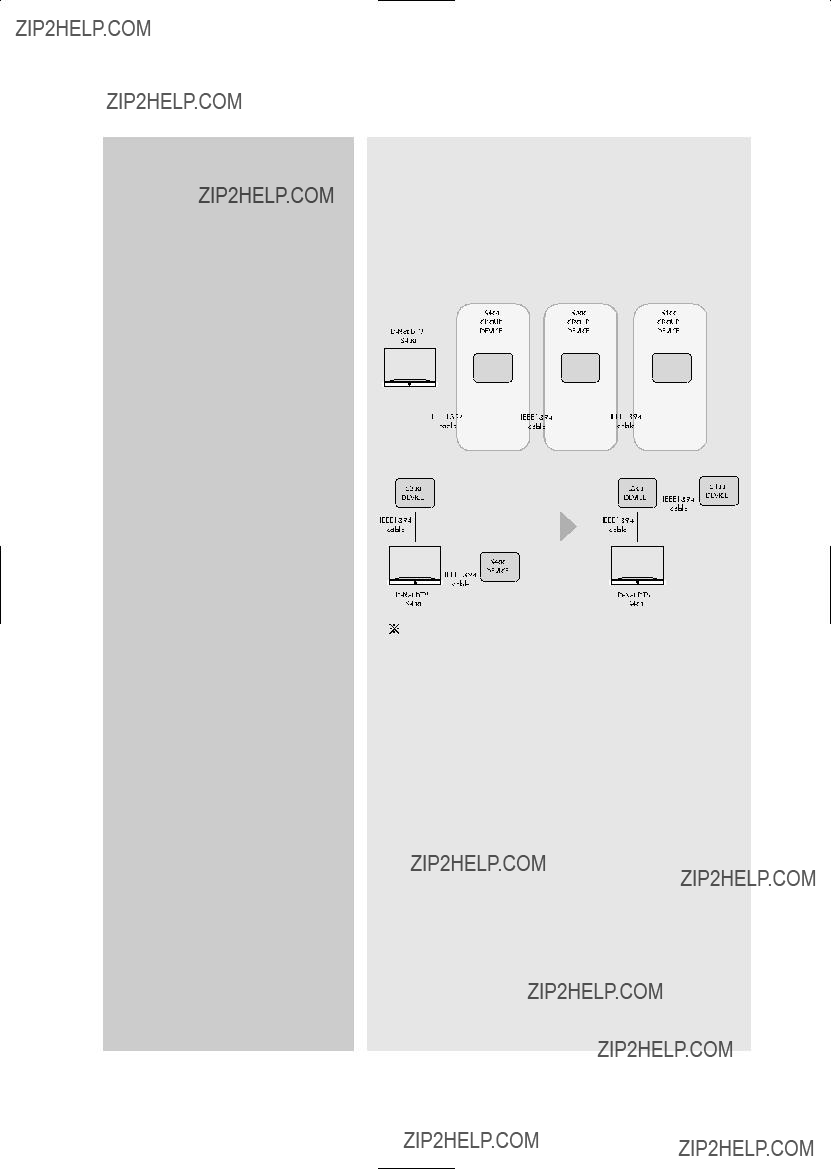
English - 117 

 Using the
Using the
No picture on the screen after selecting a device
Check if the current mode for DTV and STB is set to analog by mistake. For AVHDD, check if the played content reaches to the end. (Select the item from the content list again.) For DVHS, check if a
DV format, no picture will be displayed on the screen.
???The connected device is unavailable to perform this function for temporary problems.??? message appears.
This message appears when the selected function is not supported by the relevant device or the relevant device cannot execute the selected function.
Most STB???s, DTV???s and camcorders do not support the power on/off command. This message may appear when you issue the power command
for these devices. This message also appears when the command is supported but the relevant device cannot follow the command.
Retry after checking the current mode of the relevant device.
 English - 118
English - 118

This device is unavailable for
This message appears if you have connected a 1394 device or equipment other than a supported device (DVHS, DTV, STB, AVHDD, Camcorder), or if the connected device does not support the AVC defined in the 1394 specifications, even if the device is a supported device, when you have selected the device to use it.
No space left on disc.
This message appears if the AVHDD has no space to record.
English - 119 

SAMSUNG

PC Display
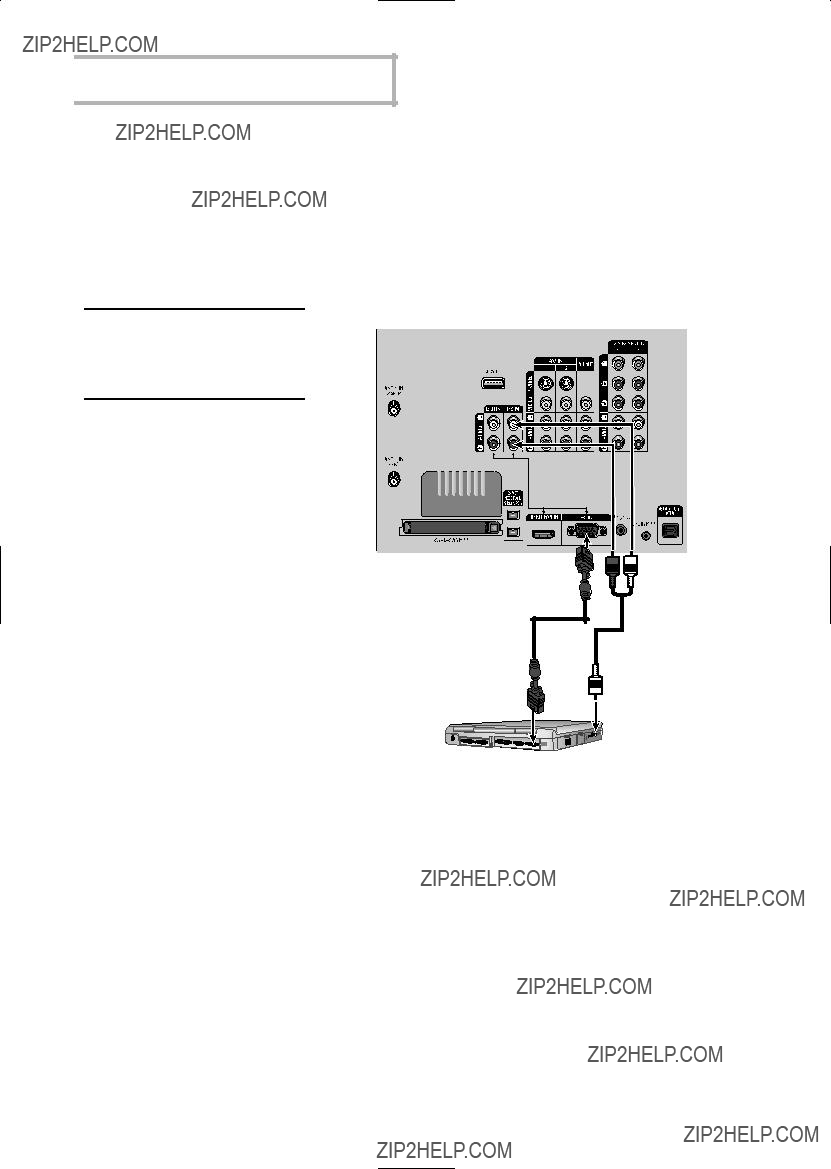
 PC Display
PC Display
Using Your TV as a Computer (PC) Display
How to Connect Your PC to the TV
This figure shows the Standard
Connecting a PC (15p
15Pin
Audio Cable
PC
 English - 122
English - 122

Setting up Your PC Software (Windows only)
The Windows
1.Right click the mouse on the Windows Desktop, then click on Properties. The Display
2Click on Settings, then set the Display Mode with reference to the Display Modes Table. You do not need to change the Colors settings.
3Click on Advanced. A new settings dialog box will be displayed.
4Click on the Monitor tab, then set the Screen Refresh Rate with reference to the Display Modes Table. Set the Vertical Frequency and Horizontal Frequency individually if you can do so instead of setting the Screen Refresh Rate.
5Press the OK button, close the window, then press the OK button on the Display Registration Information window. Automatic
6Shutdown the PC, and connect it to your TV.
*The actual screens on your PC may look different, depending on your particular version of Windows and the type of your PC.
*When you use your TV as a PC monitor, it supports Colors up to 32 bits.
*In this case, the display on the TV may look different depending on your particular version of Windows or the PC manufacturer.
*When connecting a PC, you must set it to the display settings that are supported by the TV. Otherwise, the message Out of input range will be displayed.
2
3
4
5
continued...
English - 123 

 PC Display
PC Display
Display Modes
NOTES
???The PC text quality is optimum in XGA mode (1024 x 768@60Hz).
???Both screen position and size will vary, depending on the type of PC monitor and its resolution. The table above shows all of the display modes that are supported:
*The interlace mode is not supported.
*The TV will operate abnormally if a
???When this TV is used as a PC display,
???Your PC display screen might appear different, depending on the manufacturer (and depending on your particular version of Windows). Check your PC instruction book for information about connect- ing your PC to a TV
???Same modes as PC are supported for the signal input to the DVI jack. Only a separate sync signal is supported.
 English - 124
English - 124

Adjusting the Picture Quality
The purpose of picture quality adjustment is to remove or reduce picture noise. If the noise is not removed by fine tuning alone, then do the frequency adjustments to the utmost and fine tune again. After the noise has been reduced,
1 Press the SOURCE button to select ???PC???.
NOTE
???This feature may change the width of the image. If necessary, adjust the position to center.
2 Press the MENU button. Press the ??? or ??? button to select ???Setup???, then press the ENTER button.
3 Press the ??? or ??? button to select ???PC???, then press the ENTER button.
4 Press the ??? or ??? button to select ???Image Lock???, then press the ENTER button.
5 Press the ??? or ??? button to select ???Coarse??? or ???Fine???, then press the ENTER button.
???You can also select these options (Coarse, or Fine) by pressing the ??? or ??? button.
6 Pressing the ?? or ??? button to remove the picture noise.
Press the EXIT button to exit.
English - 125 
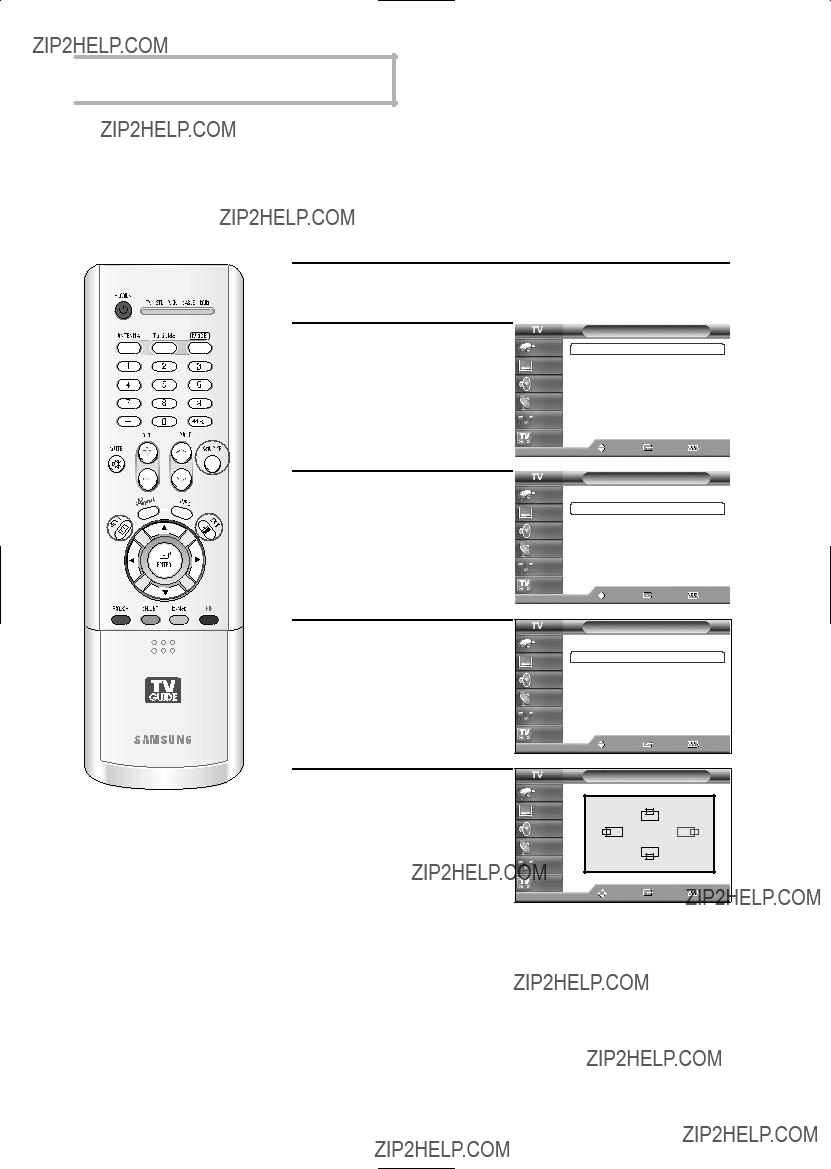
 PC Display
PC Display
Changing the Picture Position
After connecting the TV to your PC, adjust the position of picture if it is not
1 Press the SOURCE button to select ???PC???.
2 Press the MENU button. Press the ??? or ??? button to select ???Setup???, then press the ENTER button.
3 Press the ??? or ??? button to select ???PC???, then press the ENTER button.
4 Press the ??? or ??? button to select ???Position???, then press the ENTER button.
5 Adjust the position of picture by pressing the ???/???/??/??? button.
Press the EXIT button to exit.
 English - 126
English - 126
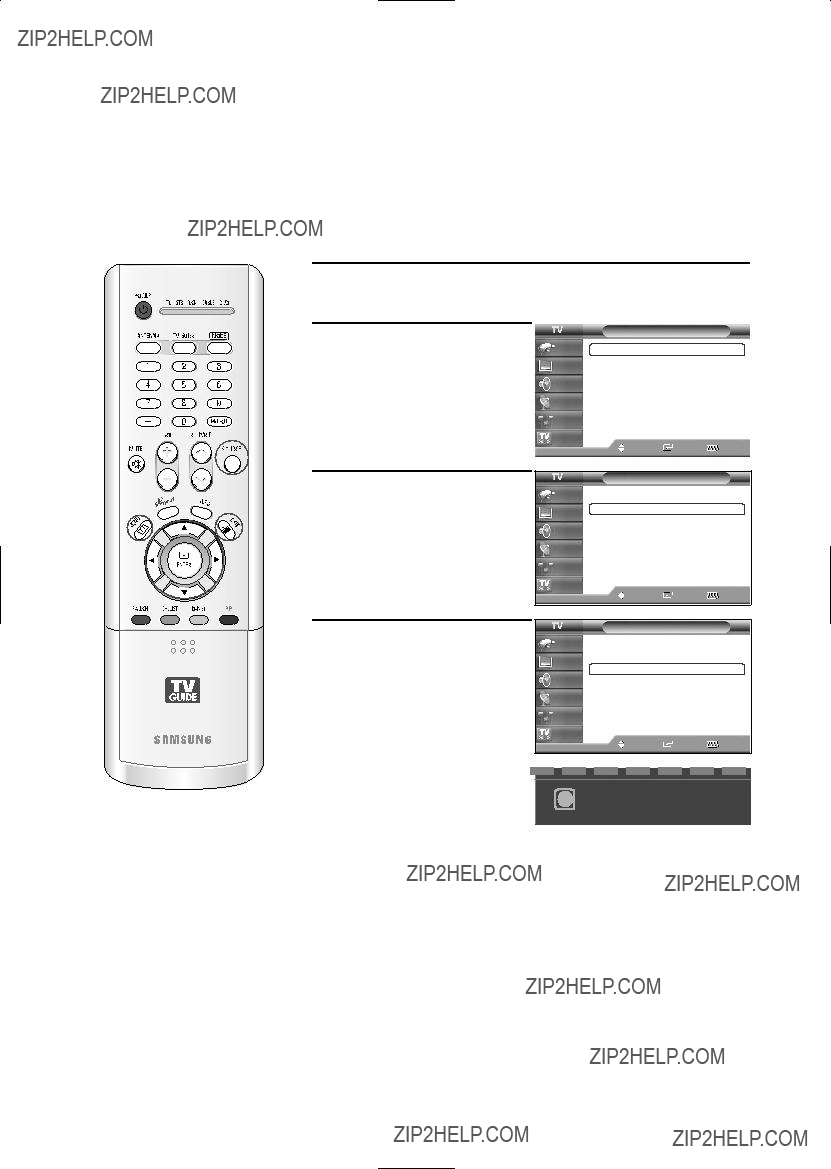
Adjusting the Picture Quality and Position Automatically
This feature allows the TV to
1 Press the SOURCE button to select ???PC???.
2 Press the MENU button. Press the ??? or ??? button to select ???Setup???, then press the ENTER button.
3 Press the ??? or ??? button to select ???PC???, then press the ENTER button.
4 Press the ??? or ??? button to select ???Auto Adjustment???, then press the ENTER button. The picture quality and position are automatically adjusted, and the picture returns to original view about a few seconds later.
Press the EXIT button to exit.
English - 127 
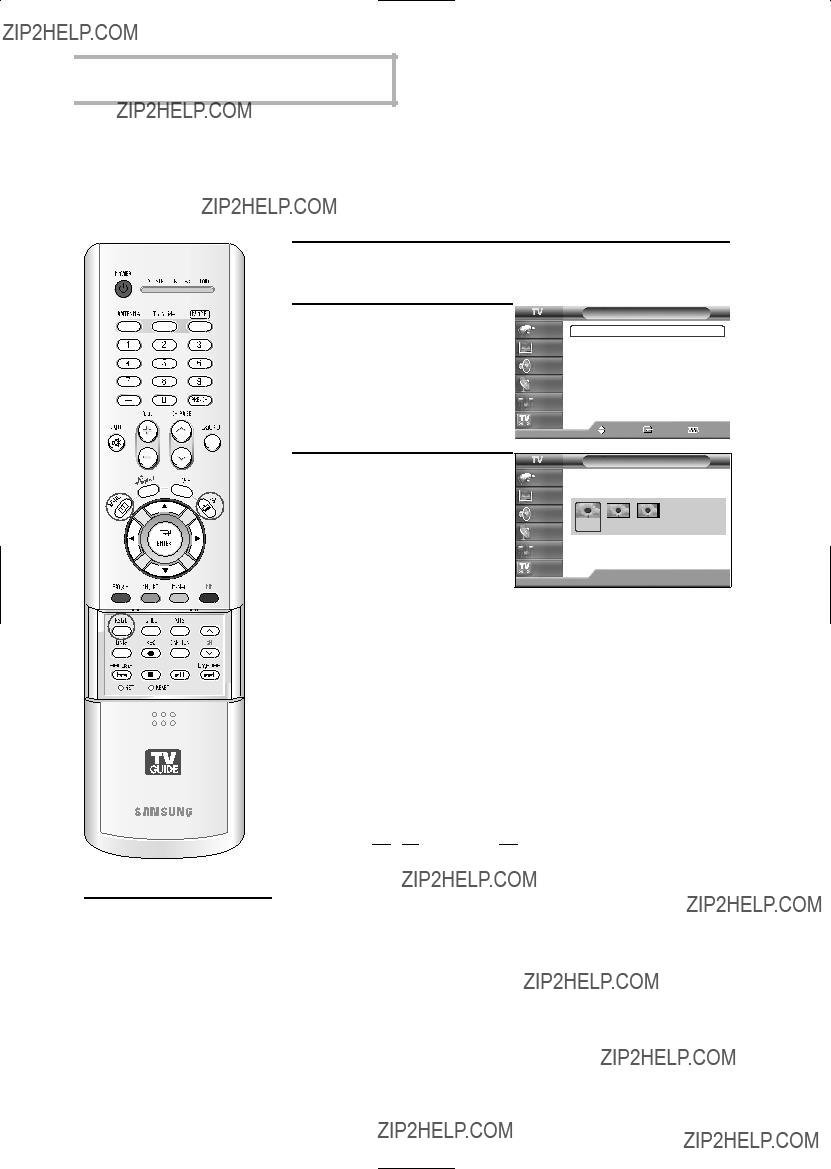
 PC Display
PC Display
Changing the Picture Size (PC Mode)
You can select the picture size which best corresponds to your viewing requirements.
1 Press the SOURCE button to select ???PC???.
2 Press the MENU button. Press the ??? or ??? button to select ???Picture???, then press the ENTER button.
Press the ??? or ??? button to select ???Size???, then press the ENTER button.
3 Press the ?? or ??? button to select the screen format you want, then press the ENTER button.
Press the EXIT button to exit.
Size
Input
Picture
Sound
WideTV WidePC 4:3
Channel
Setup
Listings
 Move
Move  Enter
Enter  Return
Return
Alternate method
Press the P.SIZE button on the remote control repeatedly to change the picture Size.
NOTES
???The ???WidePC??? and ???4:3??? modes are recommended for the PC mode.
???In VGA (640x480), SVGA (800x600) and XGA(1024x768) modes, the ???Wide TV???, ???Wide PC??? and ???4:3??? modes are available.
???In XGA (1024x768) mode, the ???WideTV??? mode is available.
??????WideTV???: Scales the picture to the size of the TV screen regardless of the aspect ratio of the input source.
??????4:3???: Displays the picture as it is without changing the aspect ratio of input source.
??????WidePC???: Scales the picture to 92% of the TV screen, regardless of the aspect ratio of the input source. The picture
position (  ,
, 
 ) and size (
) and size ( 

 ) adjustment are available by pressing the ???/???/??/??? button.
) adjustment are available by pressing the ???/???/??/??? button.
 English - 128
English - 128
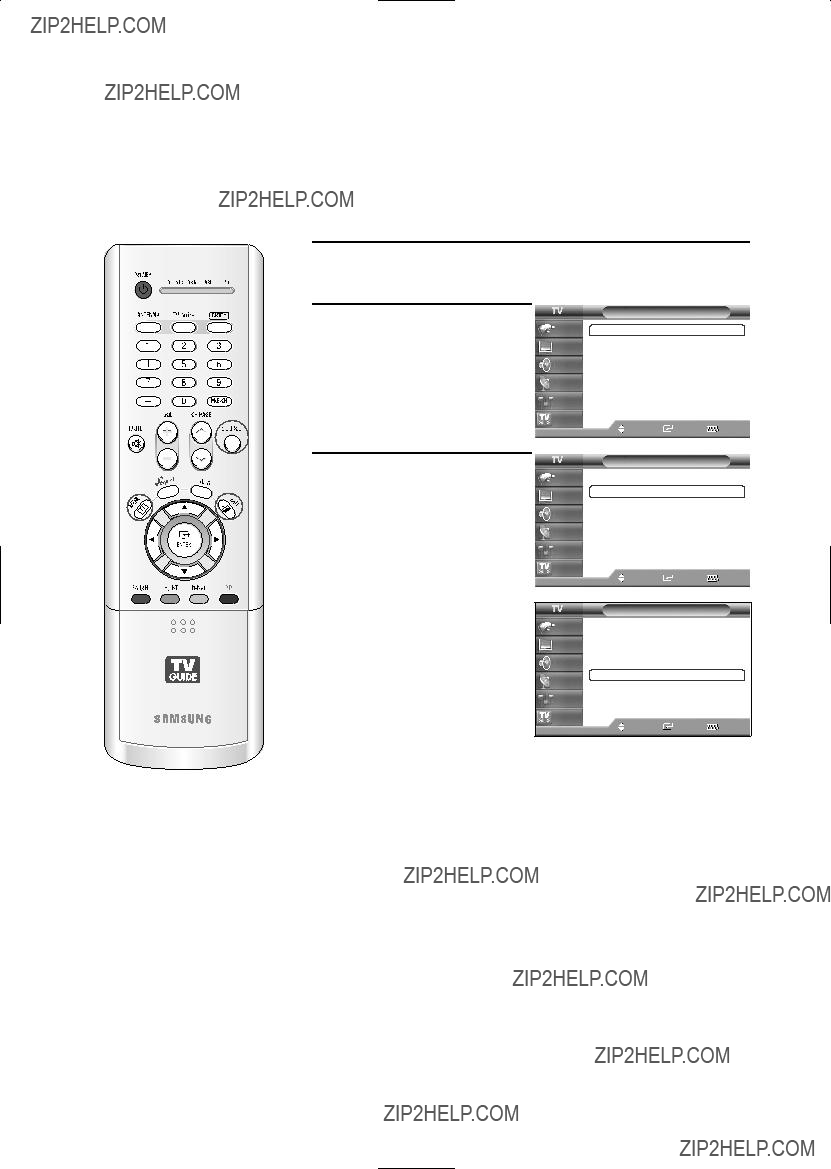
Viewing the Current Resolution
You can get the resolution information of your PC.
1 Press the SOURCE button to select ???PC???.
2 Press the MENU button. Press the ??? or ??? button to select ???Setup???, then press the ENTER button.
3 Press the ??? or ??? button to select ???PC???, then press the ENTER button.
The resolution information is displayed on the screen.
NOTE
??? To change the resolution, see pages 123~124.
English - 129 

 PC Display
PC Display
Initializing the Picture Settings
You can replace all picture settings with the factory default values.
1 Press the SOURCE button to select ???PC???.
2 Press the MENU button. Press the ??? or ??? button to select ???Setup???, then press the ENTER button.
3 Press the ??? or ??? button to select ???PC???, then press the ENTER button.
4 Press the ??? or ??? button to select ???Image Reset???, then press the ENTER button.
The picture settings are replaced with the factory default values.
Press the EXIT button to exit.
 English - 130
English - 130

Appendix

 Appendix
Appendix
PIP Settings
O : PIP and swap operate
??? : PIP operate and swap doesn???t operate
X : PIP doesn???t operate
Replacing the Lamp
???Why do I need to replace the lamp?
The lamp used in a DLP TV has a limited lifespan. For the best screen quality it needs to be replaced periodically. After replacing the lamp, the screen quality will be bright and clear as new.
???When do I need to replace it?
It should be replaced when the screen becomes darker, less clear or when all three LEDs on the front (TIMER, LAMP, & STAND BY/TEMP) are flashing.
???Check before lamp replacement
1.The lamp must be the same code number and type.
2.The lamp type is indicated on the right side of the TV. It is also indicated on the lamp case.
3.After checking the code number for the lamp, give the code number to the store where you purchased the TV or to a Samsung Service center.
???Caution
1.Replace with the correct code numbered lamp
2.Turn the power off and wait for 30 minutes before replacing the lamp as it will be hot.
3.Do not touch the glass part of the lamp with your bare hands nor insert any foreign object inside the cover as it may cause poor screen quality, electric shock or fire.
4.Do not place the old lamp near flammable objects or within the reach of children.
5.Be sure to connect this TV directly to an AC wall outlet. If the TV???s AC plug is connected to a cable box or other source, it will not allow for proper cool down time.
 English - 132
English - 132

??? For replacement, you will need a
Unplug TV, then use a 1 screwdriver to remove the
screws.
2 Remove the Lamp cover.
Remove the screw securing 3 the Lamp by using a
screwdriver.
Separate the Lamp from the 4 engine by holding the handle
and pulling it out.
To reinstall the Lamp, follow 5 these steps in reverse order.
NOTES
???Be sure the replacement Lamp is the same type.
???After replacing the lamp, align the lamp cover with the groove and secure the screws.
???The TV will not turn on if the lamp cover is not correctly closed (as this will activate the protective circuit).
English - 133 

 Appendix
Appendix
Troubleshooting
If the TV seems to have a problem, first try this list of possible problems and solutions. If none of these troubleshooting tips apply, then call your nearest Samsung authorized service center.
???The display panel used for the DLP TV is composed of many tiny pixels. These pixels may occasionally appear on the screen.
 English - 134
English - 134

Cleaning and Maintaining Your TV
With proper care, your TV will give you many years of service. Please follow these guidelines to get the maximum performance from your TV.
Placement
???Do not put the TV near extremely hot, cold, humid or dusty places.
???Do not place the TV near appliances with electric motors that create magnetic fields, such as vacuum cleaners.
???Keep the ventilation openings clear; do not place the TV on a soft surface, such as cloth or paper.
???Place the TV in a vertical position only.
Liquids
??? Do not handle liquids near or on the TV. Liquids that spill into it can cause serious damage.
Cabinet
???Never open the cabinet or touch the parts inside.
???Wipe your TV with a clean, dry cloth. Never use water, cleaning fluids, wax, or chemicals.
???Do not put heavy objects on top of the cabinet.
???This DLP TV projects the image onto a large screen by applying an optical system.
If you place the TV set face down, it might cause a problem because dirt, or some other contaminant may become attached to the inside of the TV set.
Temperature
???If your TV is suddenly moved from a cold to a warm place, unplug the power cord, and allow at least two hours for moisture that may have formed inside the unit to dry completely.
Using Your TV in Another Country
If you plan to take your TV with you to a foreign country, please be aware of the different television systems that are in use around the world. A TV designed for one system may not work properly with another system due to differences in the TV channel frequencies.
Specifications
English - 135 

Samsung Electronics America
Service Division
400 Valley Road, Suite 201 Mount Arlington, NJ 07856 www.samsung.com
Samsung Electronics Canada Inc.
Samsung Customer Care
55 Standish Court Mississauga, Ontario L5R 4B2 www.samsung.ca